POTA Activation #58: A New West Virginia Park En Route to Hamvention with Gersohn (WV) (5/17/2023)
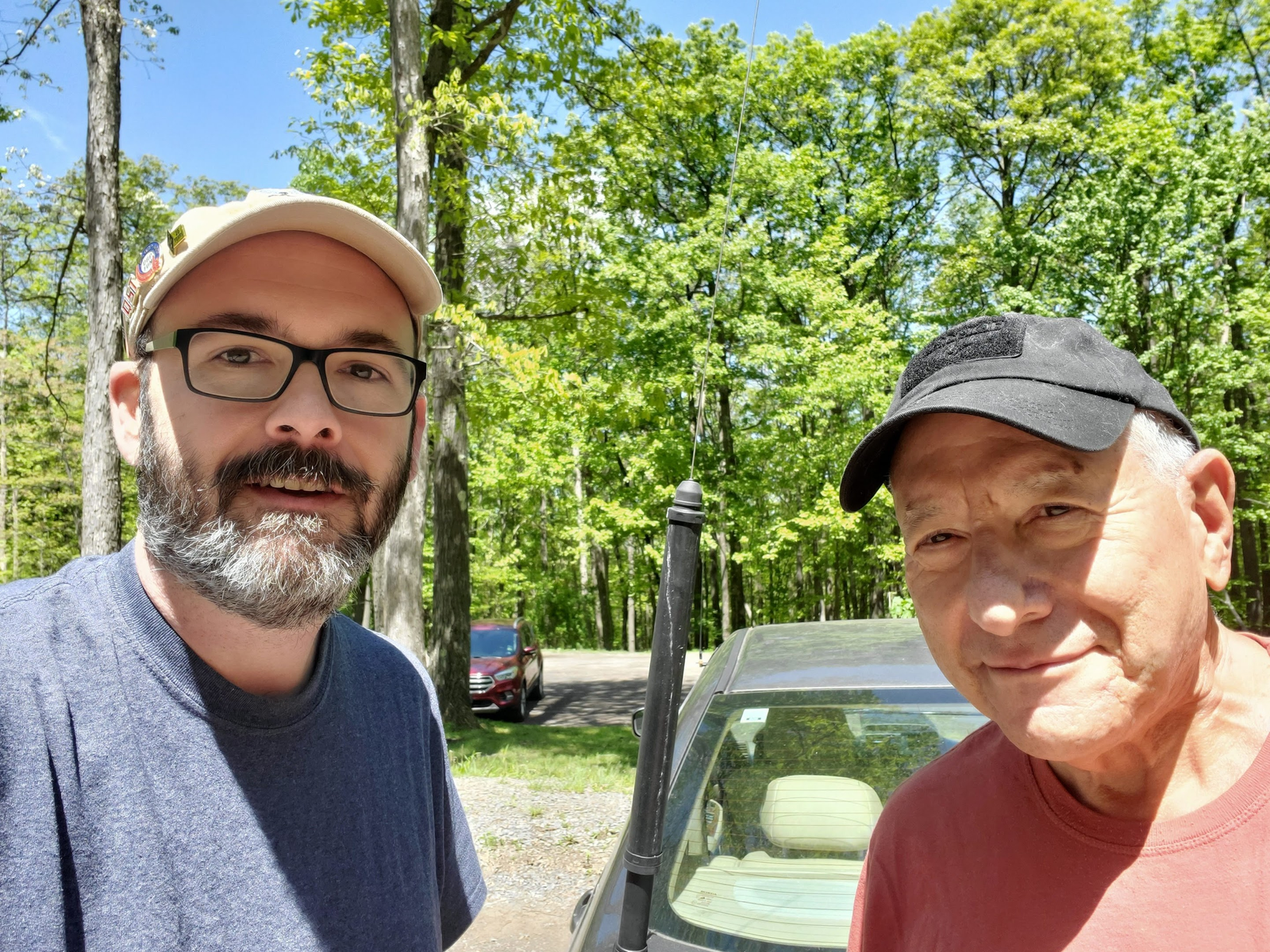
My buddy Gersohn and I decided that this was the year to make the trek out to the QRP ARCI Four Days in May (FDIM) conference and Dayton Hamvention. FDIM is the premier conference for QRP (low power) Amateur Radio Operators, with a focus on building radios, accessories, and sharing knowledge. Attending the conference was somewhat of a bucket list item of mine, so I was excited when the stars aligned and I was able to make the trek out to Fairborn, Ohio to attend. I was even more excited when upon mentioning it to my buddy Gersohn, KO4IUK, he was interested in joining me. FDIM's big day is Thursday with the seminars, but there are also evening events on Friday and Saturday. Dayton Hamvention runs from Friday-Sunday, so you can easily attend both. So, as you can imagine, our thoughts immediately went to ways we could get activations in on the route to and from the convention. I planned a route and found a few parks along the way, but unbeknownst to me, Google Maps had different ideas and it took us on another route out to Ohio. I only realized this after we were past the point of no return, so we quickly found a park in West Virginia that was right off our route (less than a mile off the Interstate) and decided to do a quick mobile activation.
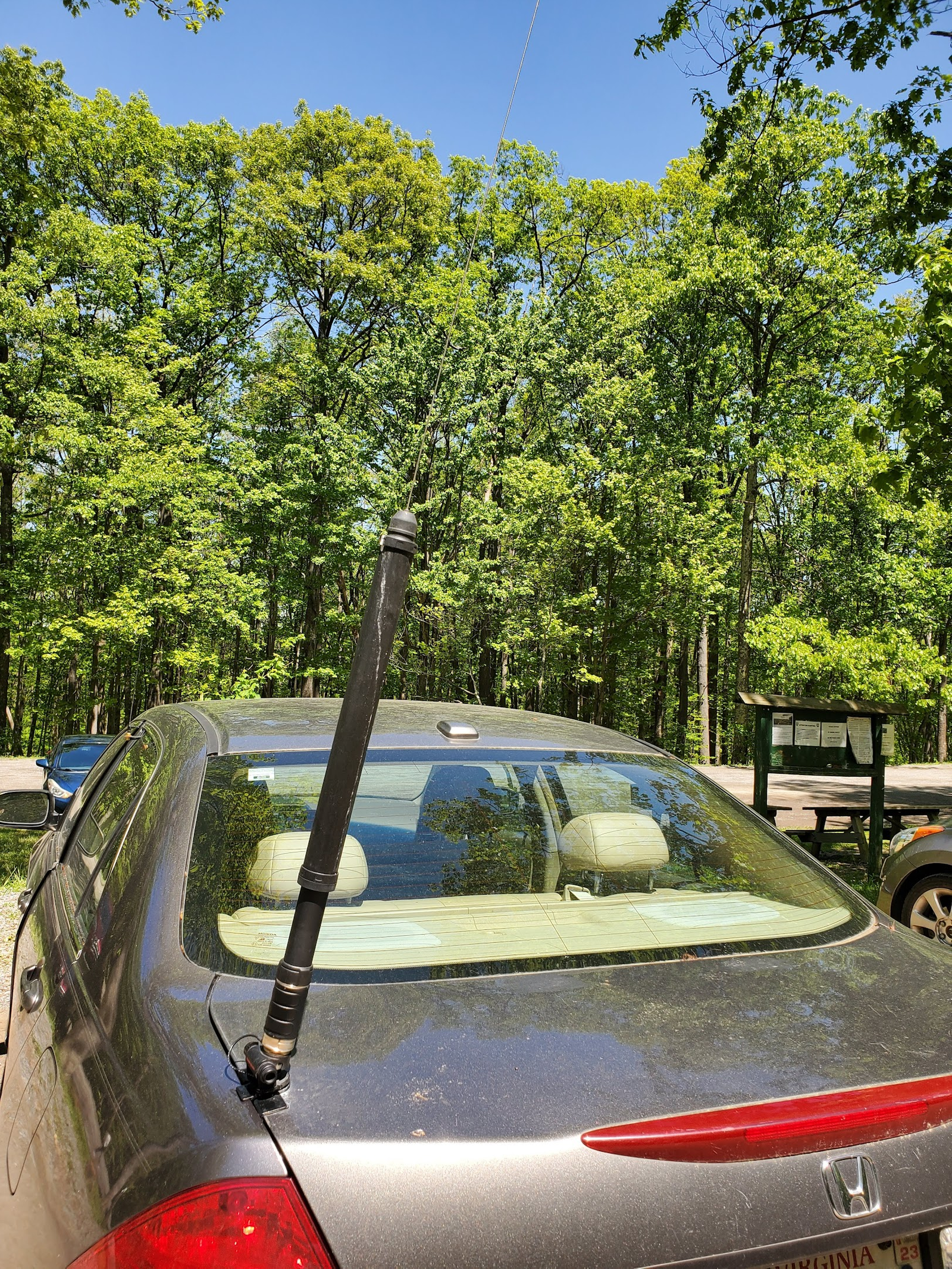
Coopers Rock State Forest is located a stone's throw from Interstate 68 about 13 miles from Morgantown, West Virginia. Right as you get off the road there is a large gateway that you pass under to let you know you're entering the park, and we immediately saw a parking lot that looked perfect for our activation. We could not have asked for more perfect accommodation as the parking lot was spacious and mostly empty, was surrounded by a beautiful sylvan setting, was high atop a mountain, had a picnic table under a shelter, and even had bathroom facilities. Amazing -- this is a place I'd love to explore more of on a future visit. Since we had the mobile setup, we were able to get on the air quickly and chose to use the 20m band in the hopes of a getting a quick and efficient activation.
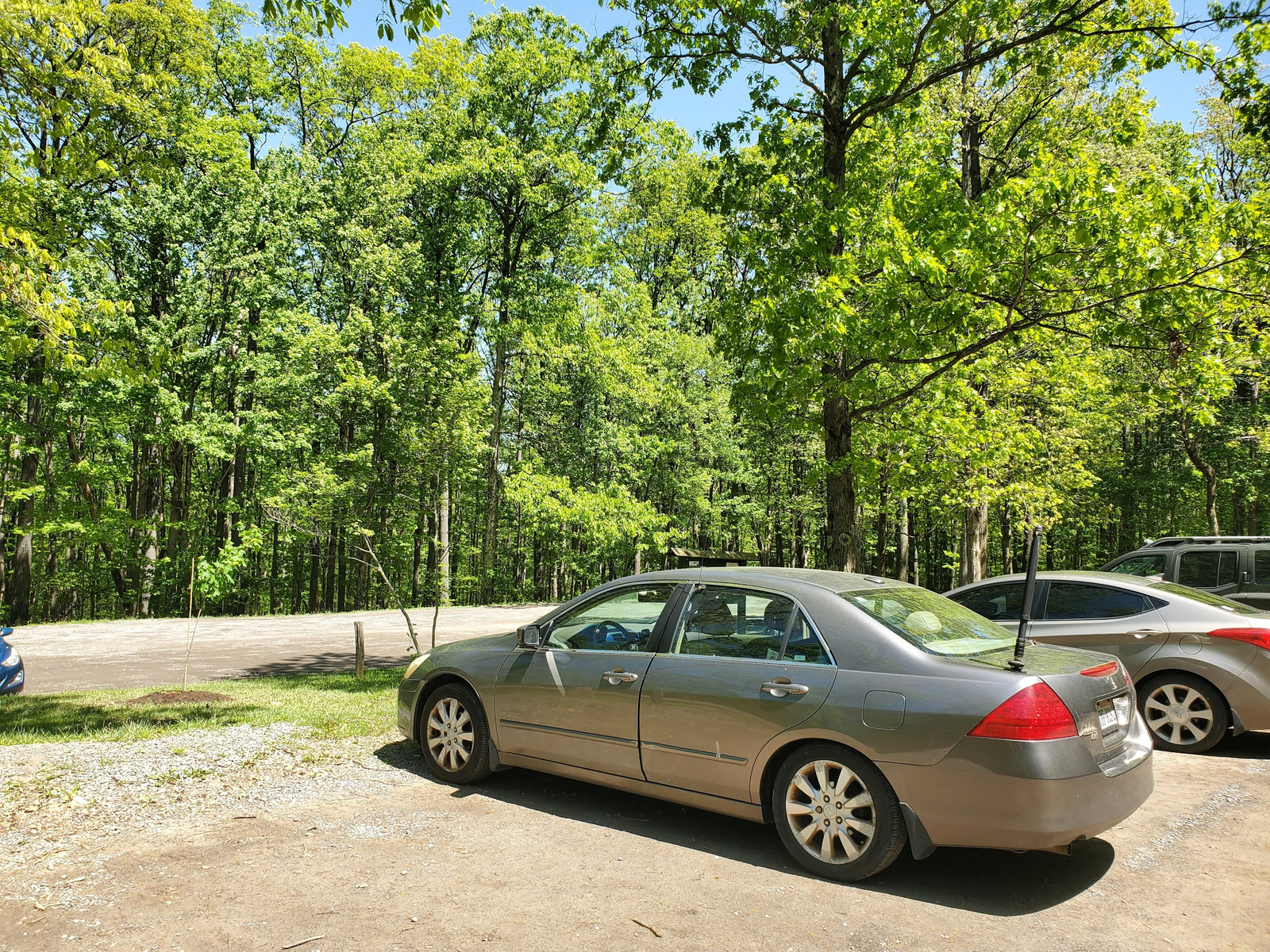
This would be an all SSB pass-the-mic affair, so we fired up HAMRS, spotted ourselves on the POTA spotting page, and started calling CQ. We didn't have to wait long until we got our first contacts with prolific activator and hunter AD0WN in Missouri. He was coming in 59 to us, although he was doing some work on his side hearing us 44. Next up was a Park-to-Park with N2EOM at Two Rivers State Recreation Area in Nebraska. He was on the quieter side, but we were able to make the contact from high atop our mountain. Next up we got another call from Missouri, followed by a Park-to-Park with N5SLY at Eisenhower Birthplace State Historic Site in Texas with a 55 both ways. Next up we heard from Florida, Illinois, Kansas, Florida, Illinois, and Arkansas. Next we got a pleasant surprise (not reflected on the map, unfortunately) when WA1MAD gave us a call with a /VY2 suffix from Prince Edward Island, Canada. He was coming in strong and we talked about how beautiful it is up there (I had visited as a teenager many years ago). Finally we heard from another station in Florida and with 12 QSOs in the log, we decided to use a break in the action to call QRT and continue on our journey to Ohio. Even with 2 ops, we got 12 contacts in 12 minutes, not a bad rate when you consider that's about one every 30 seconds for the 24 contacts in all. This is definitely a park I wouldn't mind revisiting someday.
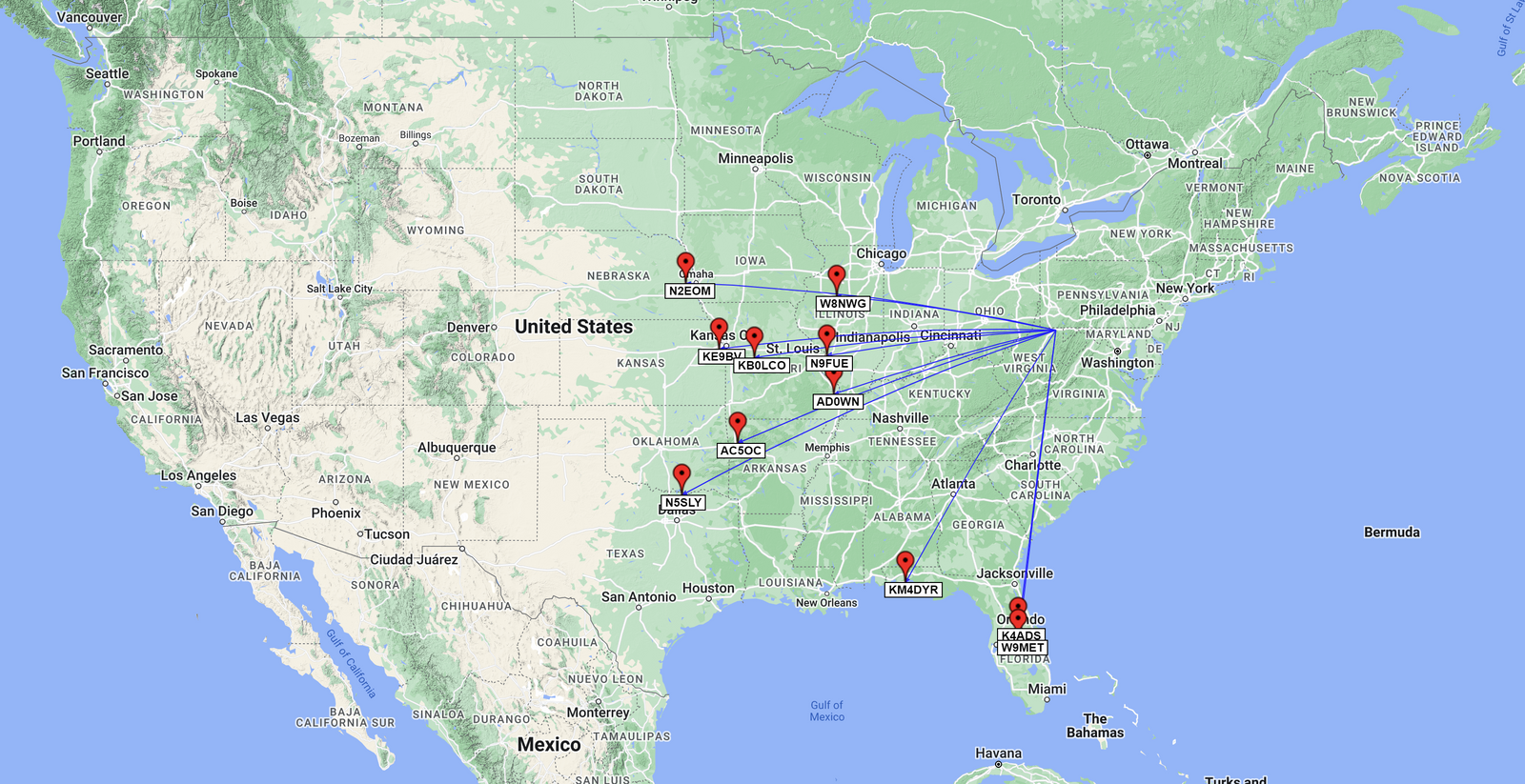
Activation QSO Map: Red Pins = SSB / Blue Lines = 20m
Gear used in this activation
- Yaesu FT-891
- Yaesu ATAS 120A Antenna
- 2006 Honda Accord EX V6
- Samsung Galaxy S10+
- HAMRS Logging App
Posted on May 18th, 2023
POTA Activation #57: A Commute to Work CW 2-fer on 40m (DC) (5/12/2023)
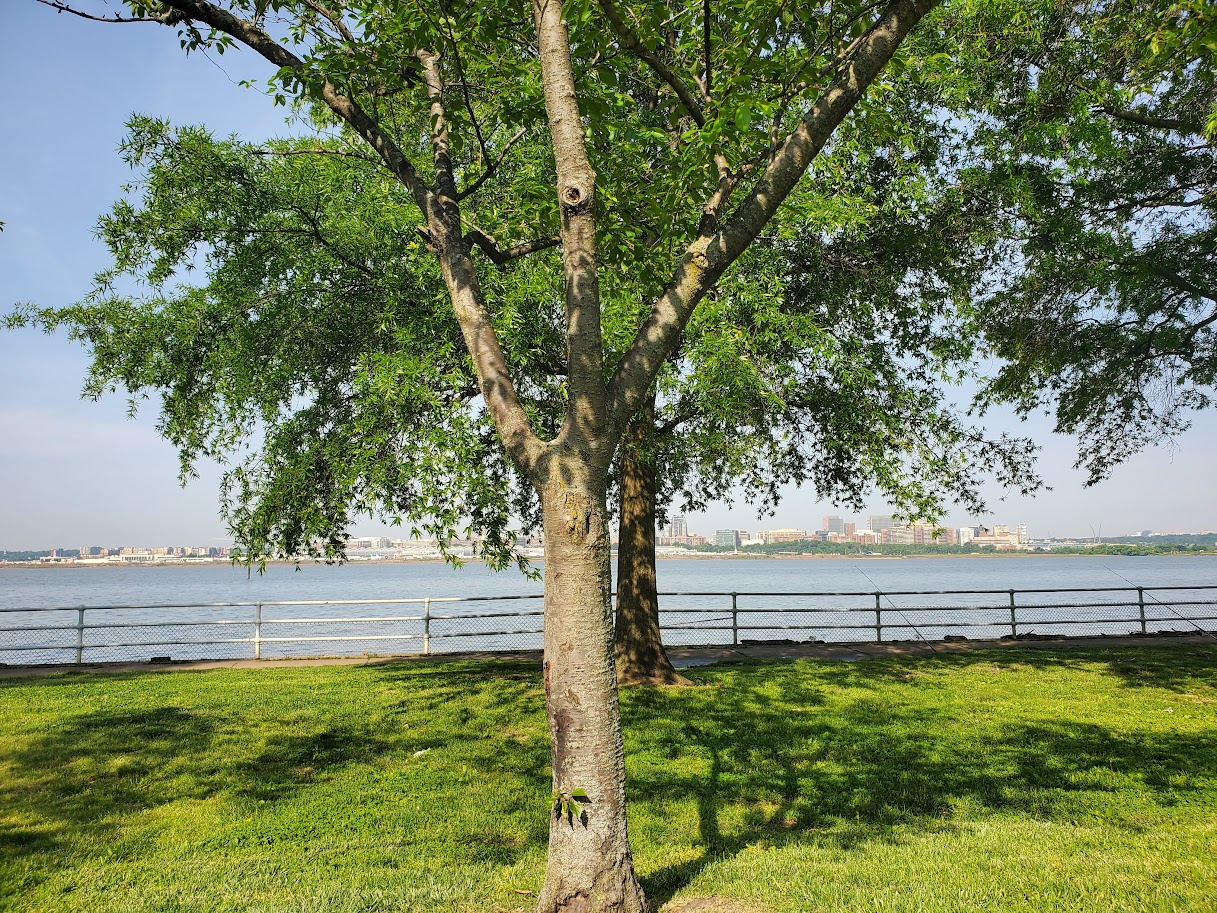
It was a glorious Spring morning here in the DC area this morning and I was able to get up a bit earlier than usual so I was on my way to work bright and early. I was treated to abnormally light traffic as well, so I crossed the 14th Street bridge with plenty of time to spare and was able to take the exit to West Potomac Park and drive around Hains Point to one of my favorite drive-up activation spots in both Captain John Smith Chesapeake NHT and Star-Spangled Banner NHT. My usual parking spot was cordoned off for the Police Unity Tour which I presume was scheduled to roll-through later on in the day, so I went a few feet down the road to the next parking area and got myself ready for an activation.
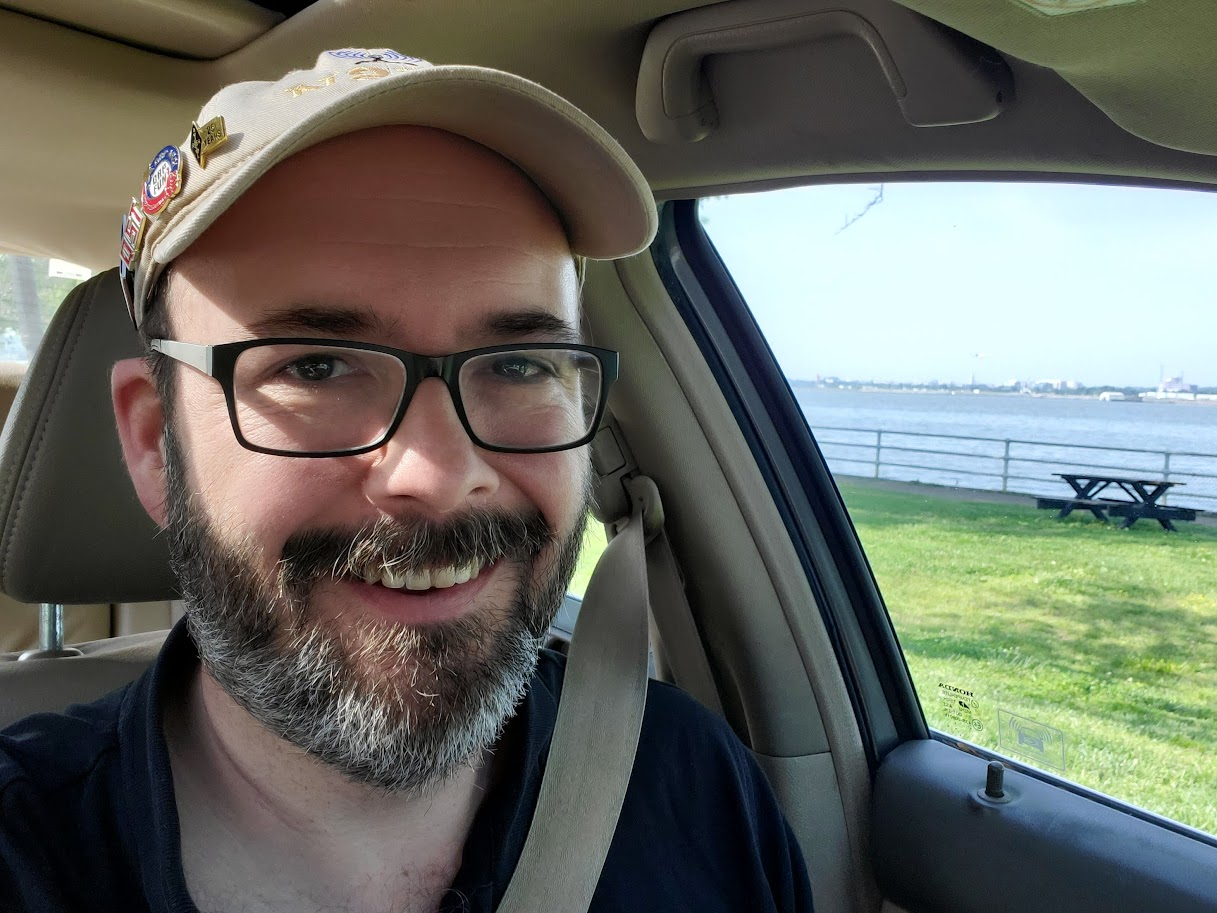
This morning I had time on my side, so I opted to give 40m a go, hoping I could get some of my LICW friends in the log and knowing that I would have some time to work the pile-up if it decided to happen. I sent out a note to the LICW group that I was QRV, spotted myself, and started at 7.042 MHz calling CQ. It didn't take long for Mike N2PPI to give me a call with a solid signal into DC from NY -- always fun to get him in the log. Next up I heard from a station in Michigan, followed by Ed N2GSL in NY coming in a bit soft (he was probably running QRP) but fully readable in the District. That made 2 LICW buddies in 3 QSOs, I was loving it.
Next up I heard from Georgia, New York, and Massachusetts. Next up was frequent hunter Dan WD4DAN with a strong signal from Georgia, followed by New York, North Carolina, super activator KU8T in Indiana, New York, Virginia, Ohio, Rhode Island, and another Ohio. Next I heard a very faint Rin W4RIN just above my noise floor in Georgia. Great to get another LICW member in the log (#3)! Then I got a call from super hunter Joe N3XLS in Pennsylvania (also an LICW member if memory serves me correctly, #4), then I was treated to another LICW contact with Chris N8PEM in Ohio coming in like he was transmitting right next to me for my 5th LICW contact of the activation. It was good to get him in the log and I am hoping to see him and Ed N2GSL at Hamvention next week.
The pile-up kept running, so I heard from Tennessee, Maine, North Carolina (x2), Ohio (x2), New York, Massachusetts, Maine, Virginia, Kentucky, Michigan, Ontario (Canada), Ohio, Michigan, Maryland, Pennsylvania (x2), Maine, Pennsylvania, New Hampshire, and finally Massachusetts. There was a stop in the action and I saw my time was running late, so I called QRT and called it an activation.
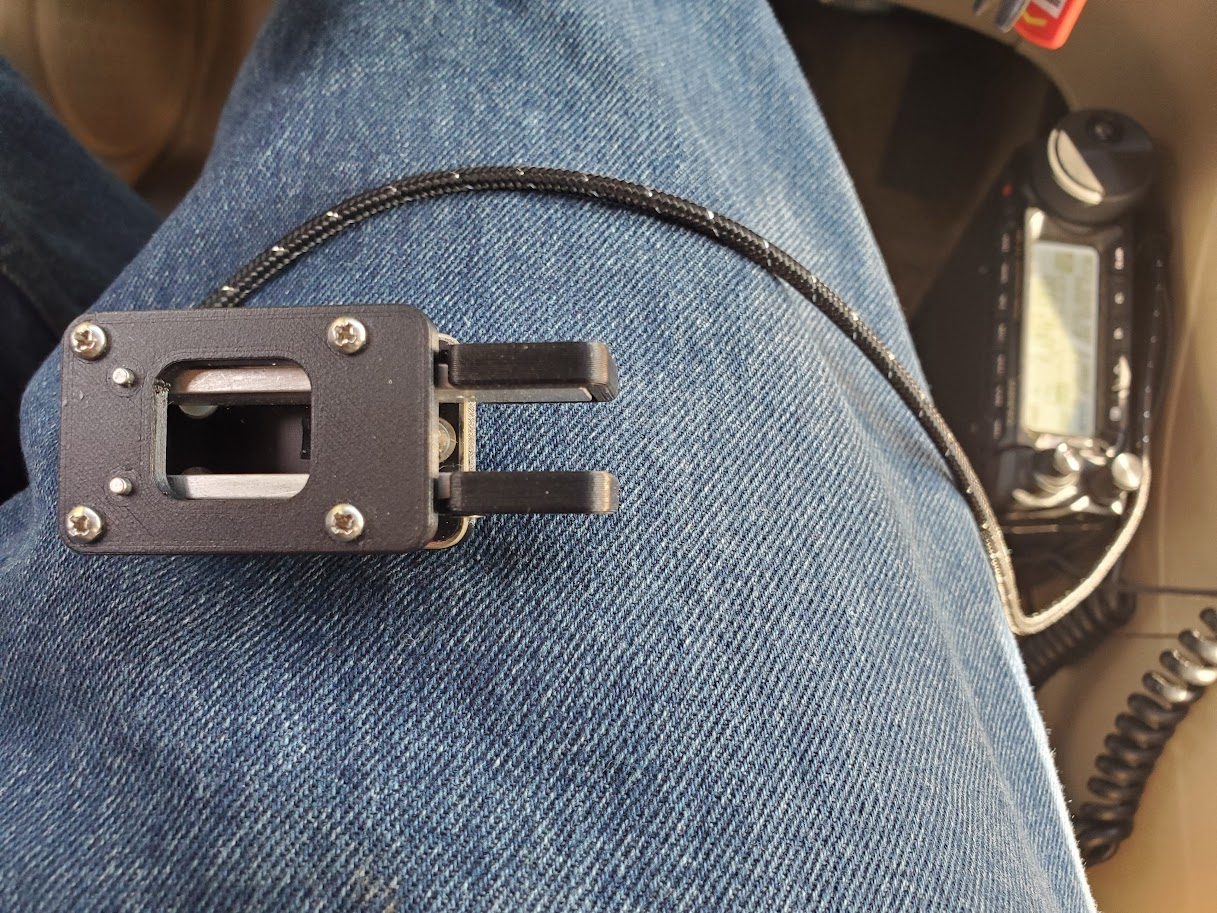
In all I had 40 contacts in 45 minutes on the air with 5 of those being LICW members (12.5%!). It was a lot of fun making contact with so many friends and familiar calls and a wonderful way to start the day. These two brought my activation count to 115 activations with 4,146 total QSOs. Definitely a lot of fun.
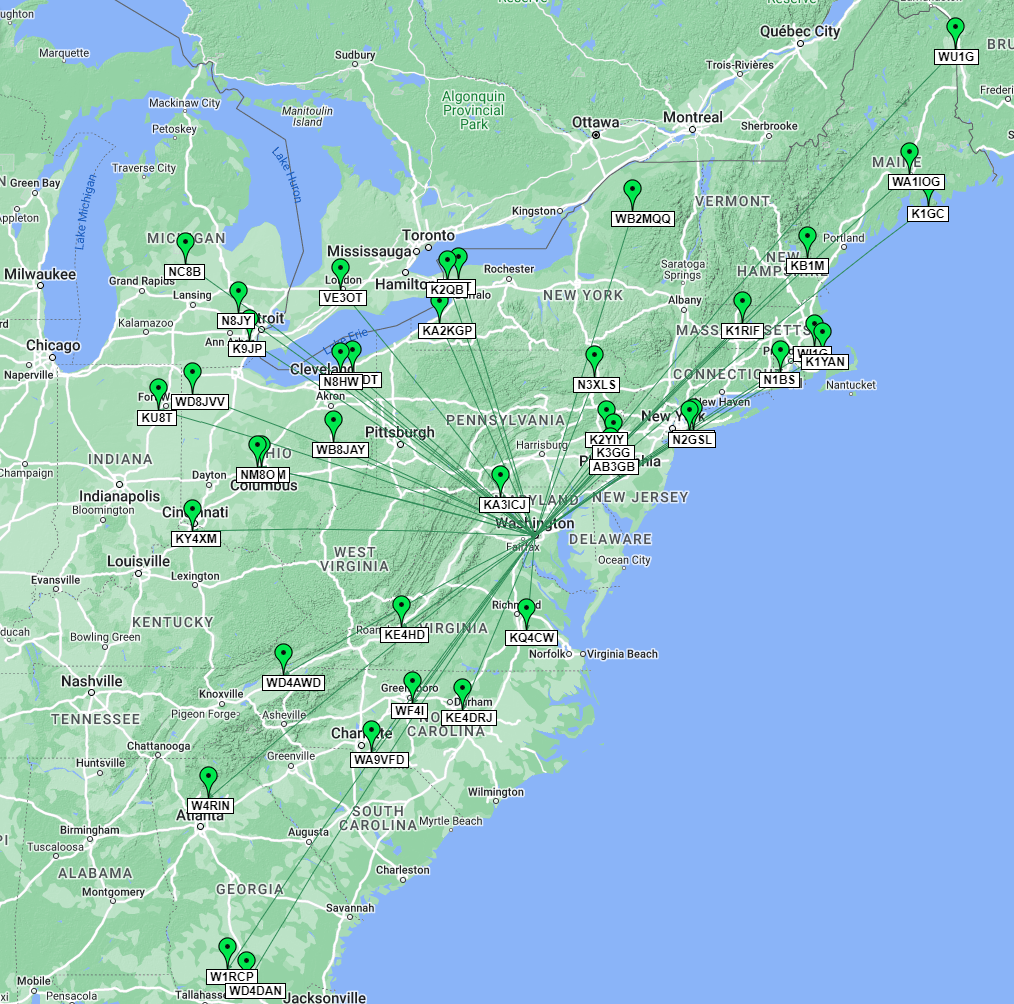
Activation QSO Map: Green Pins = CW / Green Lines = 40m
Gear used in this activation
- Yaesu FT-891
- Yaesu ATAS 120A Antenna
- CW Morse SP4 POTA/SOTA Mini Morse Code Magnetic Paddle (N0SA Designed)
- 2006 Honda Accord EX V6
- Samsung Galaxy S10+
- HAMRS Logging App
Posted on May 12th, 2023
POTA Activation #56: A Commute to Work CW 2-fer on 30m (DC) (5/3/2023)
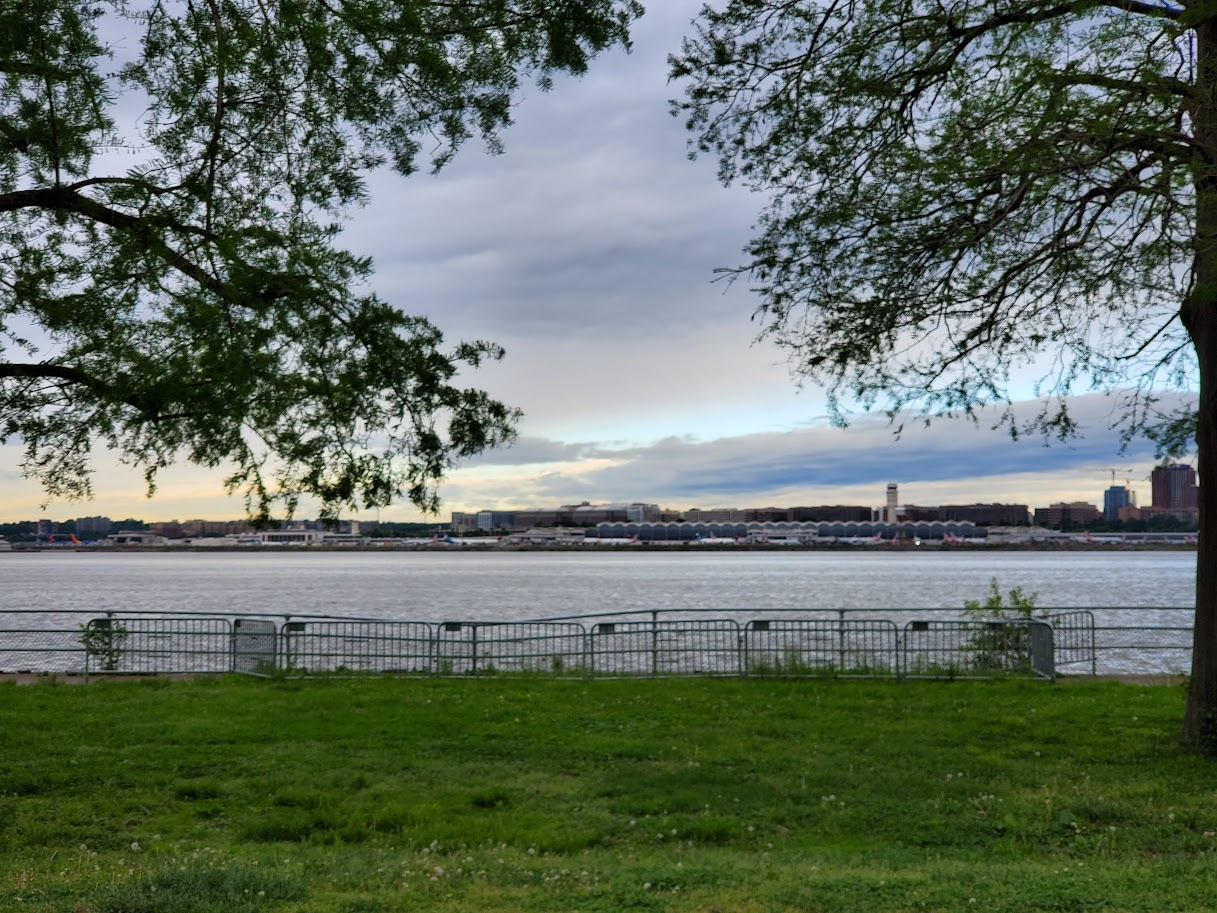
Things have been busy at work recently with a multi-year project coming to its completion in the last month. As a result, I have not been able to get out into the parks for over a month as a lot of my "off" hours had been turned "on". While things are still busy on that front, I had some time this morning before work to get into a park on the way into work for a very quick activation. The month gap had been one of the longest periods of time between activations since I had started activating. It felt good to be back.
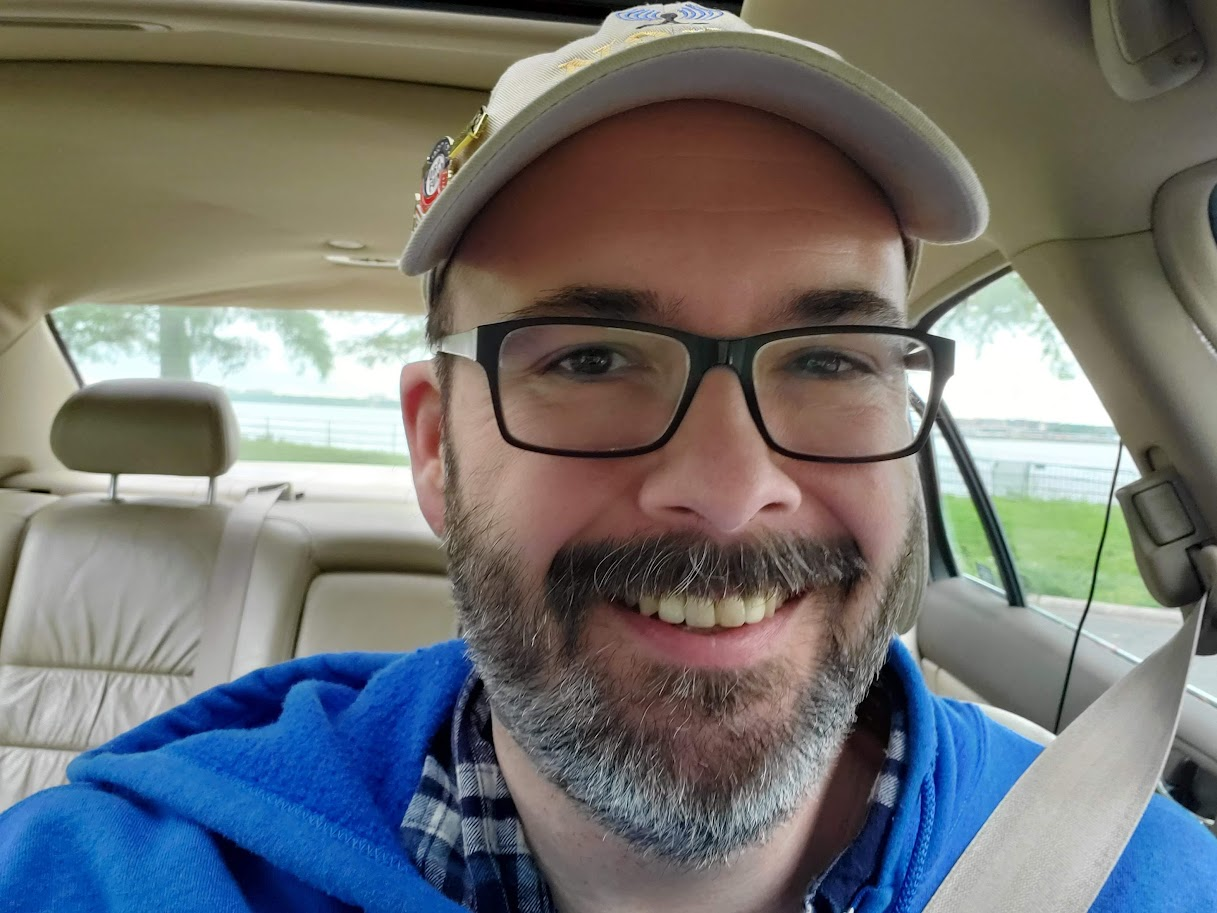
With time limited, I decided to hit up Hains Point in DC and one of my easiest to activate 2-fers at Captain John Smith Chesapeake NHT and Star-Spangled Banner NHT. It was a cool and cloudy morning that was threatening rain. While there were some drops on my way in, they stayed away while I was in the park. I had been listening to the bands on the commute and 40m had seemed to be alive. I even was able to make a quick POTA contact with a station in Southwest Virginia while I was stopped at a gas station refueling. When I got to my activation site I decided to go up a bit into the 30m band where there was less of a chance of an endless pile-up so that I could do a relatively short activation without leaving anyone out with a reasonably quick QRT.
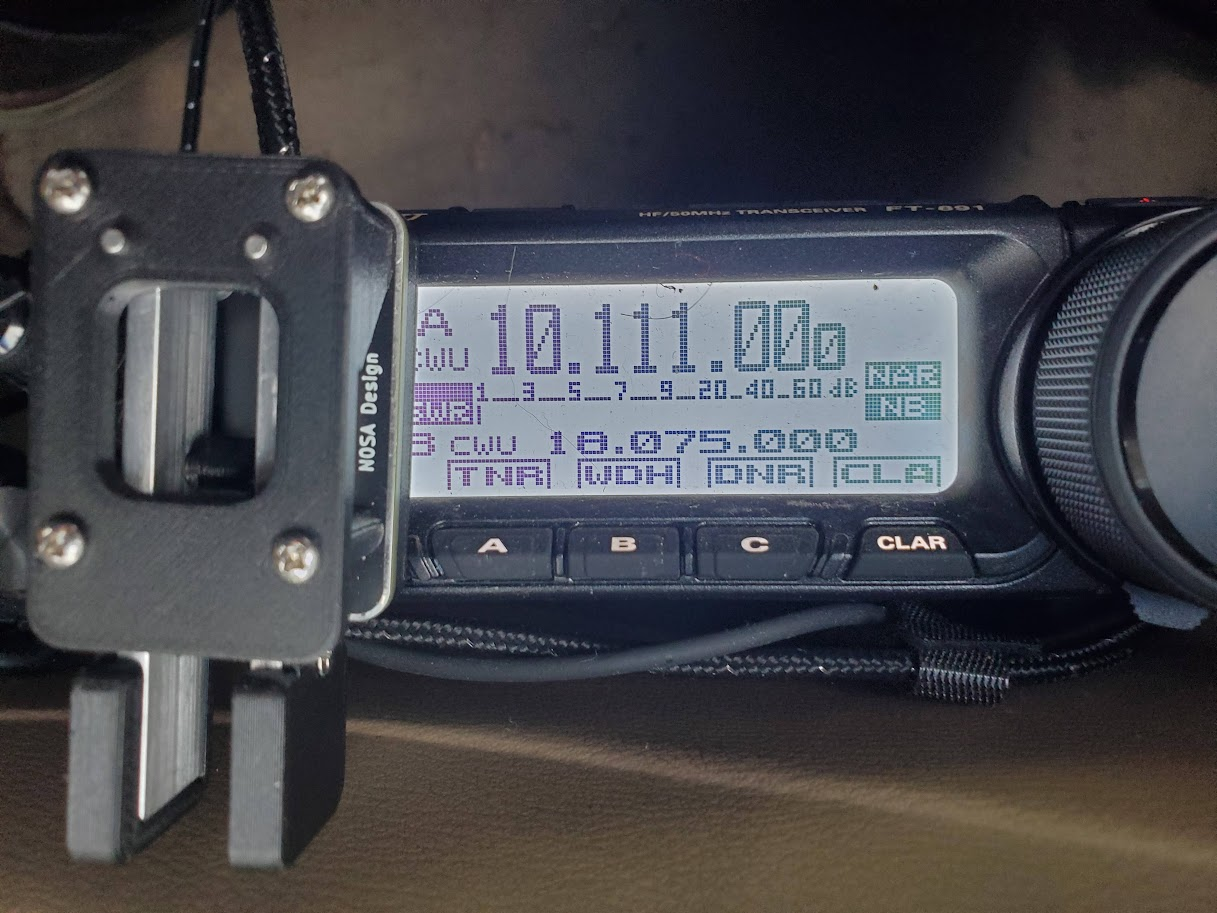
I set-up shop on 10.111 MHz, checked my tune on the ATAS 120A, notified some LICW friends, and put out a spot on the POTA spots page, and I was off. It didn't take long for me to get my first contact with a station in Illinois with a 599 both ways. Next up with Missouri with another strong report, followed by fellow LICW instructor Gary, W5GDW, in North Carolina. It was good to get him in the log. Next up was Arkansas and Massachusetts, followed by a frequent hunter in MD just a few miles away, N3VO. I was excited to hear Marc so clearly -- usually getting him on 30m is much more difficult being so close-in since we're shooting over each other with our RF. Next I got another Massachusetts station, then Iowa, Tennessee, Massachusetts again, North Carolina, Georgia, Tennessee, Indiana, and finally Michigan. There was a lull in the action, and looking at the clock I saw it was time to make it into the office, so I sent QRT and called it a day.
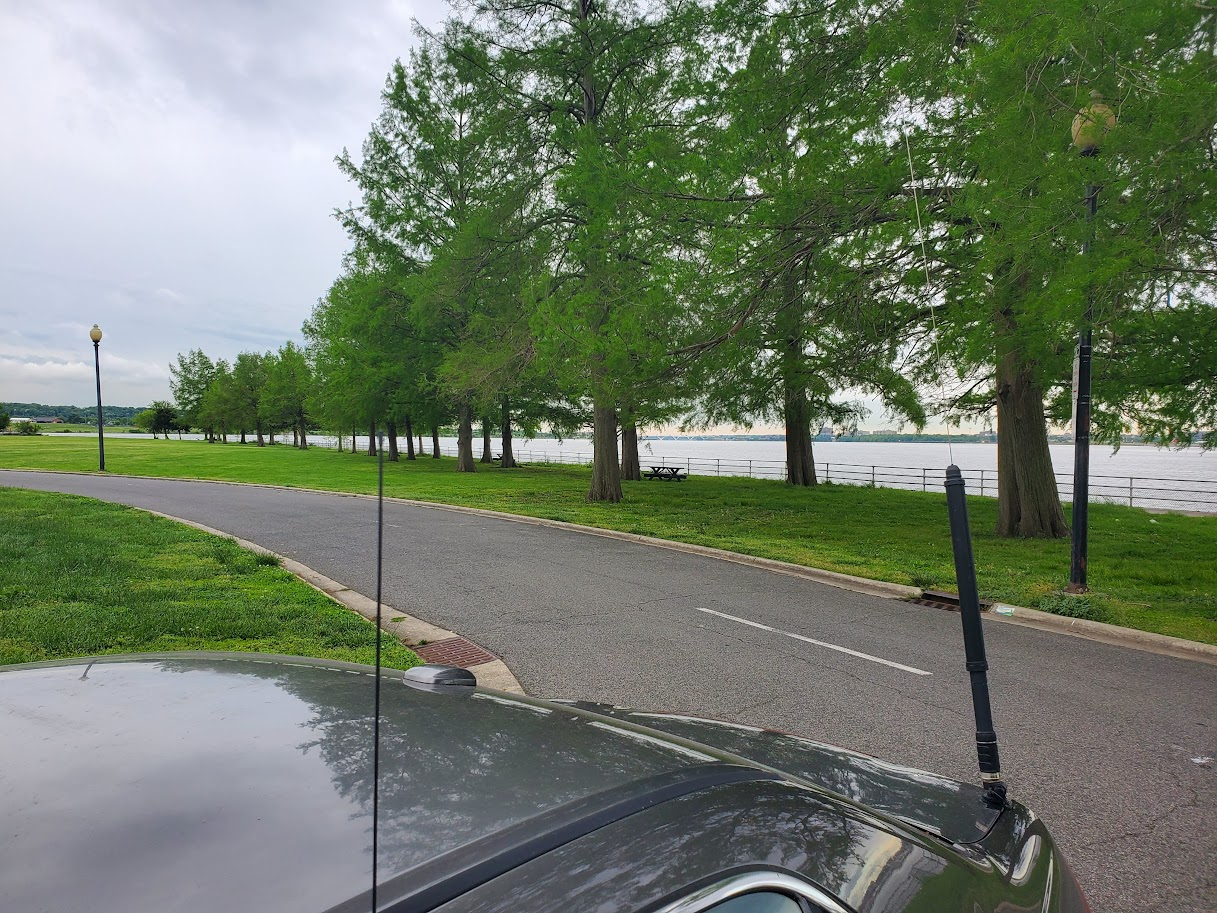
If I had more time I would have dropped down to 40m as some of my LICW friends had tried to hear me on 30 with no luck, but it just wasn't possible today. In all I got 15 contacts in 21 minutes on the air getting a nice spread across the Eastern United States. It felt good to be back out in a park and hearing the rhythmic music that is Morse code contacting friends old and new. I'm looking forward to my next outings. I have some new gear to test and with the weather getting nicer everyday, it will be great to be outside playing radio.
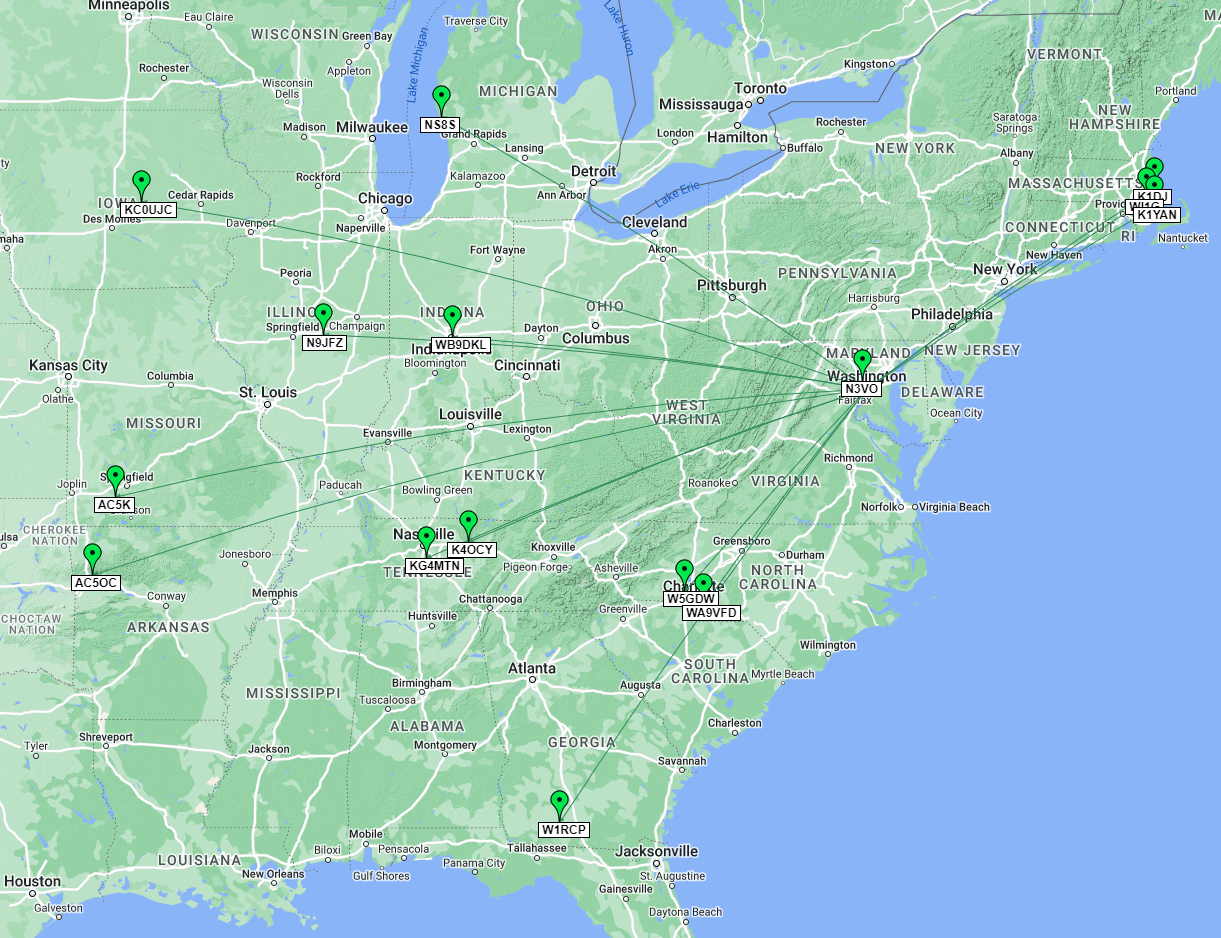
Activation QSO Map: Green Pins = CW / Green Lines = 30m
Gear used in this activation
- Yaesu FT-891
- Yaesu ATAS 120A Antenna
- CW Morse SP4 POTA/SOTA Mini Morse Code Magnetic Paddle (N0SA Designed)
- 2006 Honda Accord EX V6
- Samsung Galaxy S10+
- HAMRS Logging App
Posted on May 3rd, 2023
POTA Activation #55: A Lunch Break QRP 4 Park Activation with a New Rig and New Antenna (VA) (3/28/2023)
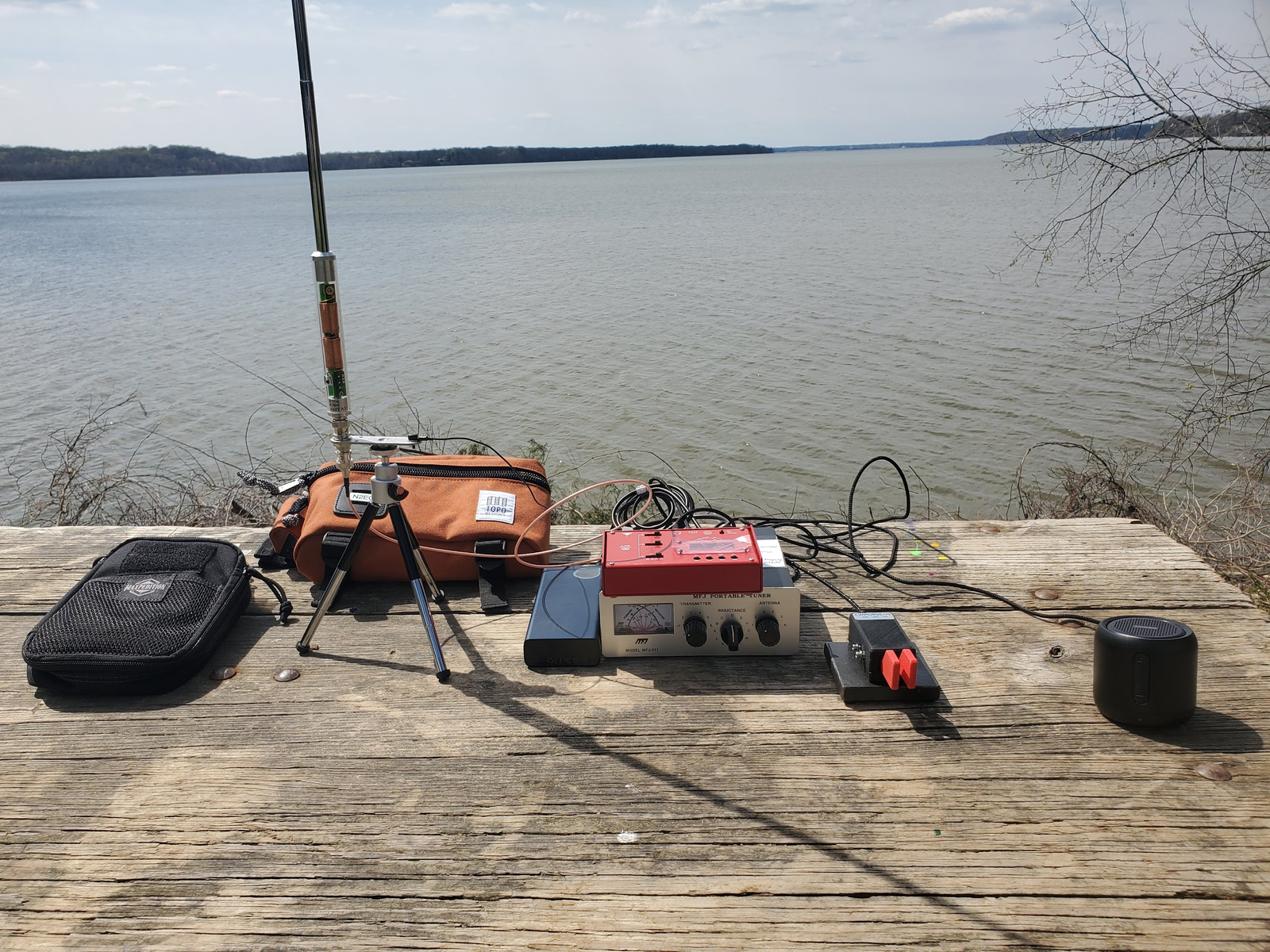
I have been interested in getting a Mountain Topper radio for a while now, but they have been mostly out of stock for a long time. Supply definitely has been outstripped by heavy demand and when a new tranche of radios is released into the wild, they are usually gone in a day's time. I was looking at an online forum and saw someone mention that a set of 100 Mountain Topper MTR-4B radios had been released on the LNR Precision site, so I decided to go for it and get my order in for one of the radios. I believe I was #26 in-line and they said they hoped to ship some out immediately and others could take a month or more. As Tom Petty said, the waiting is the hardest part, but after about a month I received notification of my radio being shipped from North Carolina. It finally came in the mail on Friday, and on Saturday I was able to get it hooked up at home and run it through its paces. I tested it on all 4 bands (80m, 40m, 30m, and 20m) and was spotted with just under 5 W on all of them on the Revere Beacon Network. I even had a couple of really nice ragchews: one with a station in Binghamton, NY, and another with a station in Raleigh, NC, both on 40m, even with some challenging propagation conditions. The receive audio was astonishingly quiet with so little noise that I had to initially wonder if it was on, but the signals were very clear on receive. I was very happy.
Of course, that's not all that is necessary for an ultra-portable setup. I pulled out an MFJ-971 Portable Antenna Tuner to make sure that it was well matched with my home antenna, and it did the job quite well on all bands with a 1:1 on 80m, 40m, and 30m, and about a 1.4:1 on 20m. It is on the bigger side, but it was what I had on hand. I have a smaller QRP tuner on my kit building queue that will allow me to get everything even smaller. I also decided to run on battery power with a new power bank during my testing as well. The MTR4B really wants 12V, and no more than 13V for its supply voltage, so I looked at various options for powering it. I could use my LiFePO4 batteries with some in-line diodes to drop the voltage, but I decided to investigate an idea that I found quite intriguing. Using a USB Power Bank that supports the PD standard.
If you're not familiar with PD, it is short for Power Delivery, and it is one of the primary ways that fast charging is being implemented on USB C devices these days. Basically, there is a chip in the power supply that communicates with the load device that allows the load to request a higher voltage for a given current, allowing more power to be delivered. Regular USB uses 5V, but PD can also supply 9V, 12V, 15V, and 20V. To get the voltage you want for non-USB devices, trigger cables are created that have a chip in them to negotiate a desired voltage with the power supply and then provide that voltage as a regular DC power output. In my case, I wanted 12V, and I was able to find a trigger cable purpose-built for that voltage complete with the right dimension barrel jack with the correct polarity from Amazon from the vendor JacobsParts. It put out 12.0 V on the nose. Fantastic.
For the power supply itself, I got a 65W 20,000mAh PD USB power bank from Baseus on Amazon. This has the benefit of being able to power all my devices with ample power including my phones, tablets, laptops, and yes, my radios. For the MTR4B I'm using the 12V cable, for the others, I can use a 15V cable. The battery is below the 100 Wh threshold that garners extra scrutiny from the TSA and they see power banks all the time. For my upcoming trip to Greece, this will be an essential part of my kit. When I first hooked things up, it was with some trepidation as I worried that the boost converters on-board might introduce noise into the HF bands. Thankfully, no noise was heard, only quiet receive. Perfect. So we have power, we have a tuner, and we have a radio. How about the antenna?
For this first activation with the radio I decided to use my recently acquired Elecraft AX1 antenna for its maiden voyage. It is a multi-band whip antenna capable of being used on 20m, 17m, and 15m out of the box, and with the AXE1 loading coil, it can be tuned up on 40m and 30m as well. With that antenna and the coil, I can use 75% of the bands the rig can use. The antenna is certainly "compromised" with its small form factor, but there are a lot of POTA activators that have had success with it, so when you're the DX, it might be a great tool to have a super portable antenna that can be deployed almost anywhere. We would certainly find out.
Rounding out the kit was a new Anker Soundcore Mini speaker since the Mountain Topper doesn't have an internal speaker (or even a volume control for that matter). Unlike many modern speakers, this one has an 1/8 inch stereo jack, so I could connect the headphone out to the input of the speaker. I could also use headphones with an in-line attenuator if desired, but I knew that the park I was going to was relatively quiet and usually not busy enough on a weekday to have my beeping be a nuisance to other park visitors. I even got a kid and his mother come by and ask about the Morse code and who I was talking to, and they were stunned when I said I had just talked to someone in Colorado. But hey, I'm getting ahead of myself.
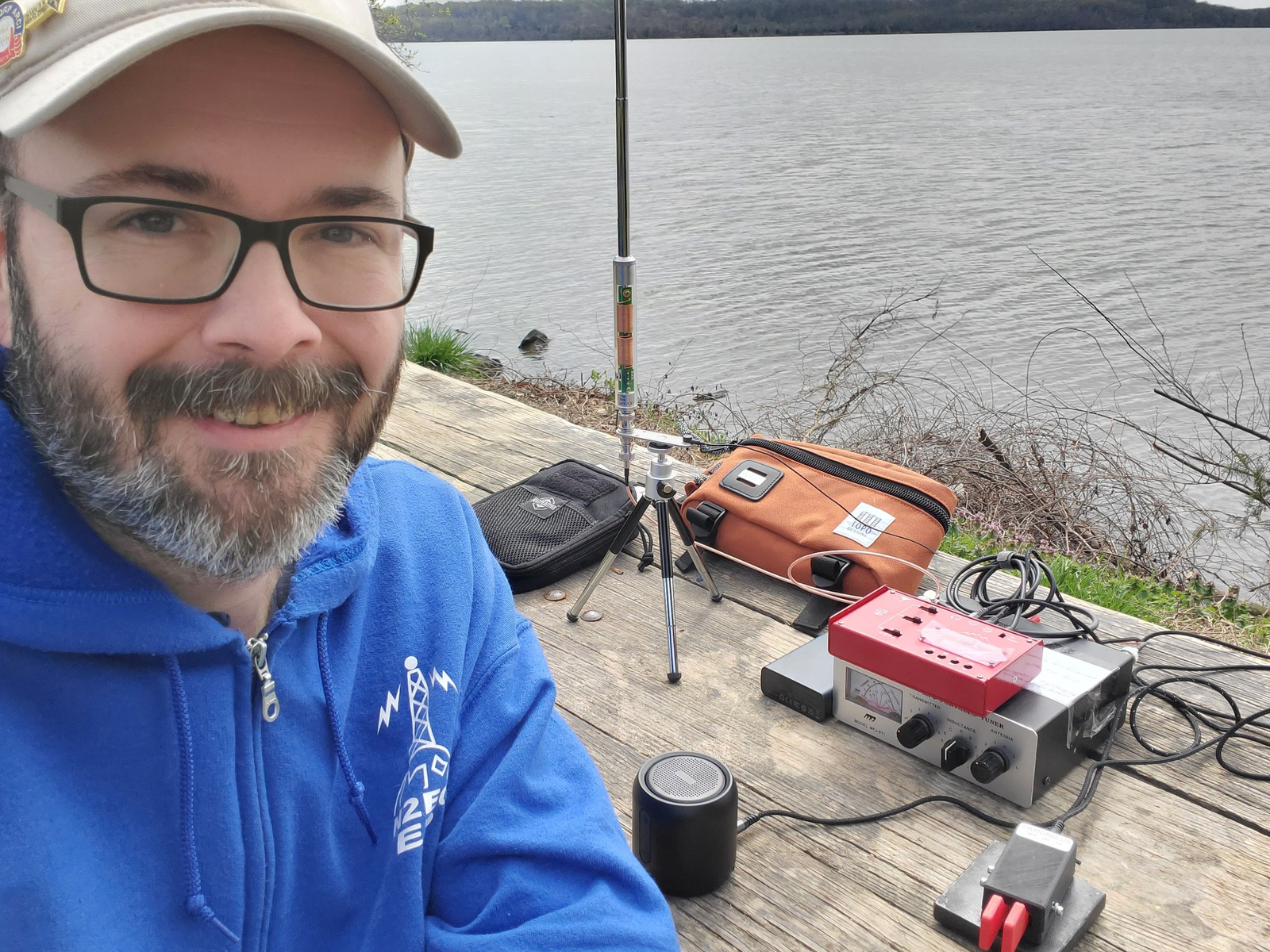
I had a window of time on my lunch hour while I was working from home, so I decided to head over to one of my favorite spots that also happens to be a 4-fer. I was able to have everything radio and CW related in the hip pack and the antenna was in the Maxpedition organizer. The tuner I carried by itself. I found an empty picnic table right on the banks of the Potomac river and started setting up the station. Everything worked perfectly, and after a few seconds switching the inductor to maximum noise, I was able to modify the transmitter capacitance to get a 1:1 match on the 20m band CW portion. I gave a heads-up to my friends in the Long Island CW Club, spotted myself on the POTA spots page, and started calling CQ on 14.042 MHz.
I'll be honest, the going was slow. My first contact was with a station in Florida, followed by about 6 minutes of no responses to my CQs. Then I heard back from a station in Tennessee that was giving me a rather optimistic 599, but hey, I'll take it. 2 in the log. Shortly thereafter I got a call from a station in Wisconsin who heard me 339, so 3. After another 4 minutes of calling CQ, I heard back from a station in Minnesota who heard me better than I heard him, so 4 in the log. After another minute I heard from a Texas station with a 559 both ways, followed by 6 minutes of unanswered CQs. Colorado was next, with a 559 both ways for the 6th entry in my log.
Shortly after that contact a woman and her son came by to inquire about the Morse code and I gave a quick explanation and told them I had communicated with someone in Colorado and they seemed very excited to hear that.
I kept calling CQ and after another 3 minutes heard back from a station in Illinois. 7 in the log. After a lot of 100W activations lately, I forgot how QRP can test your patience. But it felt good to be making my way toward the goal, so I kept calling CQ, quietly wishing I had set the memory keyer up before I started the activation with my CQ.
I would be calling CQ for quite a bit of time -- 12 minutes, before I would hear from a station in Florida who gave me a 229. Glad he stayed with me, I really needed the contacts and was starting to worry I might have to fall-back to my mobile station and 100 W to finish this thing.
I kept going and after another 2 minutes got a call back from a familiar call, Dan, WD4DAN, who was loud and clear and gave me a (likely optimistic and kind) 599 both ways from Georgia. That made 9 contacts. So close. Unfortunately, I would be on the precipice for another 12 minutes, calling out into the void. Then 47 minutes after I started, I got contact number 10 from a station in Illinois. We had some QSB between us, but on the peaks I heard him 569 and he heard me 559. The activation was made. I decided to keep going and 2 minutes later got a call from Iowa, hearing me 319, very glad he was able to pull me out of the noise. After making 11, I decided to call QRT and call it an activation.
I packed up my station and made my way back to the car and saw an alert from my LICW friend Mike, N2PPI. He was down in Florida on a vacation and had been operating and asked the group if anyone wanted to make a contact. My QRP setup was dismantled, but I turned on the mobile rig and heard him calling CQ, so I called him back and we had a quick QSO. Since I was still in the park(s) I added him to my log and headed on home.
In all I had made 12 contacts in 1:06, tested out a lot of new gear, and got to enjoy a bit of a QRP adventure. When I got home, I saw that band conditions were not great on 20m and below, so that might have explained some of the challenge I had faced. Even with the slow rate, it was a lot of fun digging out the signals from the noise to find the auditory treasures beneath.
I am pleased with how everything worked. The Mountain Topper is a wonderful rig that is a pleasure to listen to super simple to operate. The AX1 has to be the easiest antenna to deploy I own -- I look forward to giving it some more activations, hopefully on days with better band conditions. The Baseus USB PD Power Bank really impressed me with how easy it made powering everything. Even after nearly an hour on the air, I had gone from 100% to 98% on the battery pack. This thing can activate forever. The MFJ 971 did the job quite well. It is big though, so I'm looking forward to building a smaller manual tuner soon. And finally, it was a lot of fun having a setup this compact. This will be great for Greece and would be great for a long hike-in to a park or a summit. It still blows my mind that a radio in a hip pack and a skinny little whip can communicate clear across the country using a phone charger. So much fun.
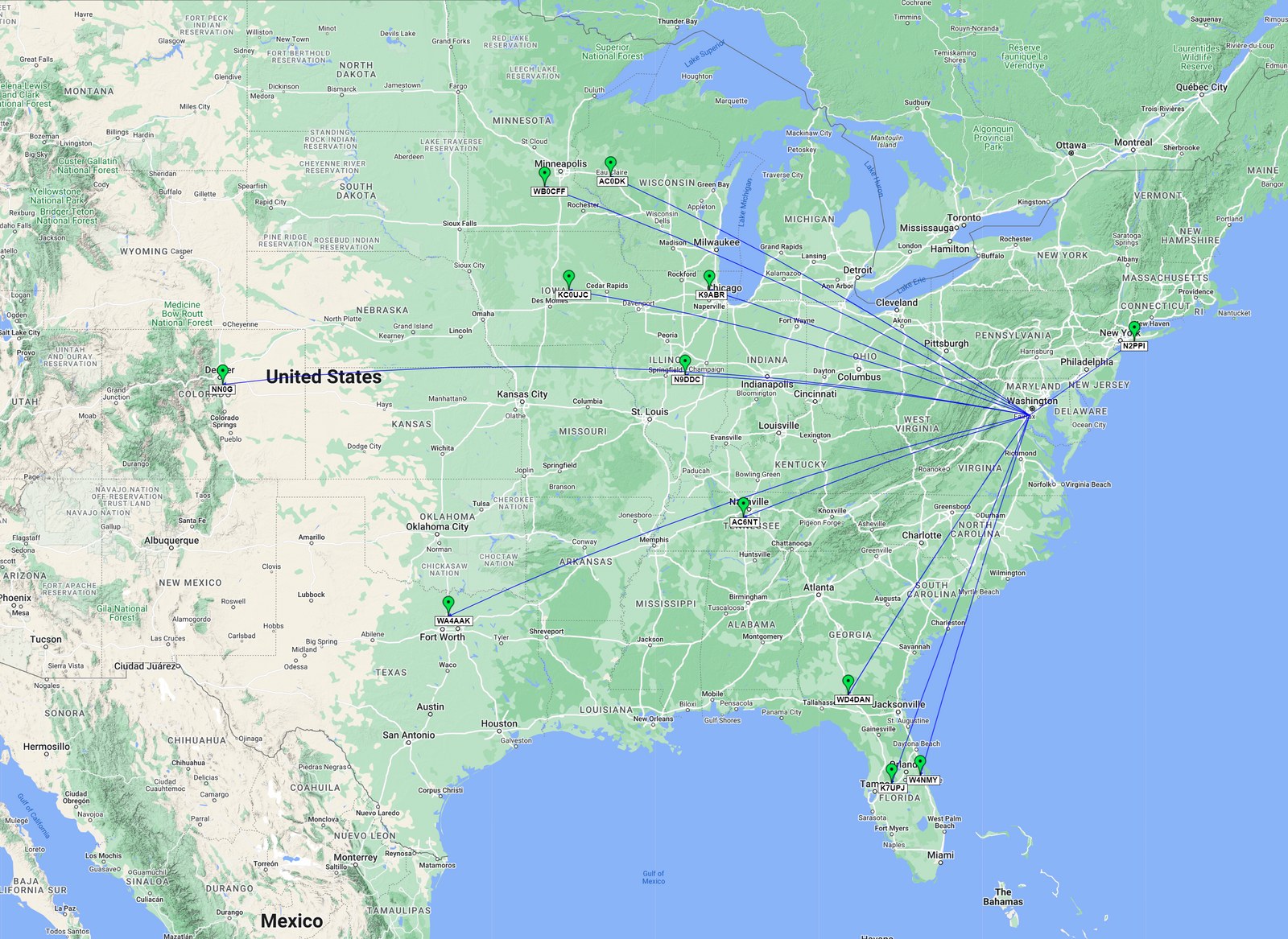
Activation QSO Map: Green Pins = CW / Blue Lines = 20m (N2PPI actually near West Palm Beach, FL)
Gear used in this activation
- LNR Precision Mountain Topper MTR4B
- Elecraft AX1 Multi-Band Whip Antenna
- MFJ-971 Portable Tuner
- CW Morse Pocket Double Paddle Morse Code Key with Magnets
- CW Morse Steel Base for Pocket Paddles
- Baseus Power Bank (65W, 20,000 mAh, PD3.0)
- JacobsParts 12V/5A USB C PD Trigger Cable
- Anker Soundcore Mini Portable Speaker
- Topo Designs Hip Pack
- Maxpedition Fatty Pocket Organizer
- Amazon Basics Lightweight Mini Tripod
- Samsung Galaxy S10+
- HAMRS Logging App
Posted on March 28th, 2023
POTA Activation #54: A Rainy Day 4 Park 3 Band Activation Before Work (VA) (3/24/2023)
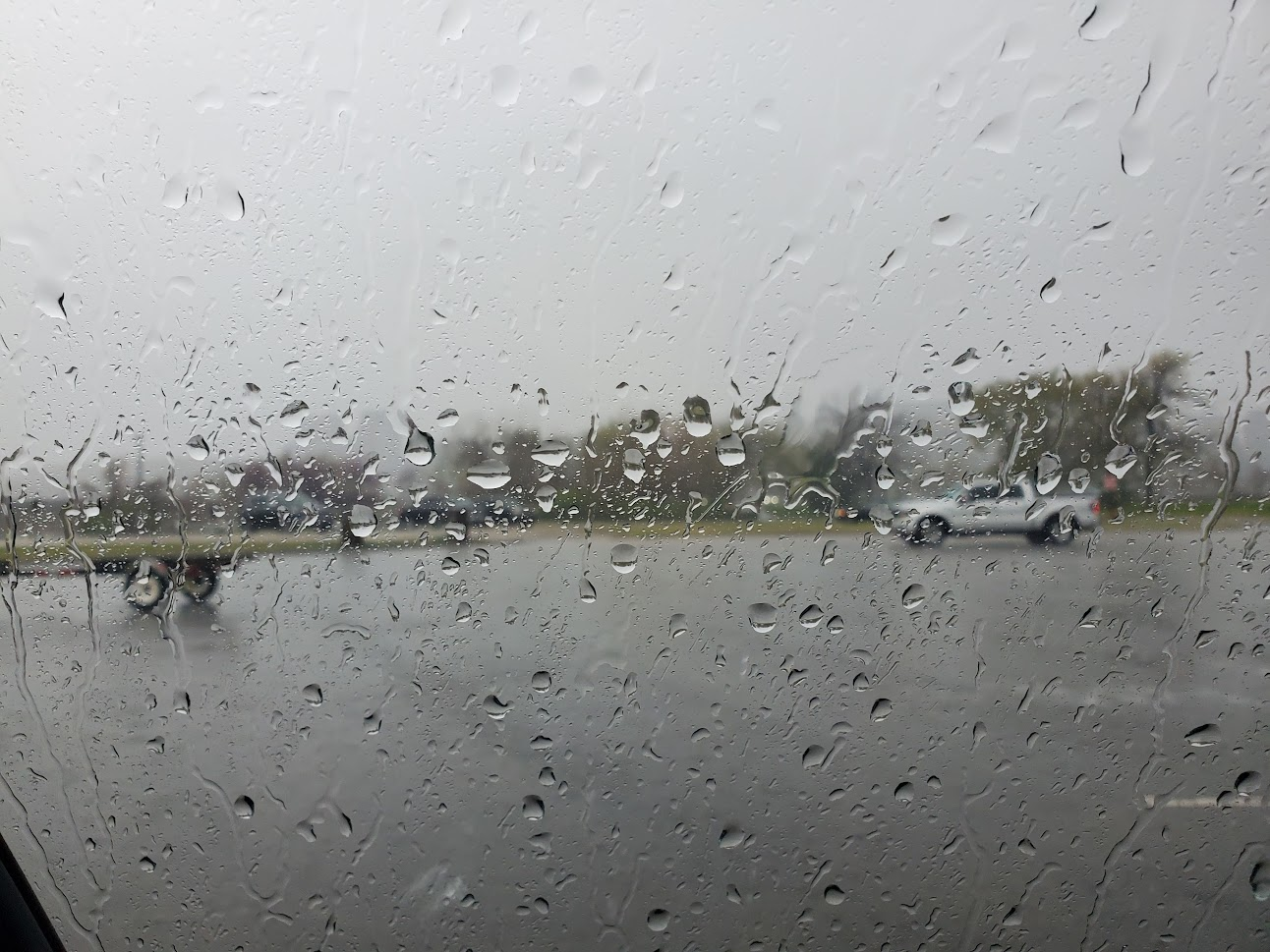
My car had been in the shop for 10 days for some repairs and I very quickly was reminded how much I've gotten used to having a mobile HF setup in the car. Suddenly, my impromptu activations before work were no longer an option, and I missed getting on the air on the way to the office. Thankfully, I got the call last night that my car was ready and I was able to scratch the POTA itch that had been calling to me for so long.
This morning was a dreary one, so it was especially nice to be able to activate from the car. As frequent readers here know, I like to activate in DC on these early morning excursions, but there was a potential wrench thrown into the works. The cherry blossoms by the Tidal Basin and Hains Point are in full bloom. While I love seeing them, so does everyone else, so finding a parking spot, or even getting around down there within the parks I frequent in DC would be a distinct challenge. So I decided to make a stop at Gravelly Point on the George Washington Memorial Parkway which is just before the turn-off into DC at the end of the runway of Washington National Airport in Virginia. Due to its location it is also in 3 other parks: Captain John Smith Chesapeake NHT, Star-Spangled Banner NHT, and Potomac Heritage Trail NST. A 4-fer right off the parkway.
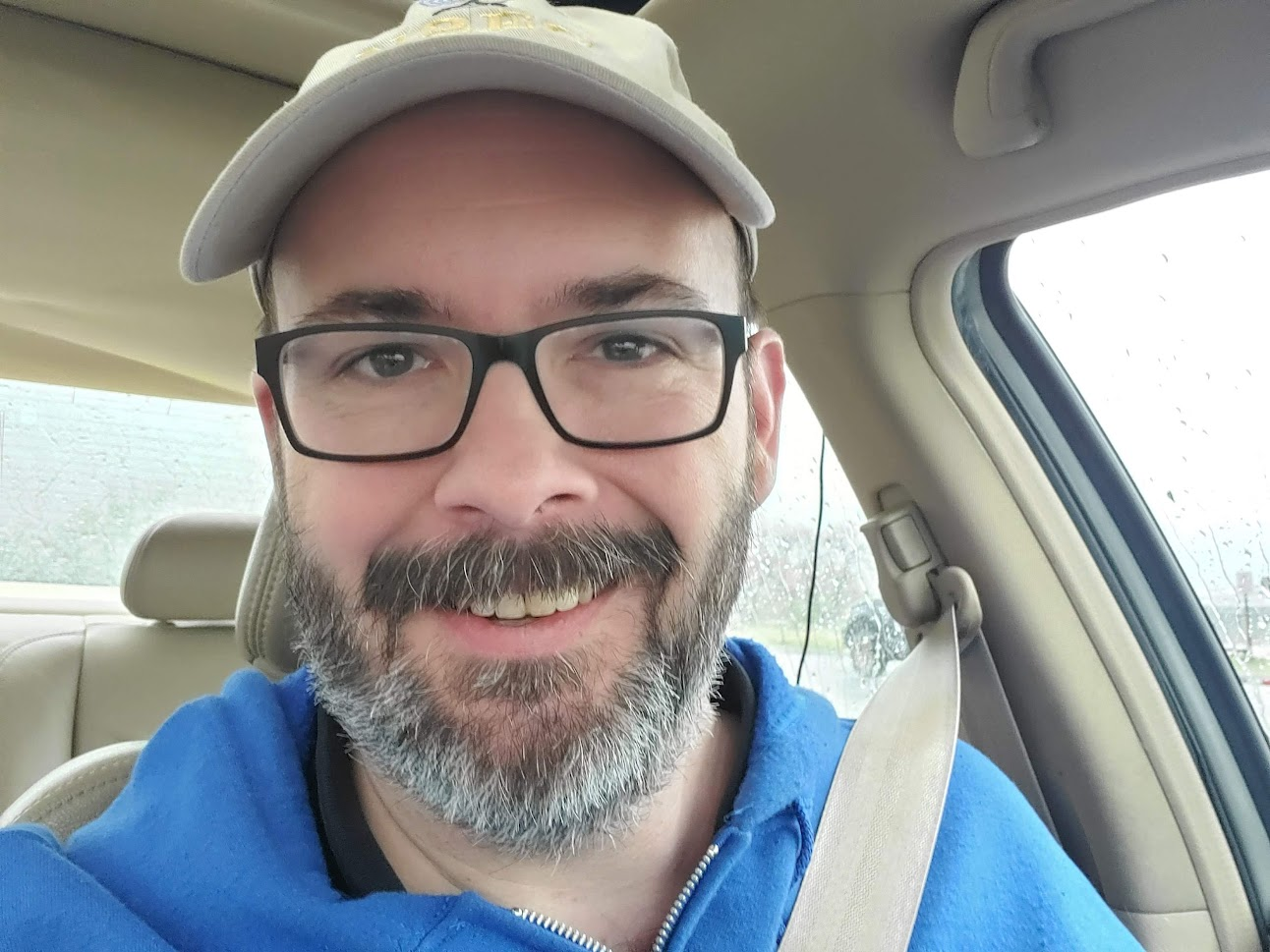
I had been listening to the bands on the commute and heard another activator on 40m CW calling, so once I was safely parked I gave him a call to his park Arabia Mountain National Heritage Area in Georgia. I gave him a 599 and he gave me a 559, and I was off to the races. I decided to move up to the 30m band to get a bit less noise and more distance. After tuning up and sending a few CQs I was answered by a station all the way over in California with a 599 both ways. Next up was Oklahoma, Tennessee, Georgia, and Minnesota. The going was slow, and there was a station 1 kHz below me that moved in shortly after I started and was blasting so loud that he could have been transmitting in the same parking lot. So I decided to move up to the third band of the day, 20m.
After re-establishing myself I got a solid 599 signal from Florida, followed by Oklahoma, and Florida. Then I heard a weak signal at 559 (although at times lower) just down the road in Woodbridge. We were probably just on the edge of shooting our signals over each other, but with some persistence we got it done. Then I got a beautiful signal booming in from an LICW friend, Greg KD5HIZ, in Texas. It was great to get him in the log. Next up was Dan, WD4DAN, who also had a booming signal from Georgia. Nice to get 2 familiar calls back-to-back.
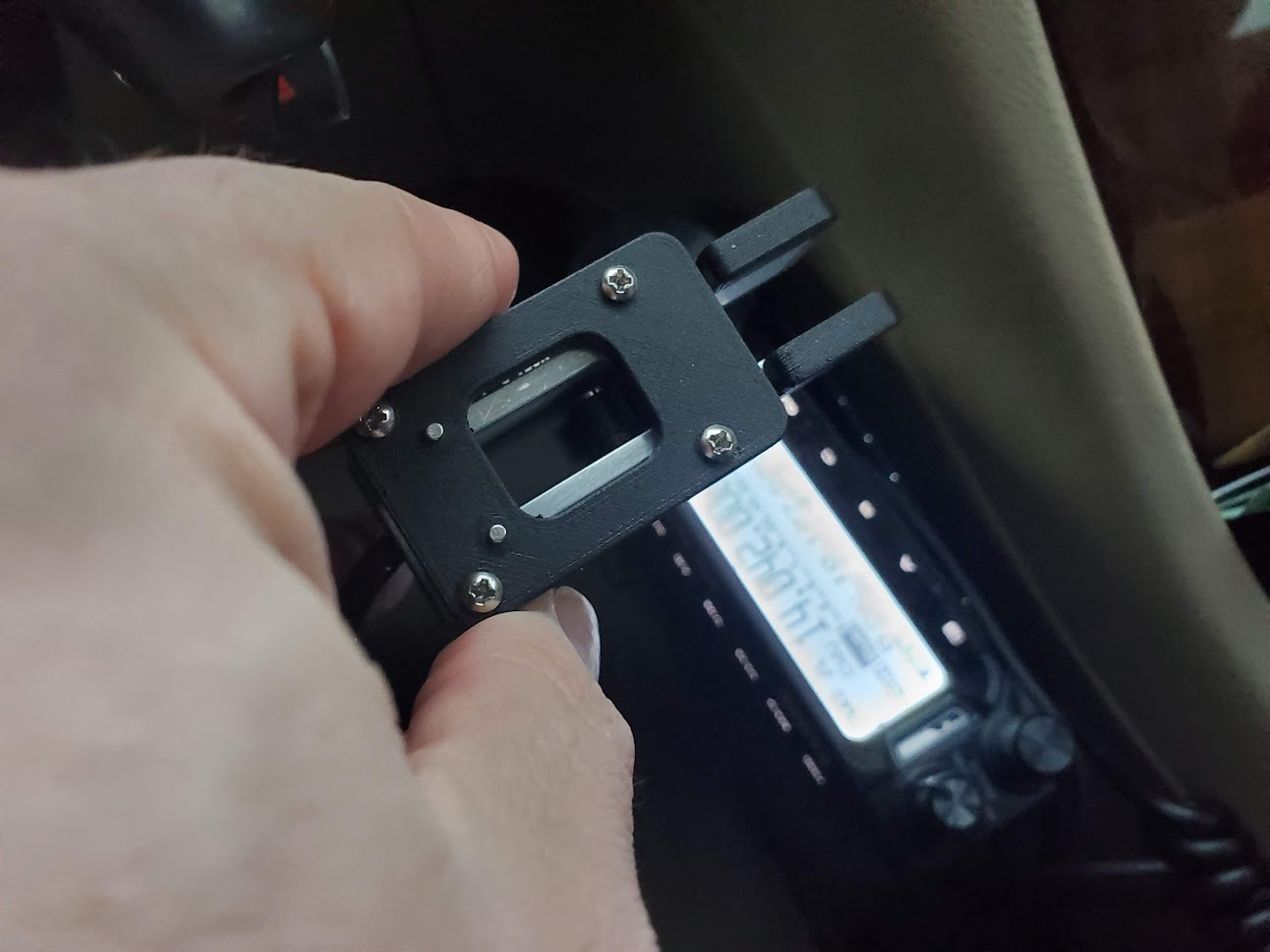
Next up was a signal just down in my noise floor from Maryland, I heard him 539 and he heard me 339, but we did it. Given his location in Northern MD, I am surprised we didn't skip over each other, but we made it. That contact was followed by a pair of strong signals from Florida both with 599 both ways. Finally the last contact of the day was a weak one from Georgia, 539 for me but 599 for him. I looked up at the clock and realized it was time to may my way to the office. 16 contacts in the log on 3 bands and 4 parks in 34 minutes.
The low number of contacts was curious -- it seemed contrary to everything that has been happening with the setup. So I scratched my temple and got into the office and then decided to look at solar conditions. The A index was 60! That explains the challenge right there. I feel lucky I was able to make my activation. I'm glad I didn't look beforehand, as I might have skipped it, and this was definitely a fun one, even if it was at a more leisurely pace. Interestingly enough though, I was getting out. Looking at the Reverse Beacon network, my CQs were heard in Australia (6dB), New Zealand (16dB), Samoa (15db) and Germany (6dB) on 20m, and in Samoa (8dB) on 30m! Interestingly enough, the path for Australia and Samoa were almost completely coincident, even with Samoa being on 2 bands. Now, if only it wasn't the middle of the night for them maybe we could have made a contact.
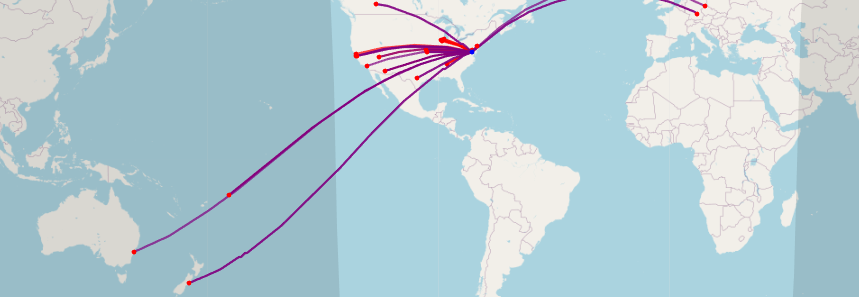
Reverse Beacon Network Map (Where my signal was being heard by the network)
Shortly after the activation, I received an award that I had been working toward, the Early Shift Activator award. I didn't realize that I was activating during that window today, but I guess with the change in Daylight Saving time, it must have shifted by an hour. Nearby parks have it set for 1300 Zulu, so now that is until 9 AM. I suppose that means I will have more Early Shift contacts in my future. This activation also was my 20th activation of the Star-Spangled Banner National Historic Trail, so I was also awarded another Oasis Repeat Offender Award for the park. It is always fun to reach the goals you set for yourself.
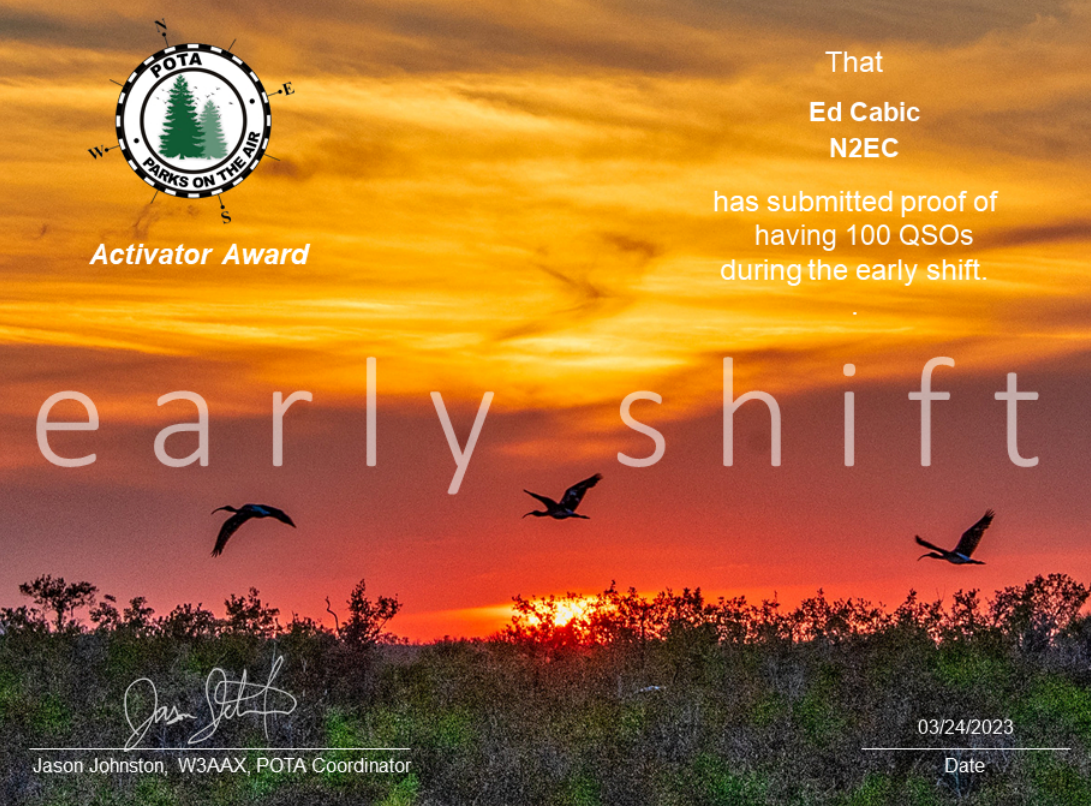
I guess it goes to show, you can only trust the propagation numbers to a certain extent. The only certainty: if you don't give it a try, you won't make the contacts. This was a fun one, and I'm looking forward to more activations in the future.
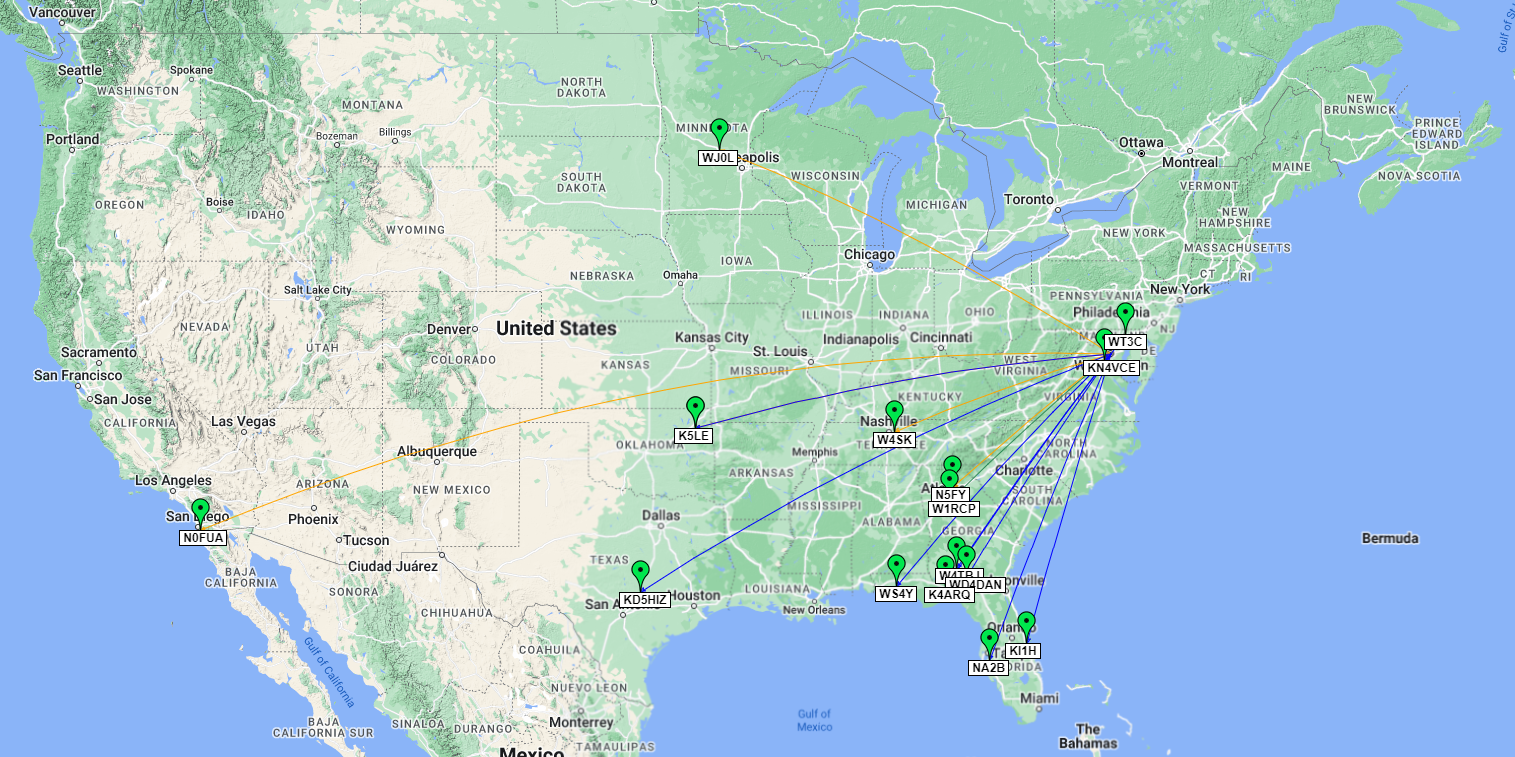
Activation QSO Map: Green Pins = CW / Green Lines = 40m, Orange Lines = 30m, Blue Lines = 20m
Gear used in this activation
- Yaesu FT-891
- Yaesu ATAS 120A Antenna
- CW Morse SP4 POTA/SOTA Mini Morse Code Magnetic Paddle (N0SA Designed)
- 2006 Honda Accord EX V6
- Samsung Galaxy S10+
- HAMRS Logging App
Posted on March 24th, 2023
POTA Activation #53: A 3 Park 2 Mode Activation with My Daughter and Bald Eagles at Widewater State Park, Captain John Smith Chesapeake NHT, and Star-Spangled Banner NHT (2/20/2023) (VA)
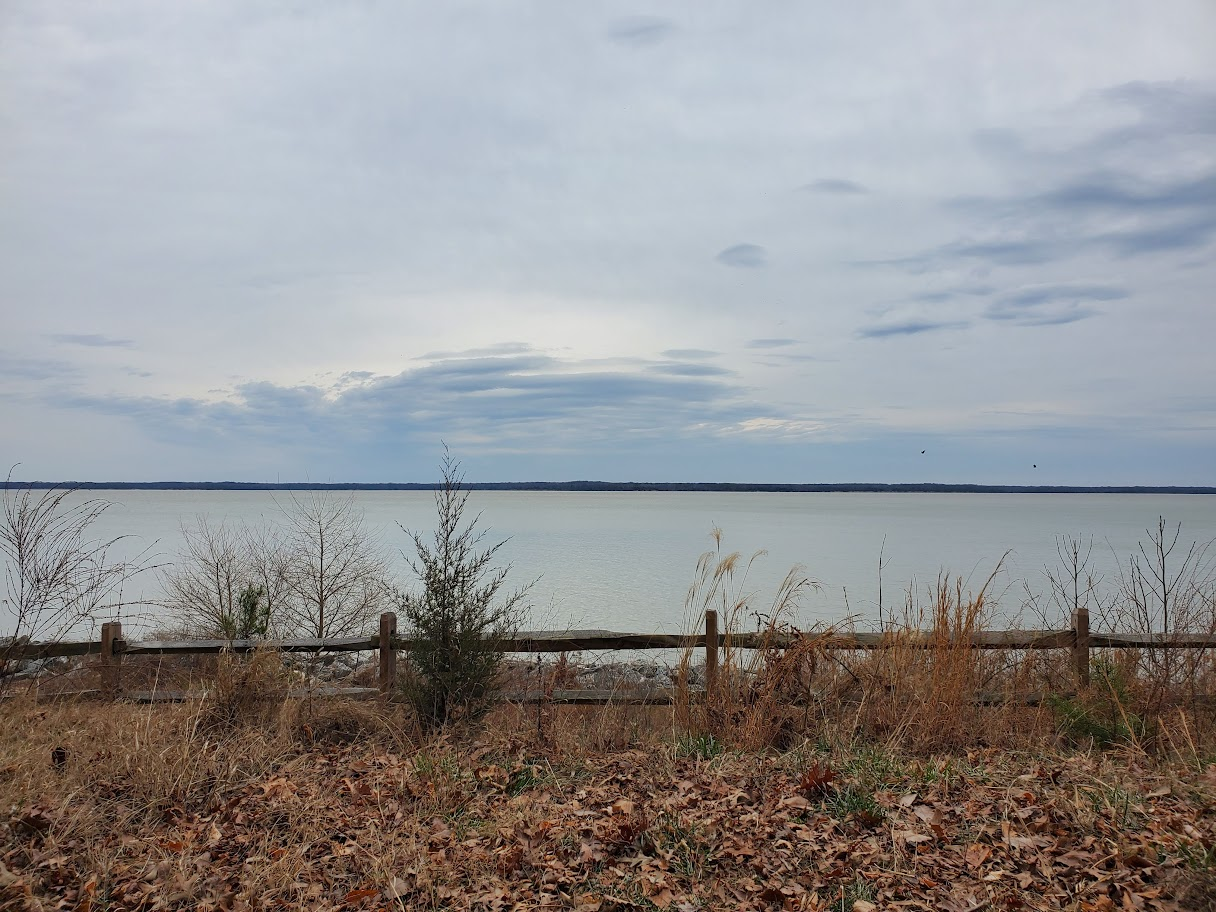
On Presidents Day my daughter had off from school, so she and I decided to visit a new park and do some hiking and exploring. With all my study of the maps for Parks on the Air, I had found some new-to-me parks that were on a short-list for a visit. One that I had been eyeing for a while was Widewater State Park near Stafford, Virginia. The park is on a peninsula at the confluence of the Potomac River and Aquia creek. The park is on the smaller side, with some private property interspersed within and was a relatively recent park addition to the Virginia State Parks. Getting there from Interstate 95 took a bit of winding through some back roads, but when we got there we put on our State Parks pass and went into the visitors center.
Inside the beautiful and brand new facility were a series of exhibits and a gift shop, as well as a glass case with a beautiful snake. My daughter was drawn to take a look and the rangers took the snake out of its glass case and allowed her to hold it briefly. Caitlin really enjoyed that and the rangers answered her questions and gave us some information about some of the best places to visit while in the park.
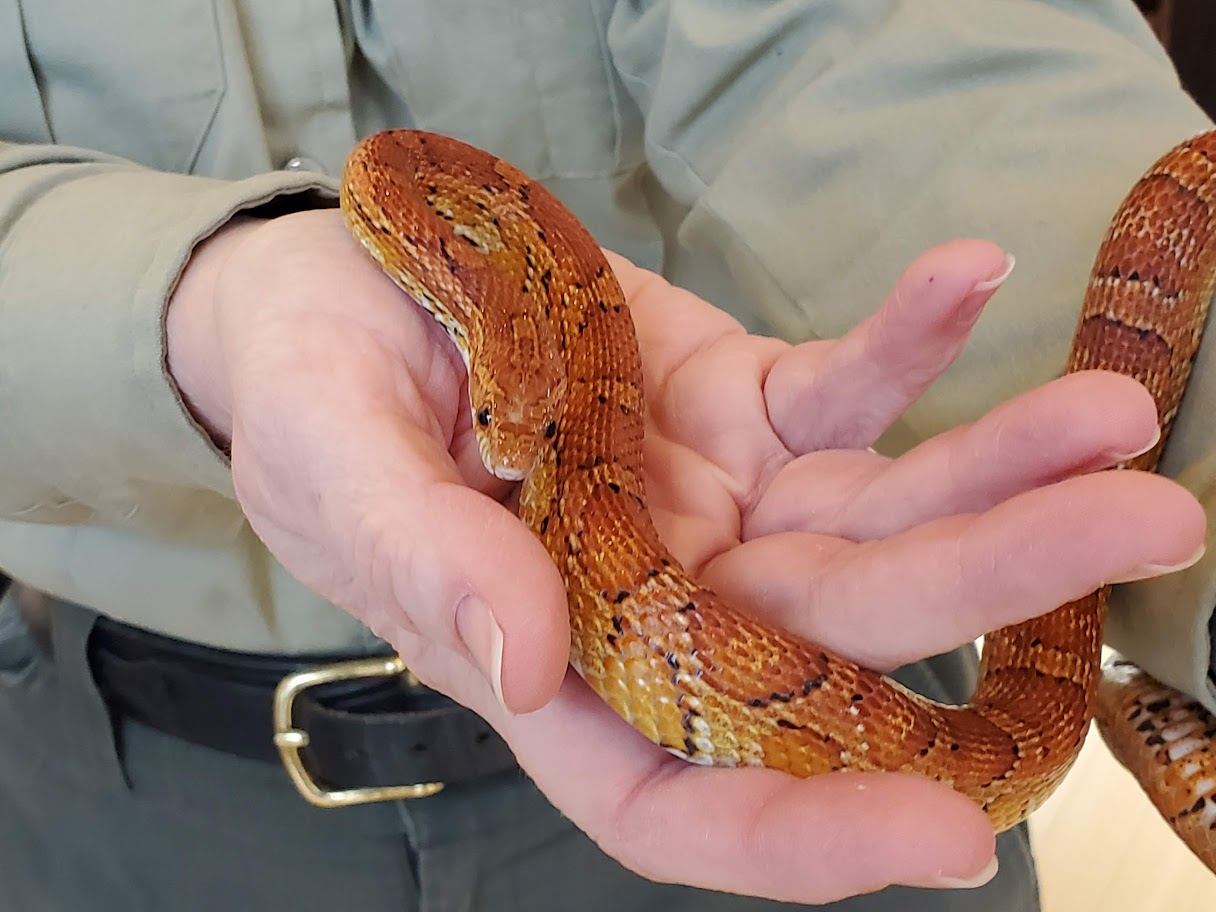
We were told that the Holly Marsh Trail would be a good route to take as it ended on the banks of the Potomac River and was home to numerous Bald Eagles. So we set out on the trail, going along the banks of Long Pond, crossing over Brent Point Road, and then tracing the waterline of Holly Marsh.
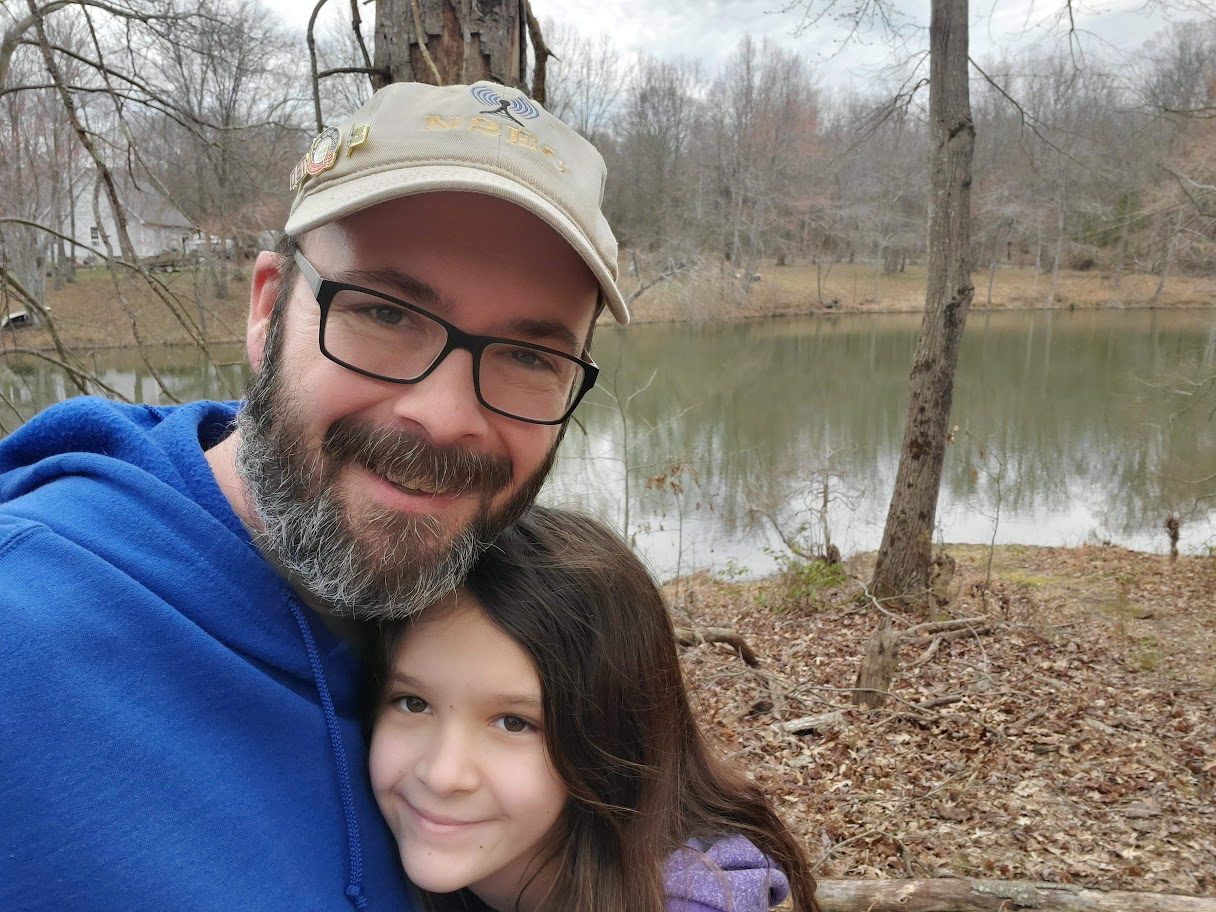
The trail was an easy out-and-back hike, just shy of a mile with gentle changes in elevation down by the water. As we made our way along, we heard the cries of many species of birds and saw a few gliding over the water. When we made our way around the mouth of the marsh where it opened into the Potomac, we were greeted by a rather large fish carcass, still mostly intact. This was one of our first indicators that there were plenty of eagles in the area.
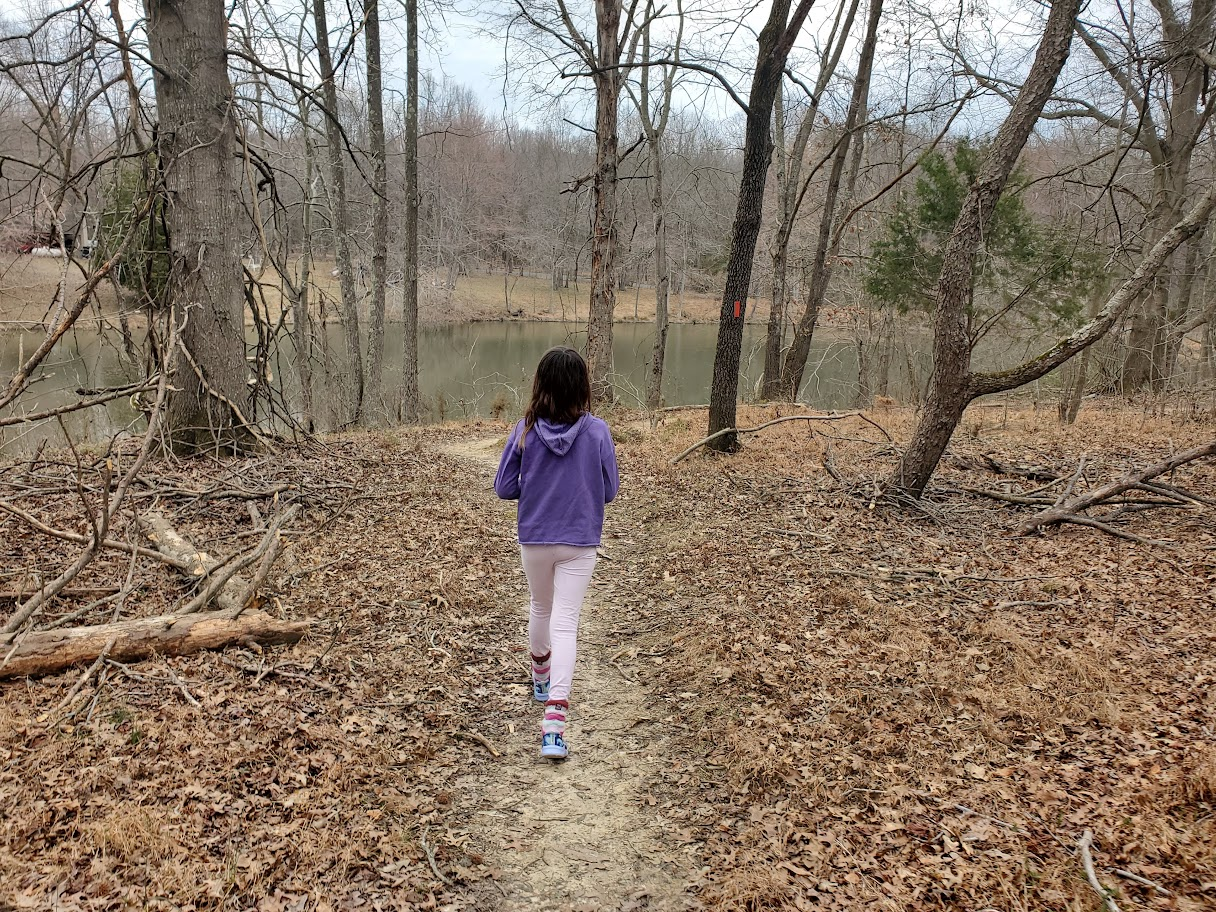
When we made it to the banks of the Potomac, we saw what must have been at least a dozen eagles, some young and still having their youthful brown plumage, and others more adult, with their striking white heads. Unfortunately, the only camera I had with me for the day was my cell phone, so pardon the zoomed out image below. As we were taking the path down to a canoe launch, we saw another fish being dropped into the water with a thunderous splash by an eagle just 15 feet away from us in the Potomac. Lunch, evidently, had been served.
After watching the eagles playing in the air and looking majestic in the aeries, we took a look at the picnic area and playground that was there. This would be a great place for an activation. Being on the banks of the Potomac, this was a 3-fer, with Widewater State Park being joined by Captain John Smith Chesapeake NHT and the Star-Spangled Banner NHT. Caitlin could play on the playground and I could play radio for a quick activation. With a plan made, we hiked back to our car, retracing our steps, and enjoying the Winter scenery and pleasant weather.
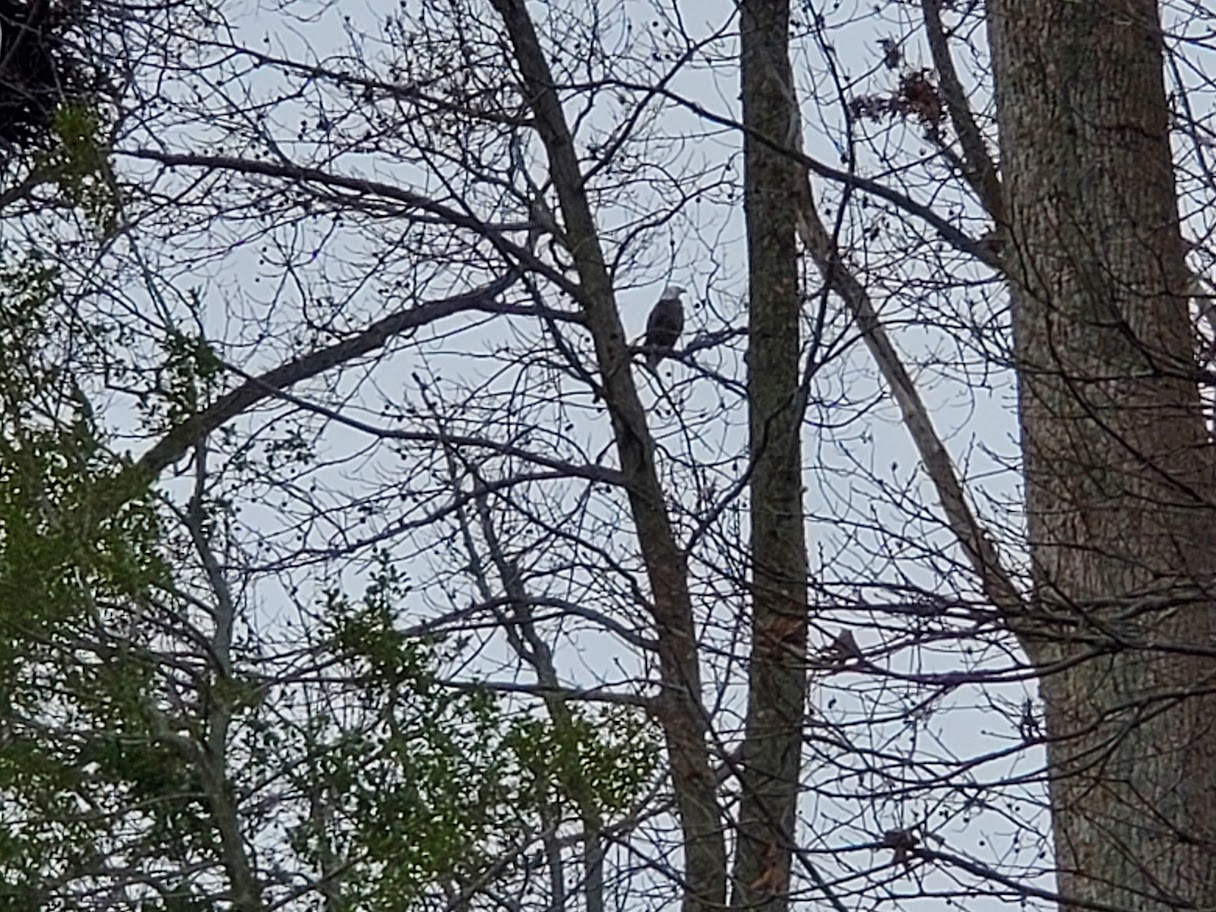
Once back to the starting point, we grabbed a couple ice creams from the visitor center and Caitlin played at the playground near the center, making a new friend along the way. After some play time, we hopped into the car and drove to the picnic area we had hiked to just minutes before. I asked Caitlin if she'd like to do some sideband with me, but the playground beckoned, so I decided to get started with some CW. I decided to start on 20m, to ensure that I could make the 10 needed in case Caitlin got bored and wanted to move on. It didn't take long to get responses once I was spotted, and I got calls from New Jersey, Michigan, and from frequent hunter Dan, WD4DAN in Georgia within the first minute on the air. An auspicious start. Then I got a call from Ontario (Canada) followed by a call from Alaska and NL7V! It had that warble that you sometimes hear from DX, perhaps some auroral distortion, but I heard him clearly and he also gave me a solid signal report. Great to get Paul in the logs again.
Next up I heard from New York, Wisconsin, Ontario (Canada), South Carolina, Maryland, New York, Louisiana, Florida, South Carolina, Maine, Missouri, Massachusetts, Illinois, then frequent hunter KJ7DT in Idaho, then Montana, Virginia, Georgia, New York, Illinois, Arkansas, South Carolina, Michigan, Florida, and North Carolina. Then I was surprised with one of the most dit-laden DX calls I have ever heard ... EI5JL from Ireland. In one go I had reached from North Pole, Alaska to Dublin, Ireland! What fun. I got 31 contacts on CW in 39 minutes.
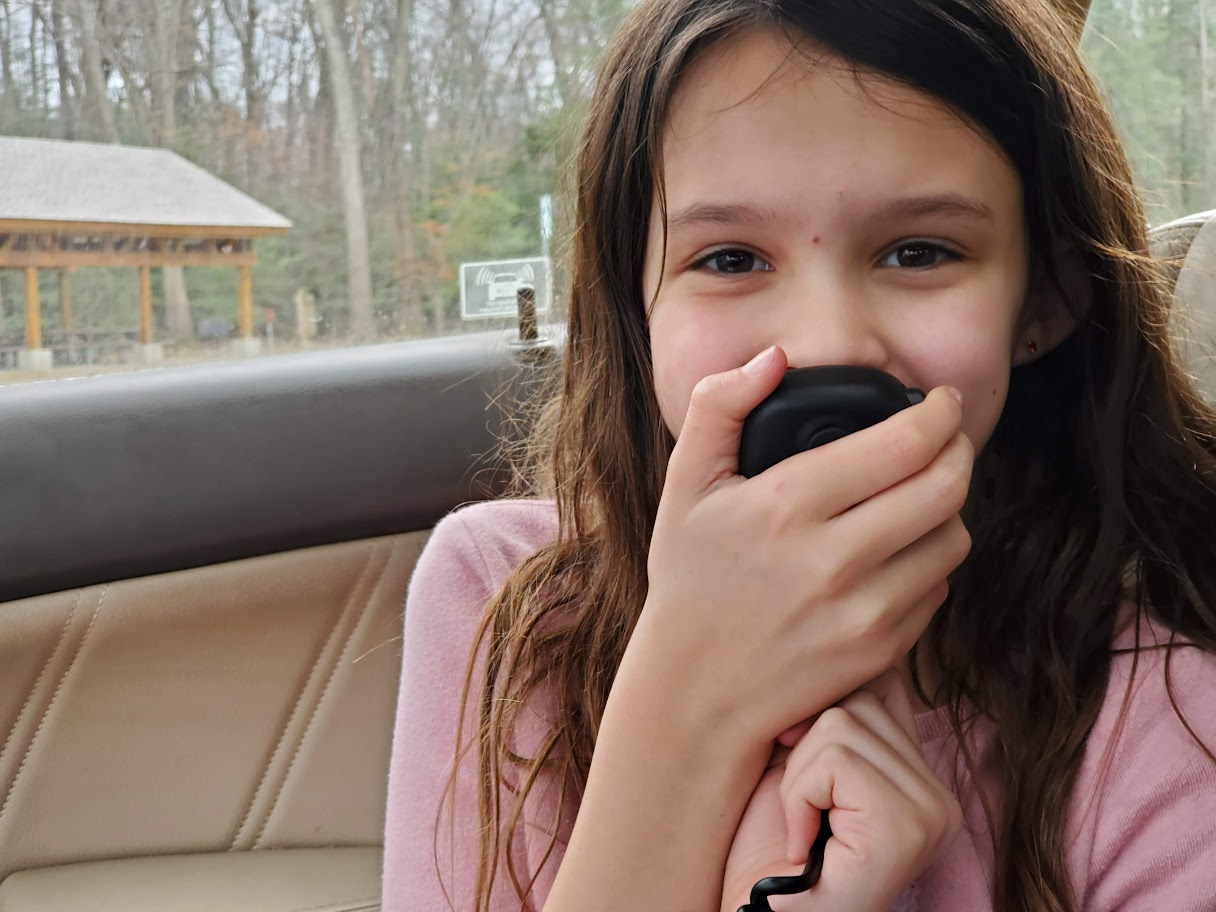
My daughter had had her fill of time on the playground and came back and asked if she could take me up on the offer to allow her to operate sideband under my call sign. I was delighted to hear this, and I quickly wrote out the script she would need to follow on-the-air. We found a clear patch of frequency on 20m, got spotted, and she started calling CQ. After a few calls, she got a response from Tennessee. As usual the POTA hunters were kind and patient and Caitlin did a great job on the air. I handled logging duties for her and passed along the signal reports for her to give. Next up was a pair of stations in Michigan, Massachusetts, and Ontario, Canada. Caitlin was starting to get quite the pile-up! She even asked me the best question of the day "Why are so many people talking at once?". I had to smile and I was proud of her keeping her cool in the pile-up.
I logged the calls that I could hear so she could read them back, or would give her partials I heard out of the pile-up so she could ask for repeats. She was a real pro and even said "This is fun, I want to get my license". Music to my ears. We got another pair of calls from Tennessee, another from Michigan, Arkansas, Georgia, and Indiana. Finally we heard another young voice who asked Caitlin how old she was and then told her he was 14 and that she was doing a great job. All-in-all she got 12 contacts on SSB in 9 minutes and decided it was time to head home.
Lots of fun and a great day out with my daughter. I can't wait to do it again soon.
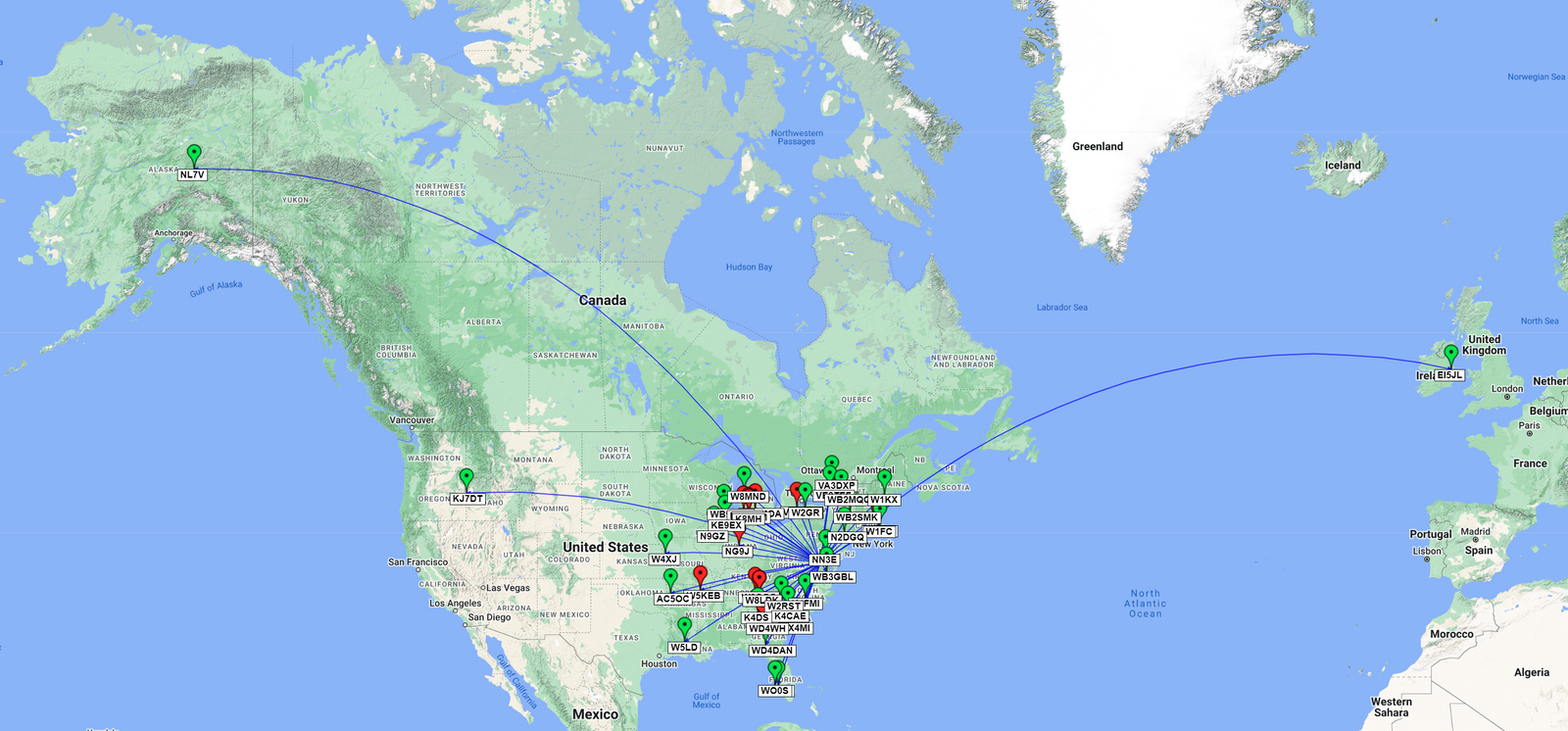
International Activation QSO Map: Green Pins = CW, Red Pins = SSB / Blue Lines = 20m
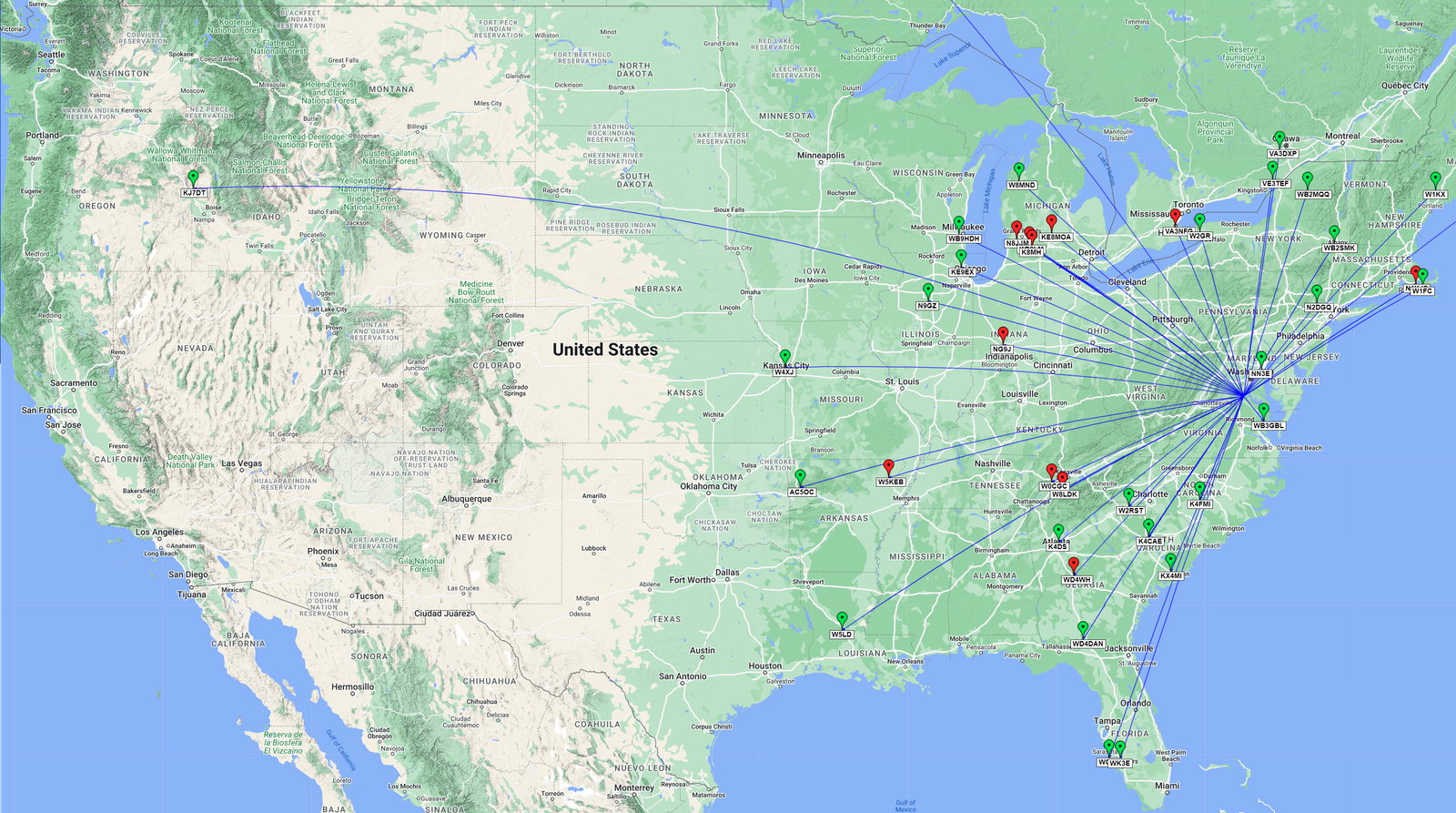
Domestic Activation QSO Map: Green Pins = CW, Red Pins = SSB / Blue Lines = 20m
Gear used in this activation
- Yaesu FT-891
- Yaesu ATAS 120A Antenna
- CW Morse SP4 POTA/SOTA Mini Morse Code Magnetic Paddle (N0SA Designed)
- 2006 Honda Accord EX V6
- Samsung Galaxy S10+
- HAMRS Logging App
Posted on February 21st, 2023
POTA Activation #52: A 4 Band, 4 Park, 4 Country 100th POTA Park Activation
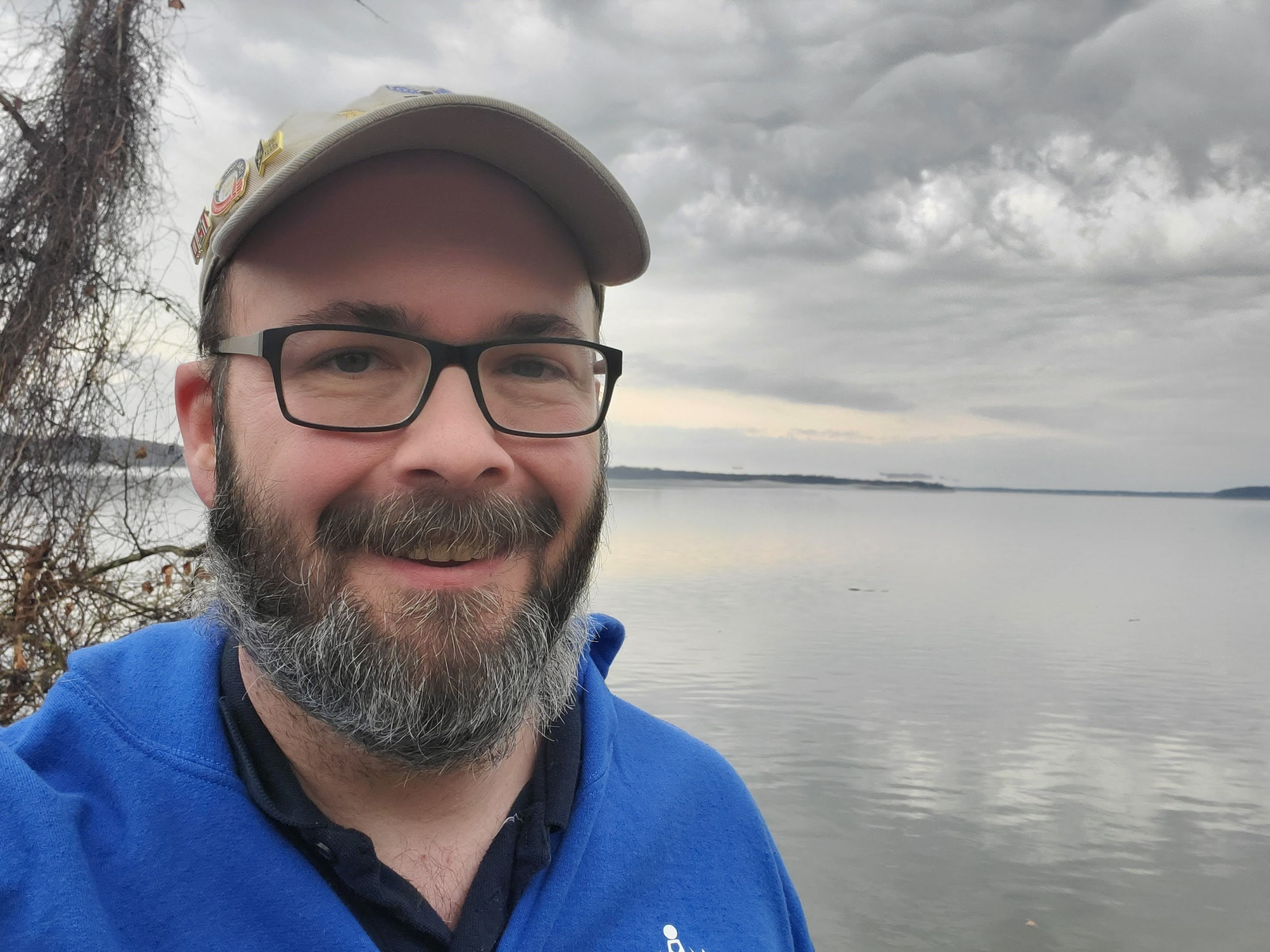
We have been having some unseasonably warm weather of late. Life has been busy, but I have been wanting to get out into a park and activate it ever since my activation last Friday. When I found out that I had an early morning meeting that would make a before-work activation challenging tomorrow, I thought that perhaps using my lunch hour for a quick one might be a good idea. So I decided to go to one of my favorite spots to activate that just so happens to be in 4 parks at once.
Frequent readers of the blog probably have noticed that I number my activations on the title of each post. This particular activation was the 52nd time I have gone out to activate POTA. However, this doesn't tell the story from POTA's perspective. When I activate a park that is in fact multiple parks, each park I am in counts as an activation in the parlance of Parks on the Air. So while today I was out one time, from a statistics perspective on the POTA site, I was really out four times. So if we go based upon that metric -- number of parks activated on a given Zulu day -- today was a special milestone. It included the 100th park activation I have done for Parks on the Air (and also the 97th, 98th, and 99th). Hard to believe in just under a year I have 100 park activations under my belt. It has been a lot of fun.
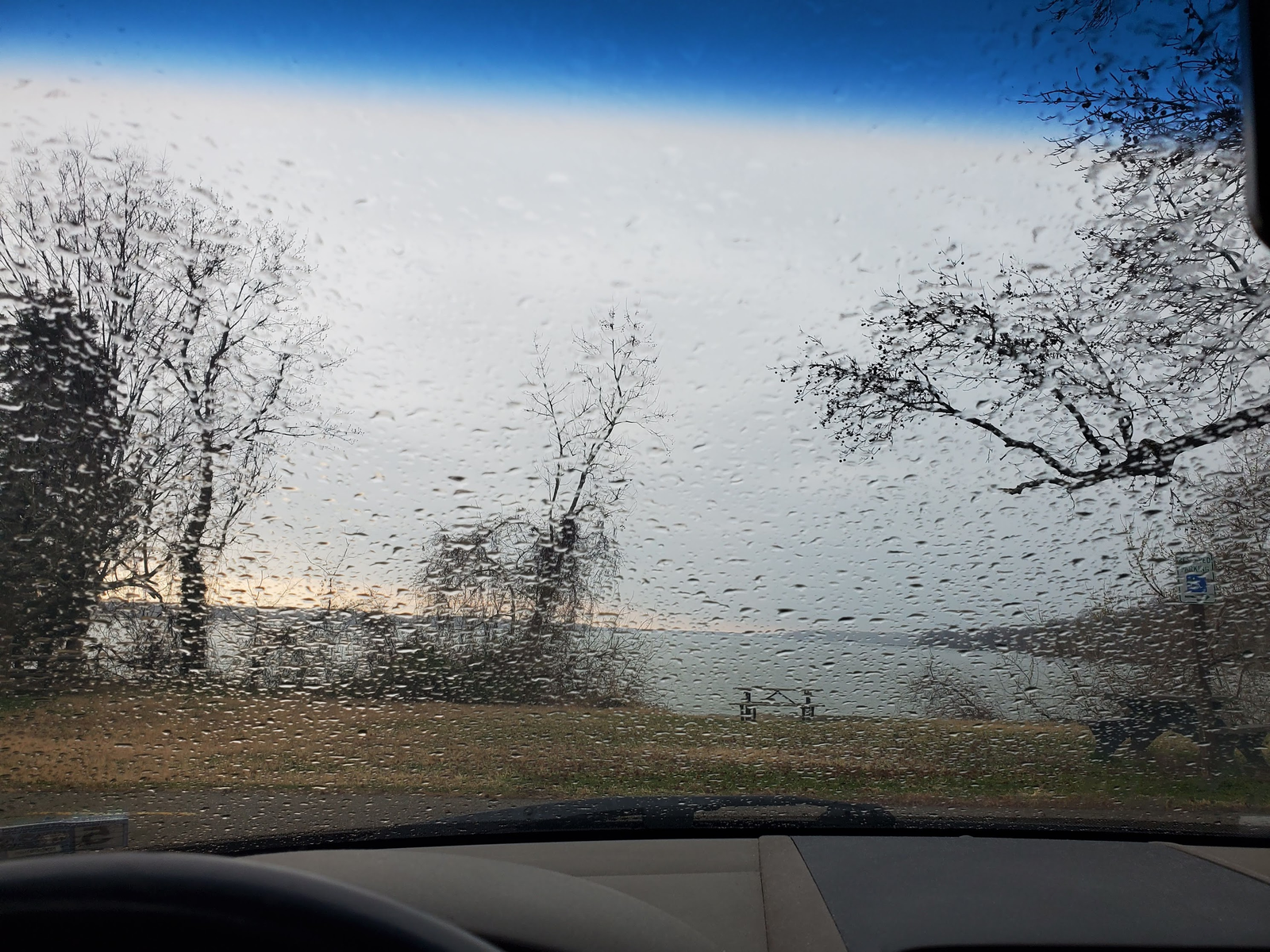
Recently the higher bands have been very productive as we've been ascending sunspot Cycle 25, so I decided to give things a go on 10m first. While I was spotted by the RBN pretty quickly, I didn't get any callers back after a few minutes. I decided to look at the MUF map, and although the rest of the country had a high-enough maximum usable frequency, it appeared that the mid-Atlantic did not. So, I took the hint and moved down to the 15m band, which was well within the frequencies that the forecasters said should be productive. As has become my recent custom, in addition to spotting on the POTA site, I have been dropping a note on the Long Island CW Club talkgroup's group chat, and my first contact was from group member Gregory, TI2GBB, all the way down in Cartago, Costa Rica! I heard him a solid 559 and he got me 599 -- with DX like that my lunchtime activation was off to an auspicious start. Next up I got a call from KJ7DT in Idaho, who has been a frequent hunter of mine on my CW outings. I was very glad to get him in the log again. Next up I got a response from Florida, and then a call from K1NGZ with his mobile bus station in Texas, followed by Michigan, Florida, Alabama, California, Alabama again, another California, and then some serious DX all the way from Germany! Next up was Louisiana and California and then more DX, this time from Spain! What a great run on 15m! I made a few more calls, but heard nothing back, so I decided to work my way down, this time to the 17m band.
After the RBN re-spotted me I was able to work a station in Minnesota, and then got another call from KJ7DT in Idaho. Then things quieted down again for another few minutes and I decided to work my way down again, this time to 20m.
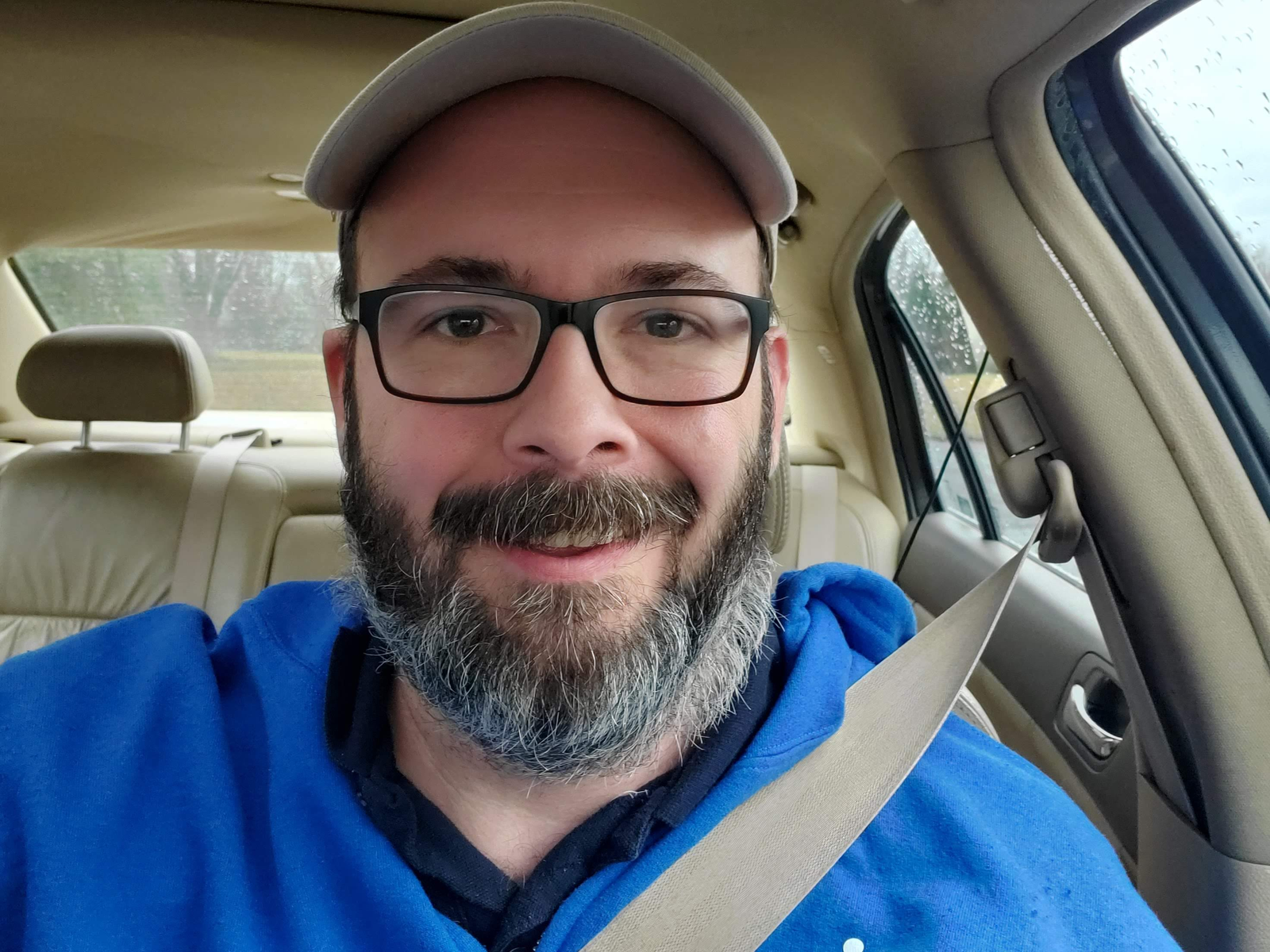
20m is where the calls really started to come in with responses from Pennsylvania, Texas, Georgia, Missouri, Georgia, Texas, Tennessee, New York, Georgia, Colorado, Wisconsin, Iowa, Oregon, Texas, and Kansas. After a nice run, things slowed down there as well -- I guess everybody was out to lunch -- so I decided to do one more move down to the 30m band before calling it an activation. The first response was from Virginia, followed by Missouri, North Carolina, Ohio, and North Carolina again. Looking at the clock I decided to call QRT, but just as I was about to put down the key I got a call from Georgia, so I got him in the log for the last contact of the day. He was very appreciative that I came back even after a QRT call and I am glad I was able to do it.
As my 100th activation came to a close I had 37 contacts in the log in 4 parks from 4 countries in 1:01. Not bad for a lunch break in the rain. In addition to the regular QRM an QRN, I had the pitter patter of rain to contend with, but I definitely enjoyed getting out to the park. Before heading out, I took a brief stroll by the water and enjoyed the beauty of the Potomac. Then it was back home to work.
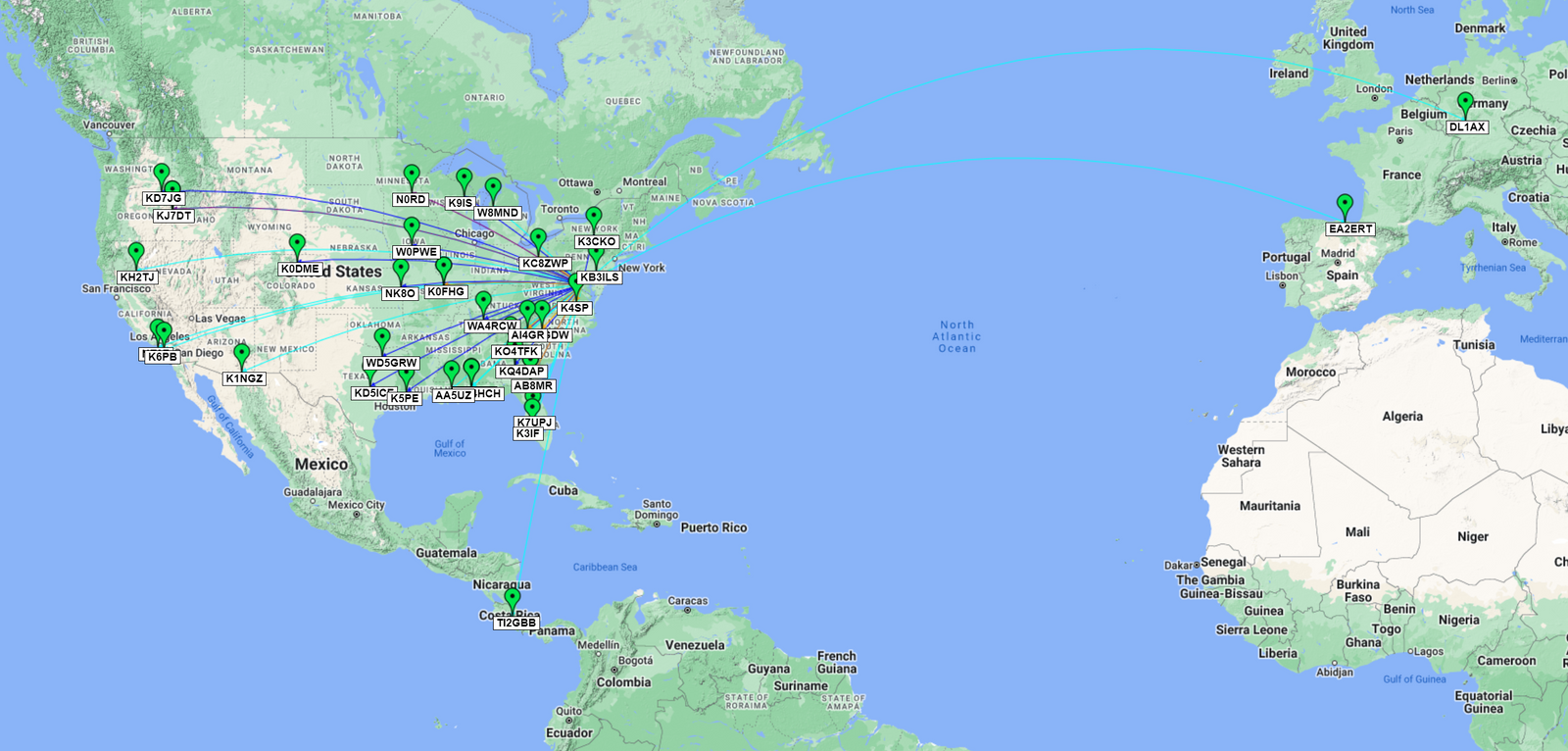
International Activation QSO Map: Green Pins = CW / Orange Lines = 30m, Blue Lines = 20m, Purple Lines = 17m, Cyan Lines = 15m
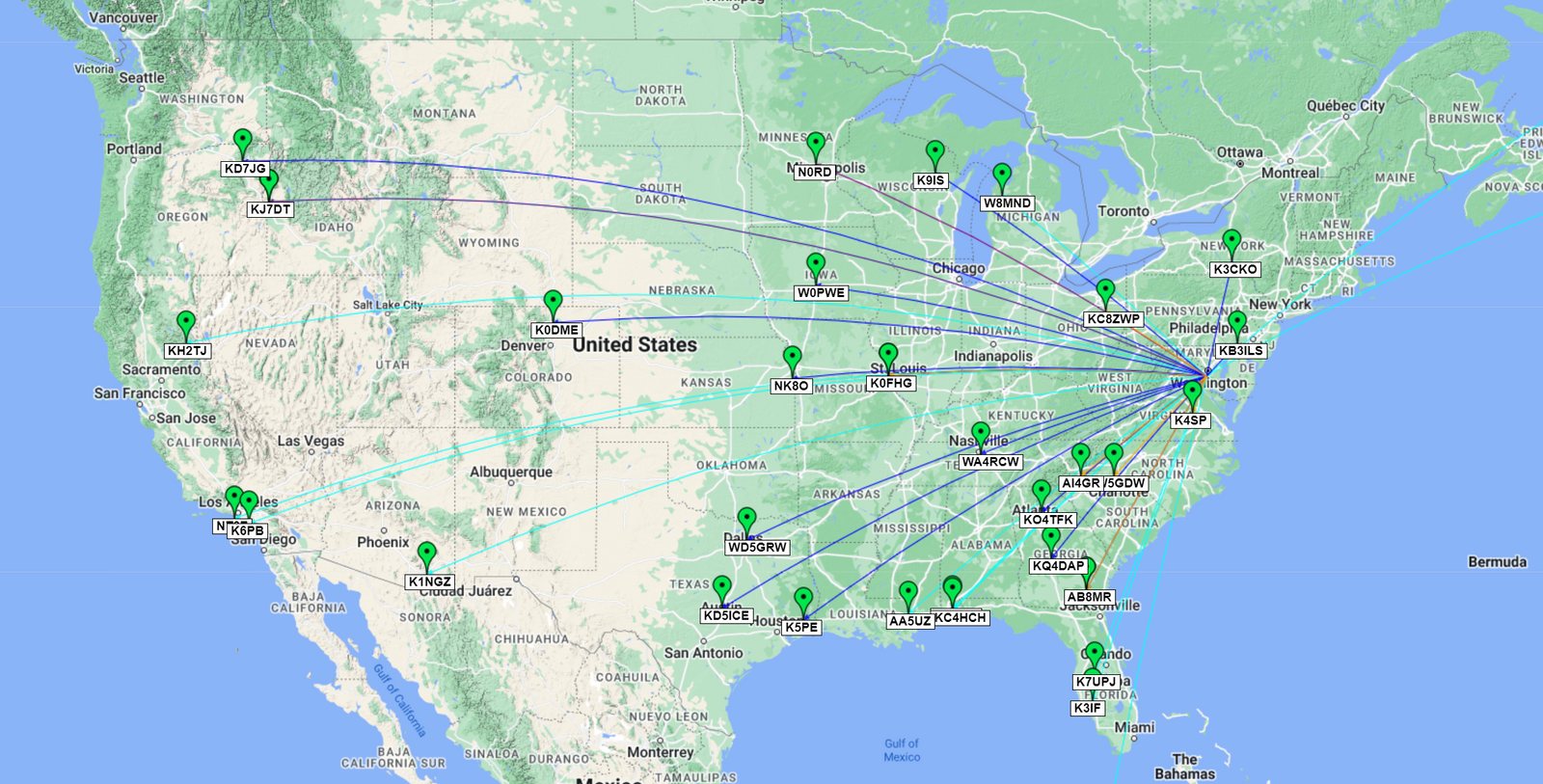
Domestic Activation QSO Map: Green Pins = CW / Orange Lines = 30m, Blue Lines = 20m, Purple Lines = 17m, Cyan Lines = 15m
Gear used in this activation
- Yaesu FT-891
- Yaesu ATAS 120A Antenna
- CW Morse SP4 POTA/SOTA Mini Morse Code Magnetic Paddle (N0SA Designed)
- 2006 Honda Accord EX V6
- Samsung Galaxy S10+
- HAMRS Logging App
Posted on February 16th, 2023
POTA Activation #51: A 3 Band 2-fer on the Commute to Work in Captain John Smith Chesapeake NHT and Star-Spangled Banner NHT (DC) (2/10/2023)

After joining some friends for in a park to test some antennas earlier in the week on my lunch break, I felt the need to scratch the POTA "itch". The weather in the DC area has been unseasonably pleasant, so I definitely didn't need any prodding to get into the parks. I set my alarm for the pre-dawn hours and decided to see if I could get a jump on the day and get in another before work activation in DC. If the stars aligned, maybe I could get a few Early Shift QSOs in the log.
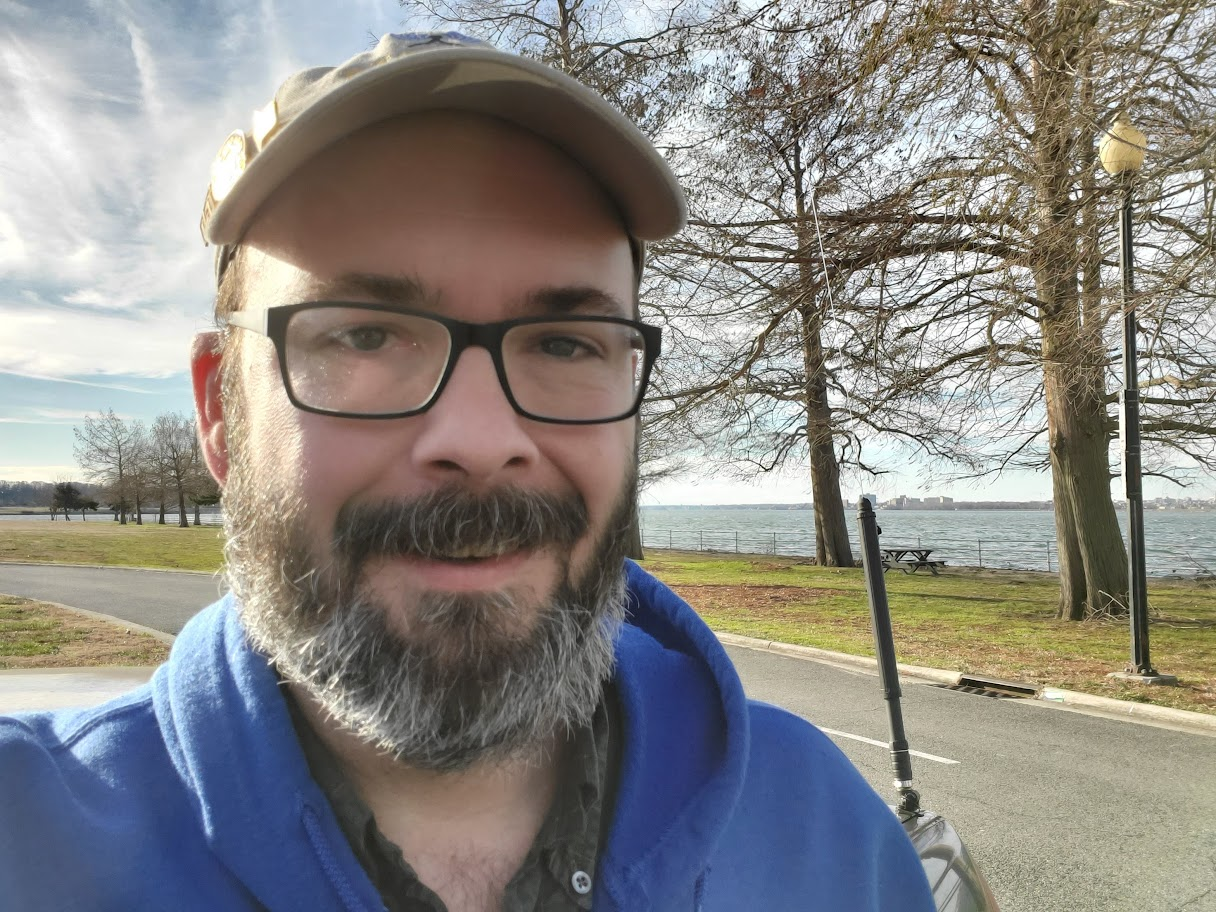
So I drove into the District of Columbia, watching the sun rise over the shimmering Potomac river and got myself QRV and spotted on the POTA spotting page and also with some friends on the LICW group chat.
I started on 40m and it didn't take long for me to get a call from Illinois, 559 both ways. Next up with my friend Ed, N2GSL, working QRP on a Heathkit HW-9 and sounding great with another 559 both ways report. Always enjoy hearing that 72. Next up I got a call from Virginia, Michigan, New York, Ohio, a call from prolific hunter and activator Joe N3XLS in Pennsylvania, another from North Carolina, Kansas, Maryland, South Carolina, New York, Michigan, Tennessee, North Carolina, and a final one from New York. Knowing that the Solar Flux Index has been high I took a lull in the action as a good time to QSY up to 30m.
After getting the antenna tuned for 10.111 MHz, I called CQ, notified the LICW group, and the RBN re-spotted me. My first two calls were from friends in the LICW group. First up with Rin, W4RIN in Georgia who was coming in well for me at 559 but did the work digging me out of the noise with a 539. Was great to get him in the log. Then I heard Jimmy in Texas, WB5MET, another LICW friend who was soft but readable at 539, the ionosphere was working and this was a lot of fun. Next up I got call from Arkansas, followed by the second contact of the day from Ed, N2GSL making his HW-9 sing with a 559. He was able to pull me out with a 339 and it was great to get him again, 72! Next up I got Joe N3XLS on a second band in PA, and contacts in New York, Maine, Ohio, Massachusetts, Georgia, New Jersey, Virginia, New York, Kansas, Louisiana, Michigan, South Carolina, Ohio, Wisconsin, Kentucky, Michigan, New Jersey, Maine, Missouri, and finally Texas. What a great run on 30m! After a few unanswered CQs, it was time to move one last time to 20m.
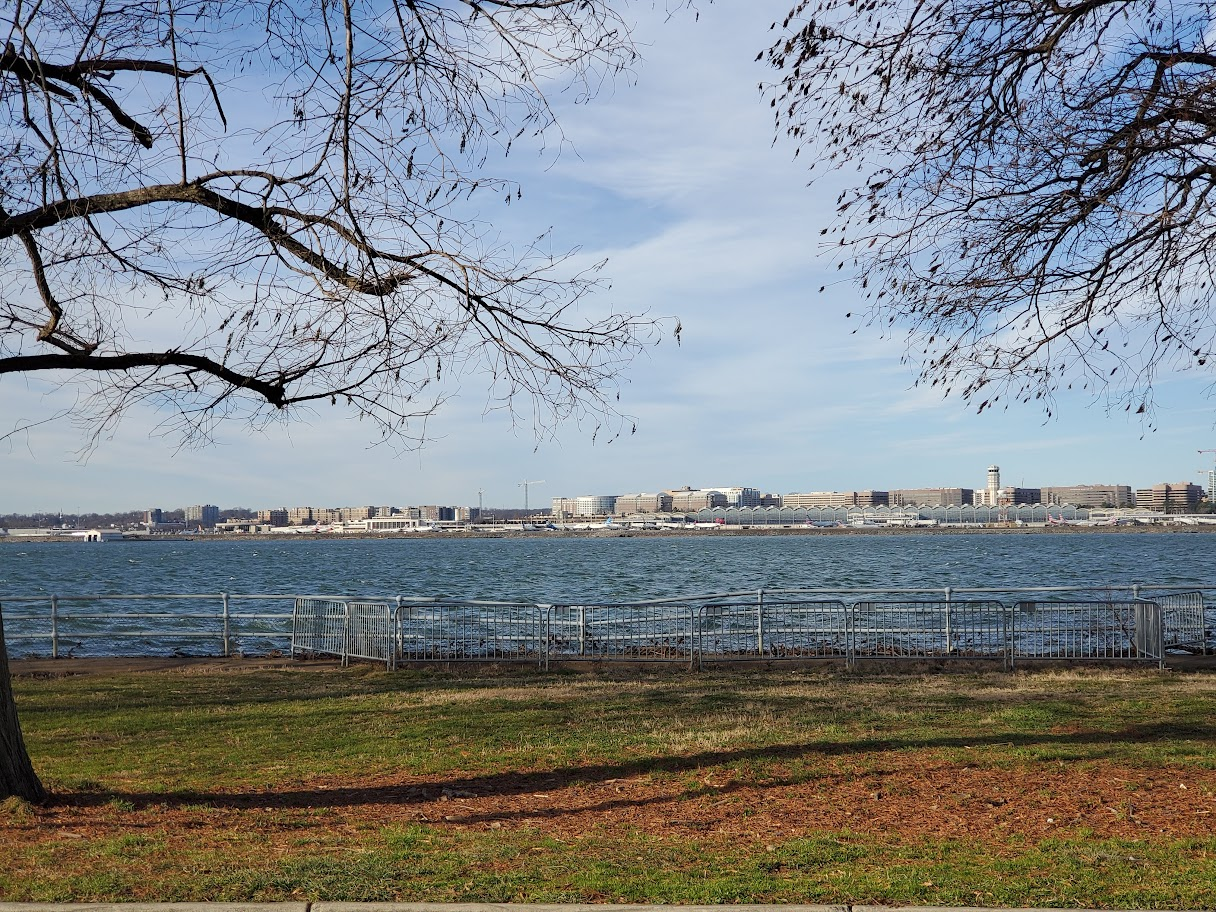
I announced the QSY on the LICW group and let the RBN do its thing, and Rin W4RIN had a nice strong signal on 20m, getting in the log for another band. Great to get another one. I also got another contact from Georgia that was also the second band from N0FUA, followed by Louisiana, Arkansas, a pair from Georgia, Arkansas again, Indiana, Florida, Ontario (Canada), Kentucky, Texas, South Carolina, Connecticut, Florida, Missouri, Illinois, Texas, and New York. Things quieted down after that run and I was about to call QRT when I heard a fragment of a call. First I heard a YZ, so I called back YZ? Then I heard an ON, so I asked for another send. Finally I heard ON7YZ, all the way from Belgium coming in 529! He heard me 559 and I was very happy to get some DX in the log. What fun.
I looked at the clock and realized I had to call QRT and make my way to the office. In 1:17 on the air I worked 61 stations in 3 countries, in 2 parks. 16 of those were during the early shift (so with 2 parks, 32 contacts for POTA). A very successful and very fun outing with a lot of friends and familiar calls in the log.
I also received a new award from Parks on the Air - the Oasis Repeat Offender Activator award for activating K-4567 (Captain John Smith Chesapeake NHT) for the 20th time. How about that? Looks like I am also nearing a Kilo for the park, with the current contact count for K-4567 at 787. I'm getting close to both awards for K-4581 (Star-Spangled Banner NHT) as well.
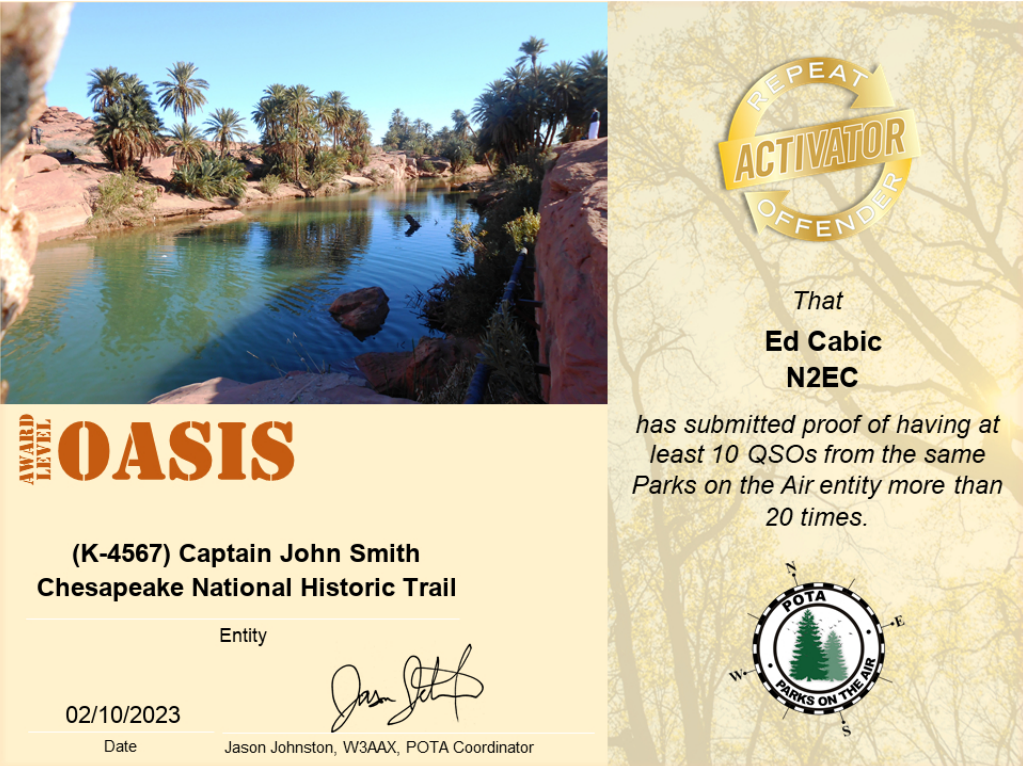
Happy Friday, indeed.
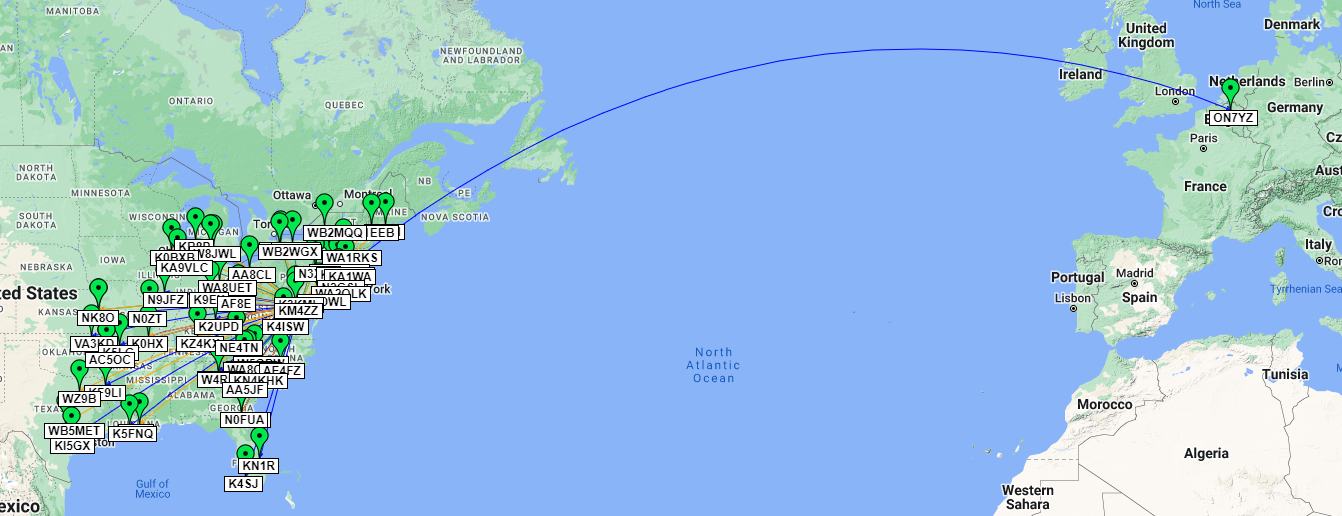
International Activation QSO Map: Green Pins = CW / Green Lines = 40m, Orange Lines = 30m, Blue Lines = 20m
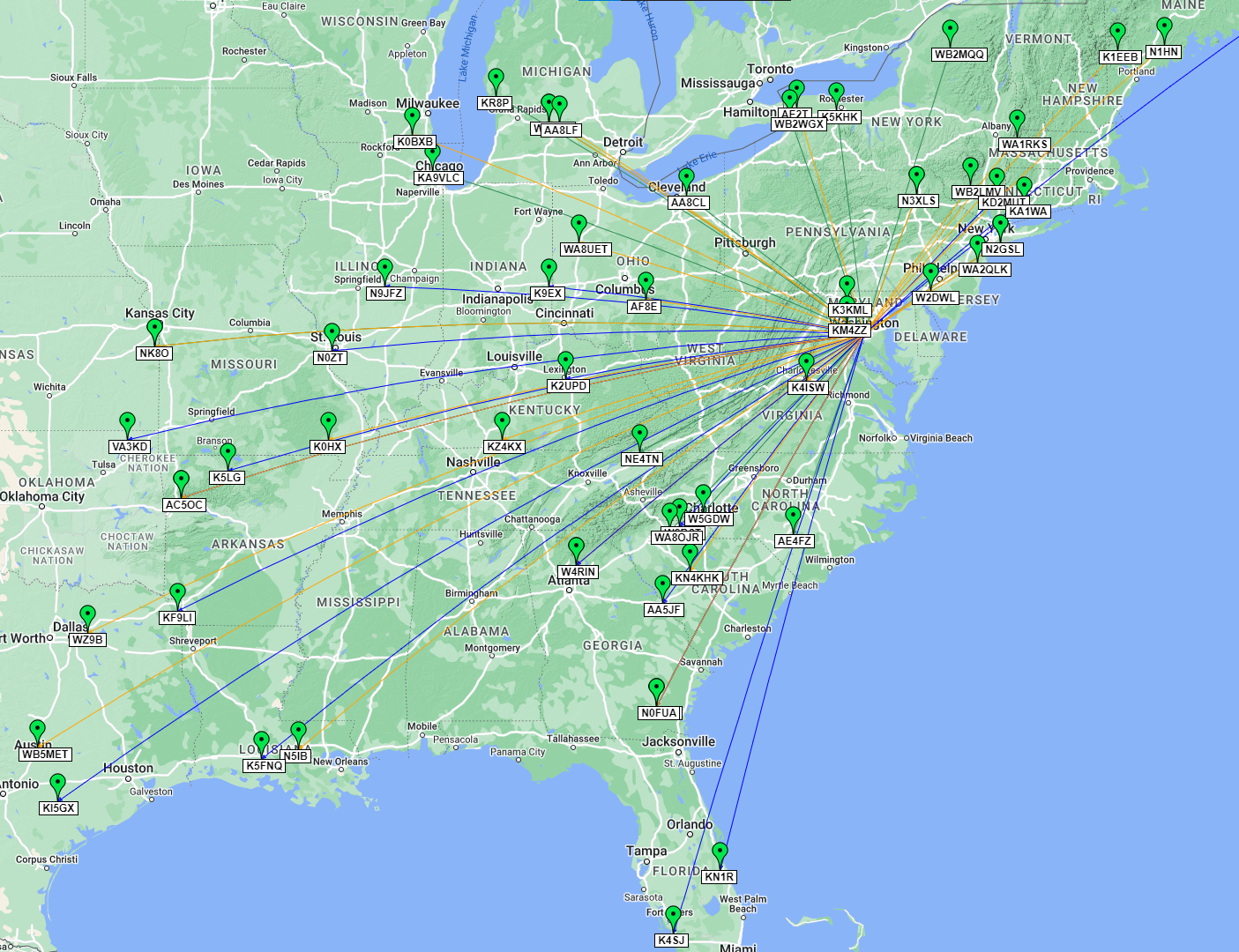
Domestic Activation QSO Map: Green Pins = CW / Green Lines = 40m, Orange Lines = 30m, Blue Lines = 20m
Gear used in this activation
- Yaesu FT-891
- Yaesu ATAS 120A Antenna
- CW Morse SP4 POTA/SOTA Mini Morse Code Magnetic Paddle (N0SA Designed)
- 2006 Honda Accord EX V6
- Samsung Galaxy S10+
- HAMRS Logging App
Posted on February 10th, 2023
POTA Activation #50: A 2-Band 2-fer on the Commute to Work in Captain John Smith Chesapeake NHT and Potomac Heritage Trail NST
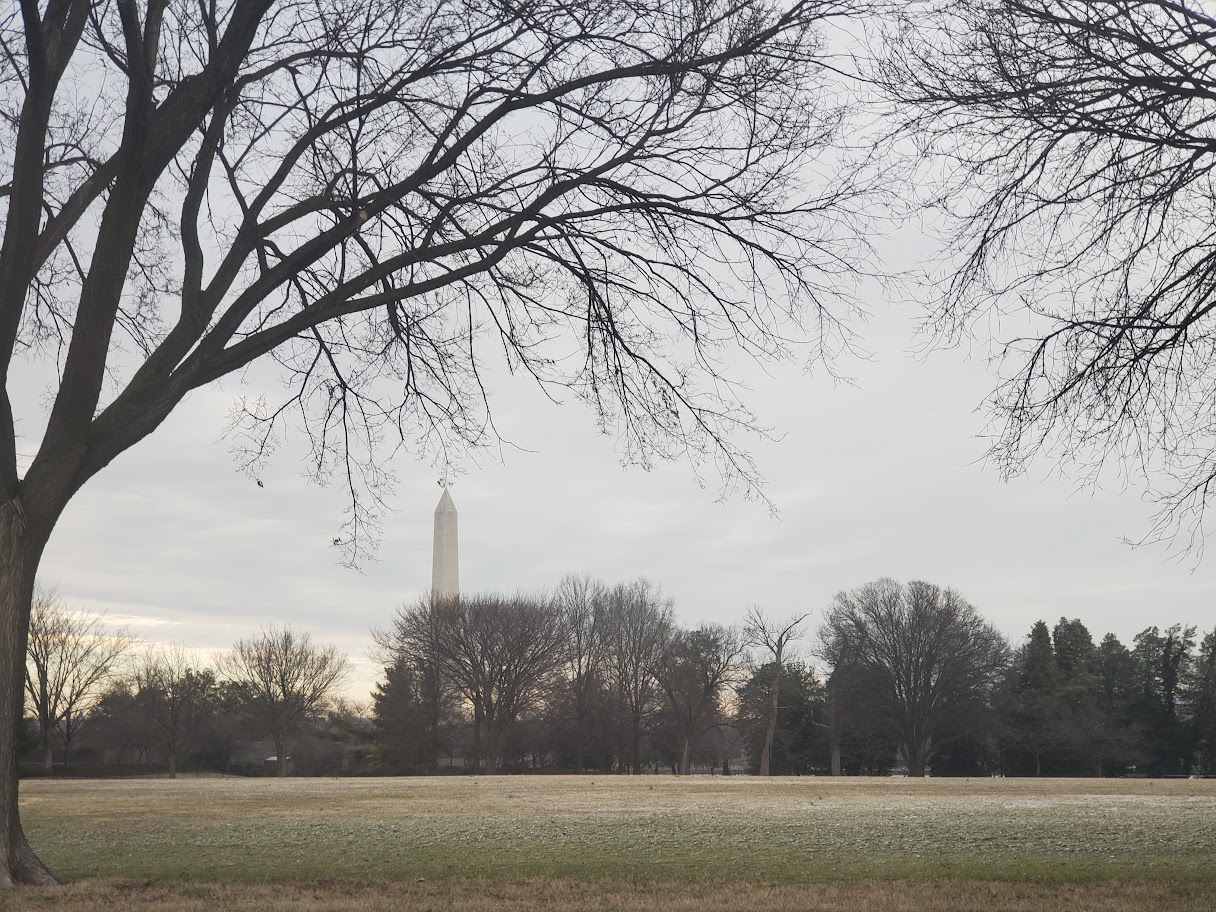
You would think that having hit up 10 parks on the rove I did over the weekend, I'd be wanting a break from activating. Nope. I just can't get enough lately. I had to come into the office today, so I decided to set the alarm for super early and get out into the parks for a morning CW activation. I had some errands to run, so I didn't get the early shift time in as I would have liked, but alas the car needs gas and I needed coffee (both brewed and in bean form), so I had to make some stops on the way into the District.
I was going to do another activation at Hains Point, but when I arrived, the gate was locked, so that was not to be. Thankfully, about a mile from there is another location that is also a 2-fer that I have activated before. You do have to pay for the street parking, but that's a small fee for 2 parks and a lot of fun. The DC area had a dusting of snow overnight, so at home I had clear the windshield. By the time I got into DC there was still a little snow on the grass (as you can see above) but thankfully nothing was sticking on the roads. It was a beautiful morning to activate in the shadow of the Washington Monument and on the banks of the mighty Potomac river.
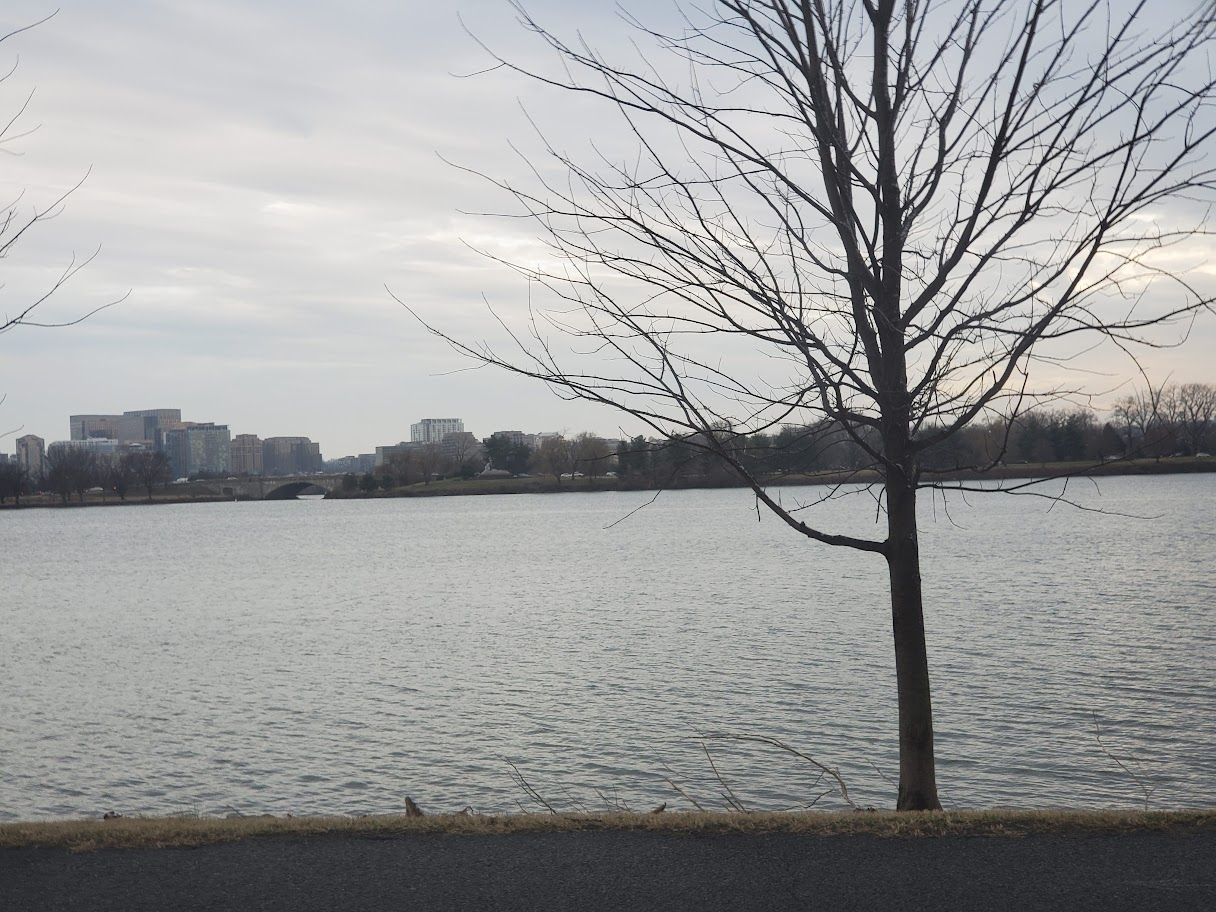
I had mentioned to some Long Island CW Club members the previous evening that I might do a before-work activation, so as I tuned up my radio to the 30m band I sent a note out to our text group that I would soon be QRV on 10.111 MHz. After calling QRL and spotting myself on the POTA page, I was off to the races. My first contact was at 13:00:03 ... so not an Early Shift, but that's okay, I had coffee and life was good. That first contact hailed from Georgia, and the getting was good on 30m. Next came Florida, Michigan, Massachusetts, Ontario (Canada), Illinois, Texas, Connecticut, Florida, Virginia, Maryland, Florida, Indiana, Michigan, New York, Arkansas, Dan from Georgia (for the first of 2 bands for the day), Texas, and Massachusetts.
Then I got a very pleasant surprise and got a call from Chris, N8PEM from the Long Island CW Club out of Ohio. He teaches one of my favorite intermediate CW classes and is an all-around great guy. I was very happy to get him in the log and have our first on-air QSO. Next up I got a pair of calls from Georgia, including one that would work me on the next band, and finally one last contact on 30m with a station in Michigan. Things slowed down a bit, and I noticed several of the folks on the LICW text group mentioned they could not hear me up in the NY area. So I decided to fix that and QSY down to 40m.
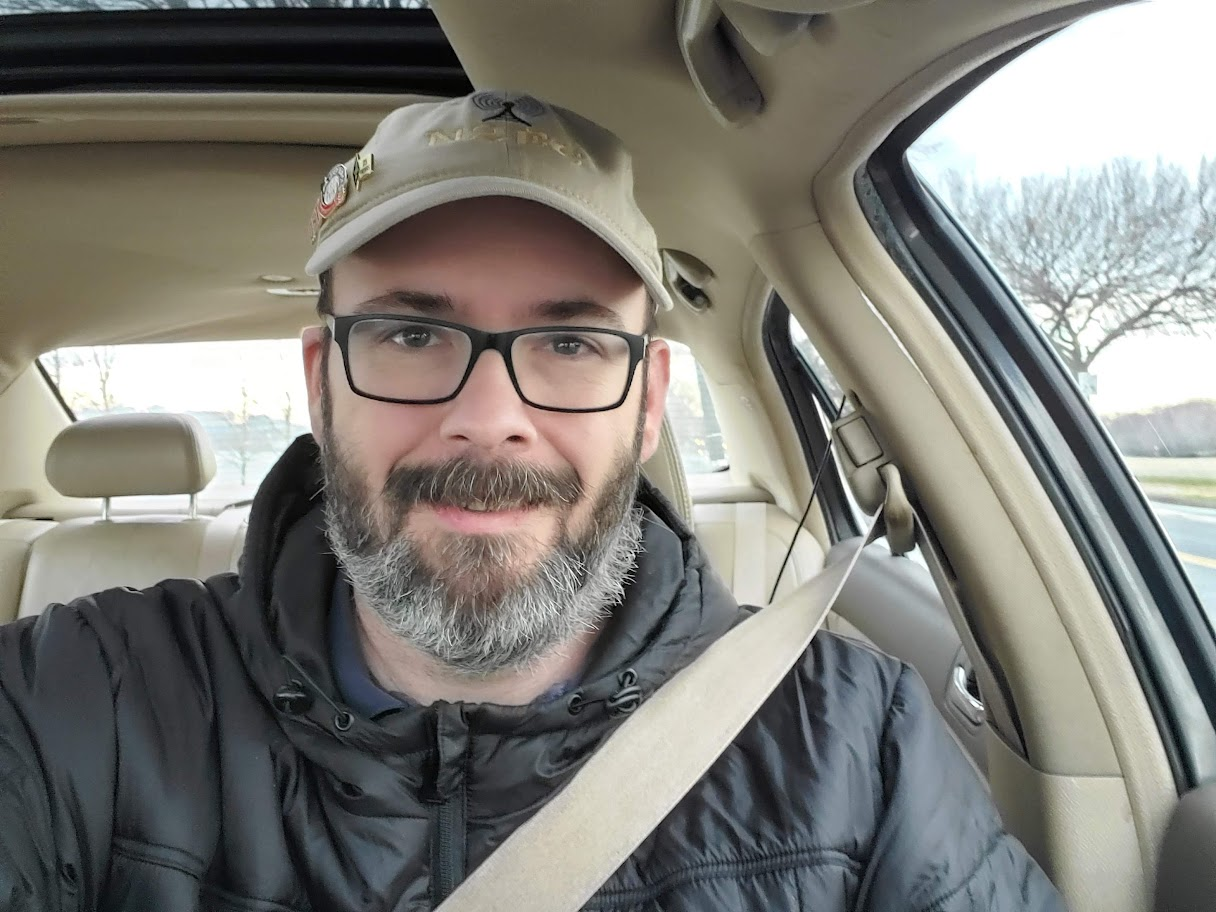
The band was busy -- there must have been a contest or something. At first I started calling around 7.053, but shortly I had someone sending a wall of code over top of me, so I moved up to 7.062 and started calling there and updated the LICW crew. Very quickly I got a call from Virginia and then the pileup came! Wow there were a lot of people on top of each other. I was able to pull out a LICW member, Rin, W4RIN, out of the pileup with a solid signal out of Georgia. It was nice to get him in the log, next up was a station in Michigan, also booming. Then I heard Mike, N2PPI, also of LICW in NY with a solid signal, followed by super-hunter N3XLS in PA. After that I heard a quieter signal just off frequency with an N2 ... I had a hunch that might be Ed, N2GSL of LICW working QRP, so I sent out an N2? and sure enough it was Ed! He had a nice 559 signal on a Heathkit HW-9 and showed how it is done working QRP, making his signal stand out by not zero-beating me. Good to get Ed in the log too, with a 72. Next up the pile-up kept coming with calls from Virginia and Georgia. Then I got Dan, WD4DAN on a second band out o NC, and another big hunter, NE4TN with a big signal out of Tennessee. Then I got calls from West Virginia, Tennessee, a repeat caller from Georgia on a second band, North Carolina, Florida, North Carolina, Georgia, Pennsylvania, Wisconsin, and finally New Hampshire.
I looked at the clock and was faced with the reality that I had to end my activation and get to work. So after 43 contacts in 2 parks on 2 bands, I called QRT and called it an activation. It was great to be able to work so many friends early in the morning. What a great way to start the day.
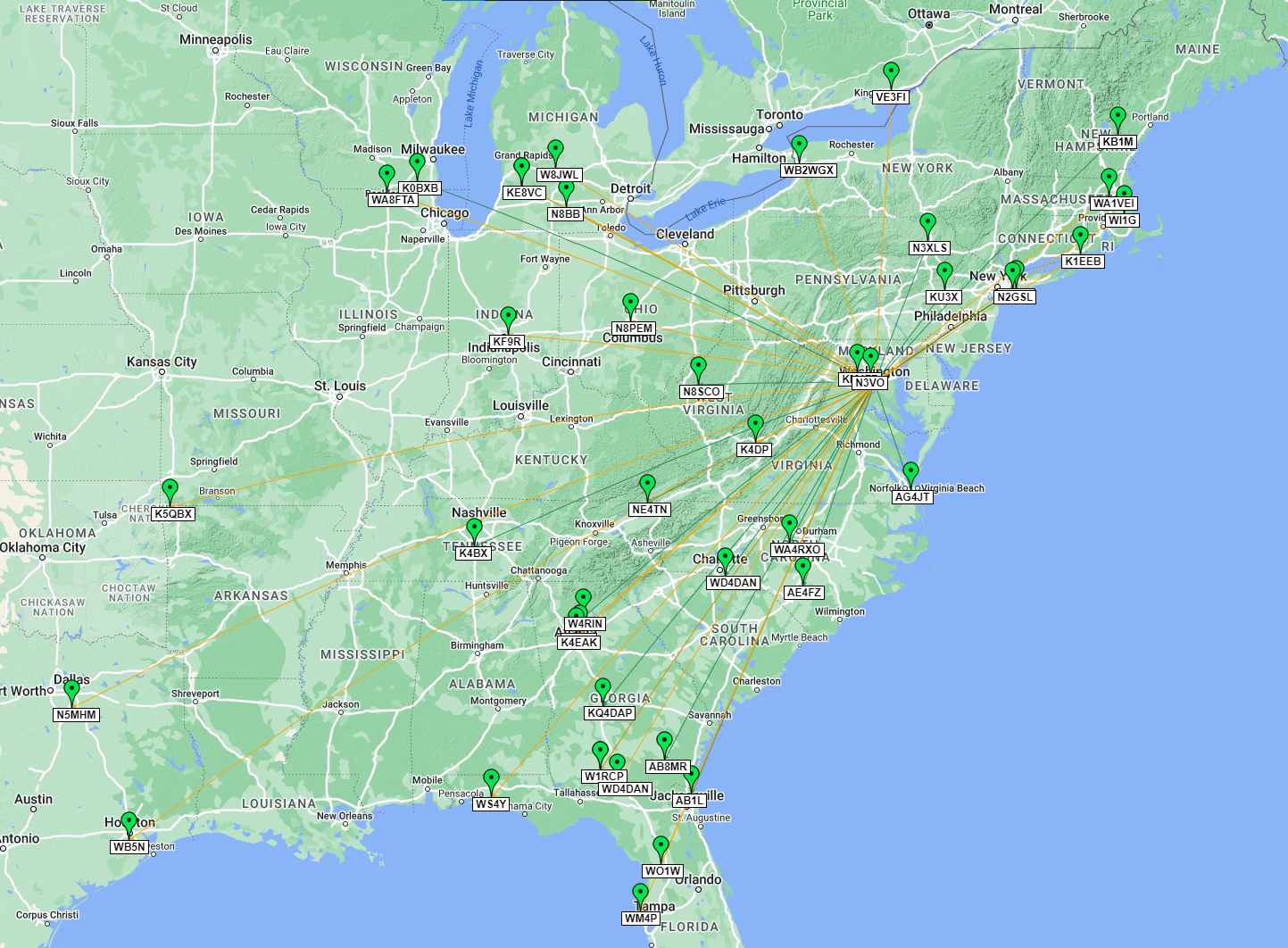
Activation QSO Map: Green Pins = CW / Green Lines = 40m, Orange Lines = 30m
Gear used in this activation
- Yaesu FT-891
- Yaesu ATAS 120A Antenna
- CW Morse SP4 POTA/SOTA Mini Morse Code Magnetic Paddle (N0SA Designed)
- 2006 Honda Accord EX V6
- Samsung Galaxy S10+
- HAMRS Logging App
Posted on February 1st, 2023
POTA Activations #43, #44, #45, #46, #47, #48, and #49: Getting the Rhino Rover Award with Gersohn - 10 Parks in One Day (VA & MD) (1/30/2023)
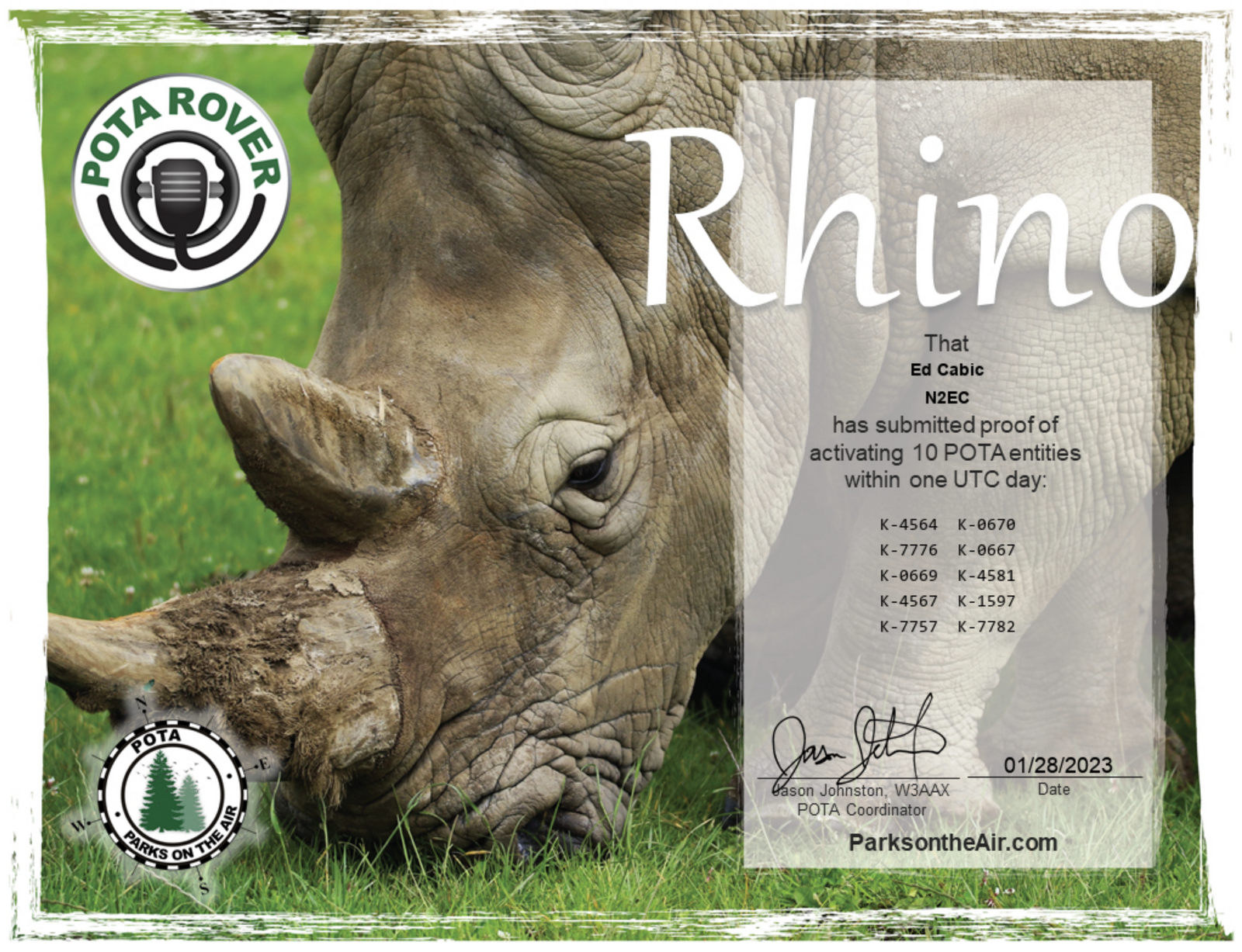
Long-time readers of this blog will know that my buddy Gersohn, KO4IUK, and I like to go out and activate the parks together. Interestingly enough, most of our activations are done in parallel, where we both bring our radios, antennas, and other gear and activate alongside each other. We really haven't done many dual-operator pass-the-mic activations in the past. A while back, while talking about future POTA activations, as we often do, I mentioned that the rules for roves (formerly RADAR runs) had changed. In the past, to do a multi-park RADAR (Rapid Deployment of Amateur Radio) you had to have a certain distance between your activation sites. This made the logistics a bit more challenging, especially since there were different distance minimums based upon your mode of transportation (pedestrian, bicycle, automobile). Because of those requirements, you had to apply for these awards in the past since accreditation was a manual process. I had considered doing a RADAR run under the old system, and had planned out a bicycle mobile path in Downtown DC, but life got in the way and I never got around to it. When they changed the rules a few months back, they took out the distance limits, and the new rules were simply having a certain number of park activations in a Zulu day.
So this got me to thinking ... what would a new rove look like? The biggest challenge in all of these roves was the setup and take-down of equipment. Getting antennas into trees or verticals onto tripods with radials and getting an operating position going. However, I had a new mobile HF setup that has been working phenomenally well from my car. That changes everything. I can roll into a park, tune the ATAS 120A, and get on the air within a minute or so. So where to go? I started looking at the map for Parks on the Air and noticed that there are a lot of parks along the water's edge of the Potomac on the Maryland side of the river, or a few miles inland. Some parks I have already activated, others that were small tracts of wildlife management areas, some were full-blown parks that were new to me.
Awards are given starting at 5 parks in increments of 5 up to 30 parks. So one day I charted out a potential route to 30 parks basically doing a loop from the Woodrow Wilson Bridge (I-95) down to the Nice Bridge (US-301) and back up, finishing up with a spur in DC. That would be an epic undertaking, and I'm not even sure I could do it in a 24 hour period. But it got the wheels in my mind turning. So on Saturday, January 28, 2023, I was at the MVARC club breakfast and was chatting with Gersohn over coffee and we decided this would be a good day for a smaller scale test. After taking my daughter to her piano lesson, I drove over to Gersohn's and we set out to hit up 10 parks in what we had left of the day. We set out a bit after 11 AM from Alexandria, which gave us 8 hours to work with. We felt reasonably confident we could hit 10, but we didn't know if the bands would cooperate. We also didn't factor in that this particular Saturday was during Winter Field Day, so finding spectrum to operate on would be a challenge. We would primarily operate SSB and pass the mic since Gersohn isn't a CW op (yet). So with some cold drinks in the back seat and an air of excitement, we were off.
Stop 1 (Parks 1-4): A Familiar 4-fer in Virginia at George Washington Memorial Parkway, Captain John Smith Chesapeake NHT, Star-Spangled Banner NHT, and Potomac Heritage Trail NST
Since we were doing this for the first time, we decided to take advantage of a 4-fer that we had activated many times. This would get us 80% of the way to a 5 park rove in one fell swoop. Under the old rules, this would not have been possible to do, but with the new rules, it was fair game, so we drove up to our activation zone and got things tuned up. We set up with a beautiful view of the Woodrow Wilson Bridge and the Potomac River, and of course, I forgot to take a picture. That said, I've taken pictures of the location several times before, this is one of our favorites. Gersohn insisted I start the activation with a bit of CW, so I hopped on the 20m band, found a free spot and started calling.
In short order I heard back from stations in Illinois, Indiana, Ohio, Michigan, Idaho, Massachusetts, South Carolina, Wisconsin, Texas, Montana, New Hampshire, and a final call from Texas. My activation (or 4, really) was already made, but the point was to do this rove together. So I called QRT for CW and moved up the band to the SSB portion (no mean feat ... the bands were quite busy with over 100 park activations and Winter Field Day in full swing). I found a clear patch at 14.296 MHz and we started calling. Very quickly we heard back from Ohio, North Carolina, Michigan, Wisconsin, Michigan, Kentucky, Quebec (Canada), North Carolina, a pair from Florida, Ohio, a Virginia station just a mile or so away, Alabama, Florida, and a trio from Ontario (Canada). Next we got some nice DX from Poland from a hunter I've had the good fortune to work multiple times in the last couple weeks. It was good to be able to hear his voice, and I thanked him for our multiple contacts on the two modes. Next up was Ohio, Michigan, North Carolina, South Carolina, Indiana, Tennessee, Georgia, and finally Indiana.
We were having a good run, but we wanted to make another 7 stops, we realized we would have to call QRT and get on the road. From first contact to the last we had spent a leisurely 46 minutes behind the radio for 37 contacts total (12 CW and 25 SSB). We would have to get going faster if we wanted to get to 10 parks. So we drove across the Woodrow Wilson Bridge to a park we could practically see from our initial operating position.

International Activation QSO Map: Green Pins = CW, Red Pins = SSB / Blue Lines = 20m
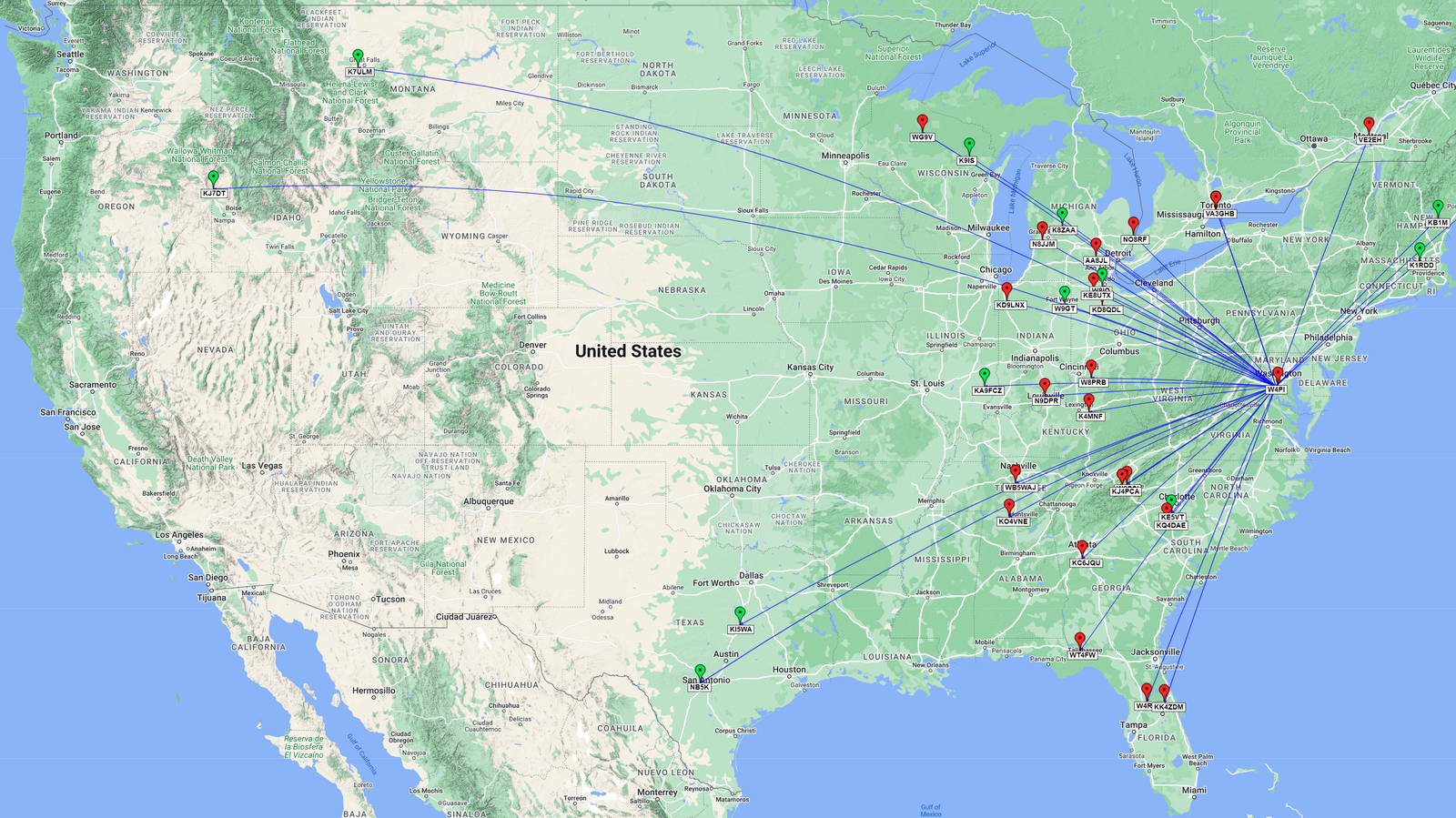
Domestic Activation QSO Map: Green Pins = CW, Red Pins = SSB / Blue Lines = 20m
Stop 2 (Park 5): A New (to us) Park at Oxon Cove Park & Farm National Historic Park in Maryland
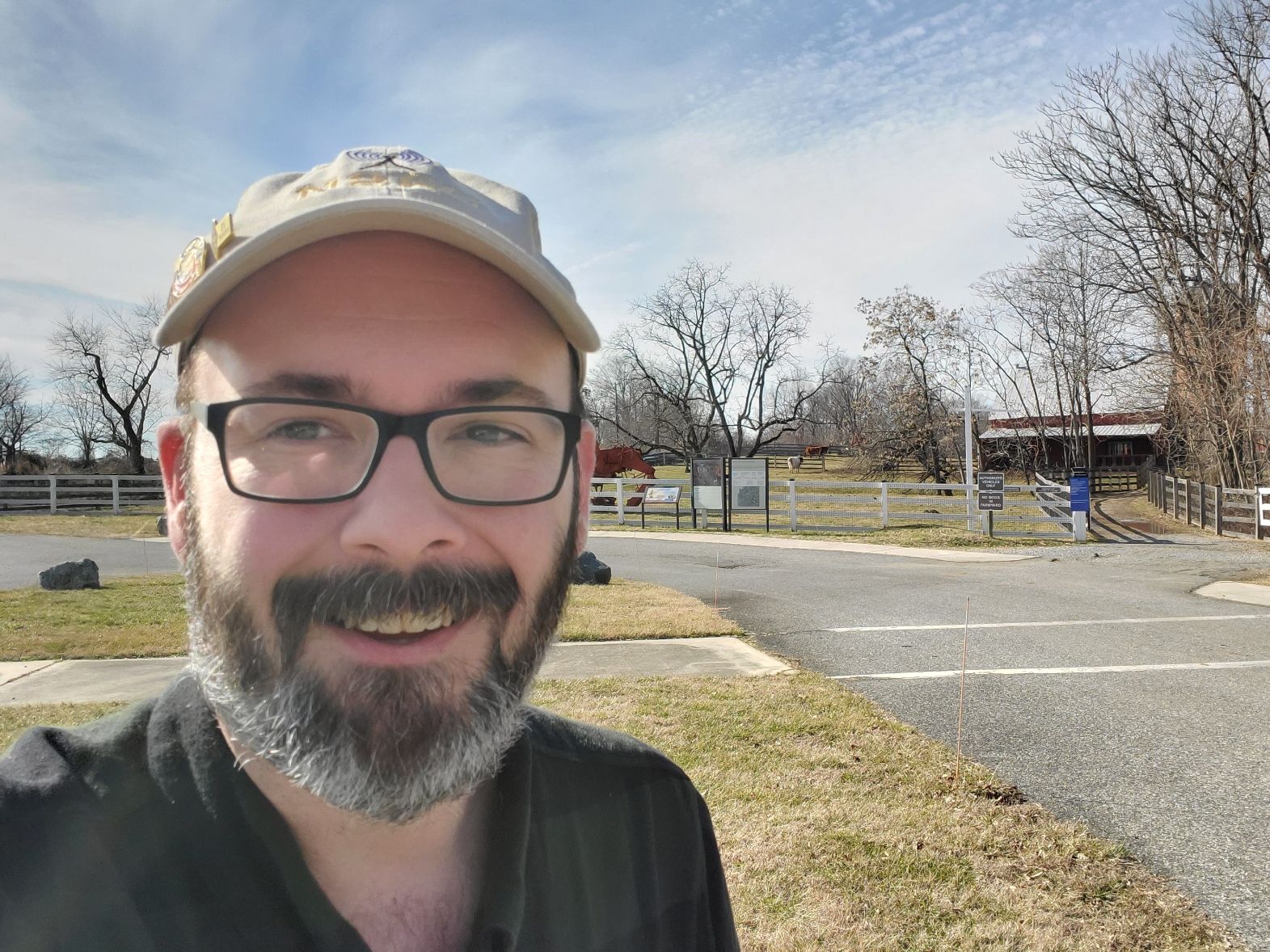
This stop was a park that I had never activated before, despite being one of the closest ones to my QTH and seemingly ideal for the task. For this rove, it had a nice and mostly empty parking lot, and for fair-weather operations, it had several picnic tables nestled between great antenna supports ... err ... trees. The park itself has a working farm that you can visit, and of course, picnic grounds. It is situated at the top of a large hill ... Oxon Hill ... that overlooks the Potomac. Although, from our operating position we mostly saw the parking lot. This, and the rest of our activations on this day, would be 100% SSB, dual-op pass the mic affairs. We decided to give 10m a go and see what we could do, and almost immediately we were picked up but AF4LL in Arlington, a frequent participant in our local club 2m nets. He was booming in, of course, and was testing out a mobile setup. He just happened to hear us. We chatted for a bit and got him in the log, and then tried calling CQ for a while, but got nothing, so we move down to 12m.
On 12, we got a park to park contact with Texas, almost right away, but then we got nothing for about 10 minutes. So we decided to go down to old reliable, 20m. Our first contact was from Spain 55 both ways! It was nice to get EA1GIB into the log again -- he is a frequent hunter and a patient operator. Propagation was certainly working. Next up we got Georgia, Tennessee, Kentucky, Quebec, a pair from Indiana, a pair from Minnesota, Georgia, Michigan, Florida, Alabama, Indiana, Ontario (Canada), Florida, Wisconsin, Alabama, Minnesota, New York Mississippi, a pair from Georgia, and another Mississippi before we looked at the clock and realized we'd have to move on soon. All In all we had 26 contacts in 47 minutes on SSB including our across-the-pond DX. We also had made the first minimum for a Rover award at 5 parks. That said, we weren't content to stay there, so we drove off to our next park.

International Activation QSO Map: Red Pins = SSB / Blue Lines = 20m, Pink Lines = 12m, Yellow Lines = 10m
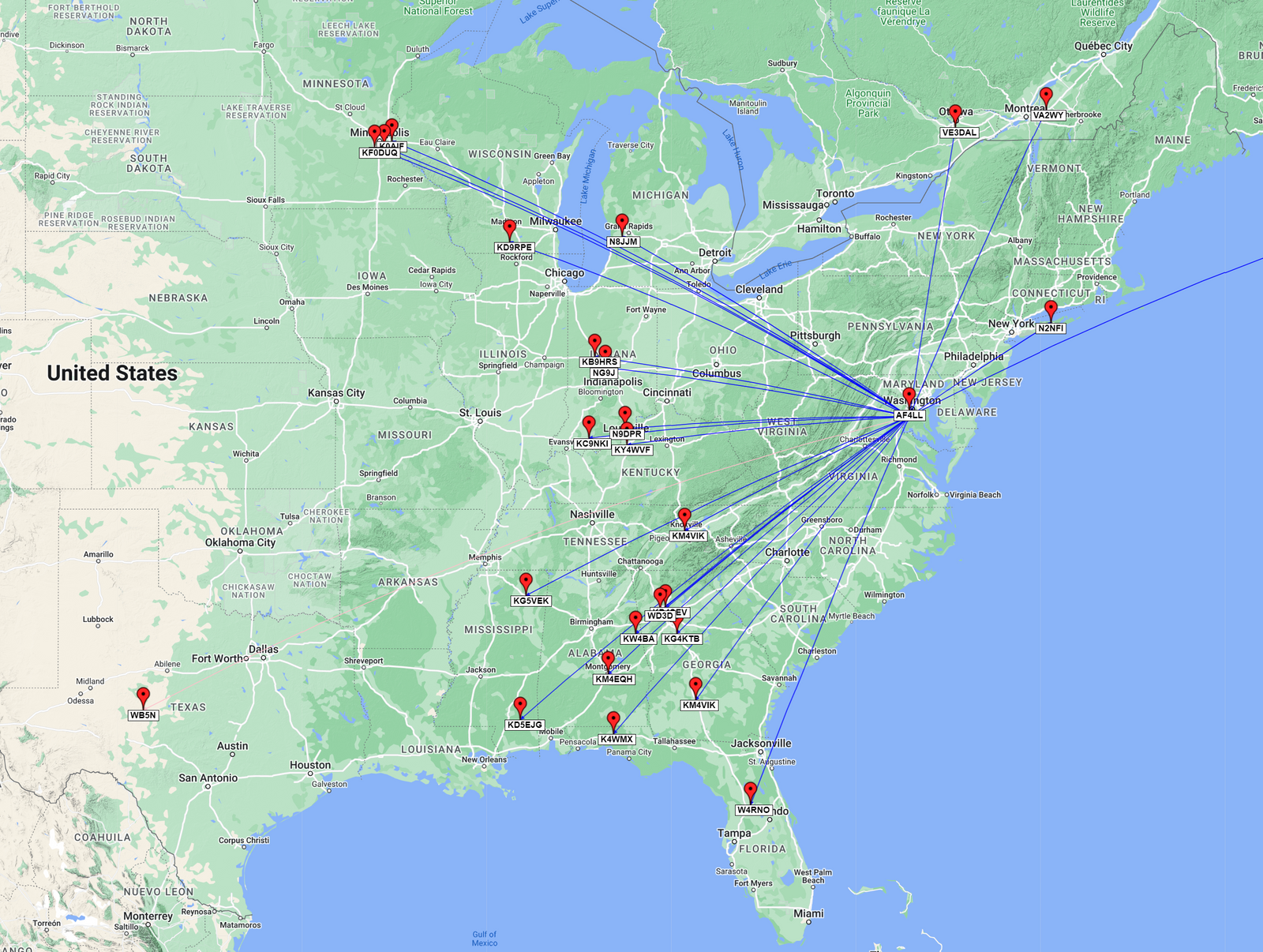
Domestic Activation QSO Map: Red Pins = SSB / Blue Lines = 20m, Pink Lines = 12m, Yellow Lines = 10m
Stop 3 (Park 6) : Fort Washington Park in Maryland
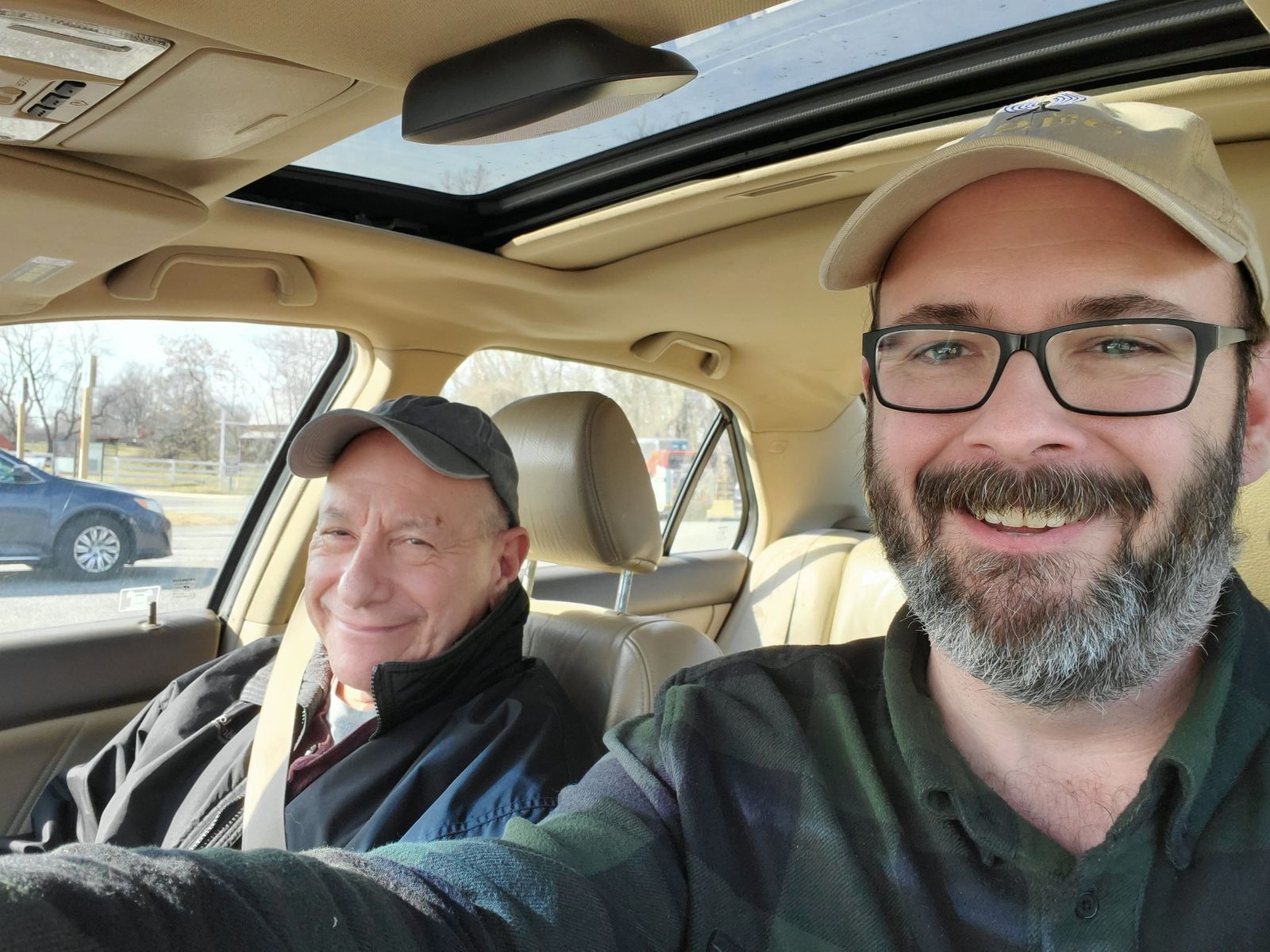
Our initial plan was to stop at Harmony Hall National Heritage Site, a place that I had not ever visited. When we got there, the gate was closed, so there was no way for us to drive onto the property. Since we didn't have a portable setup with us, we decided to move in to the next park on our list: Fort Washington Park. I had done a previous activation portable with great success, and I have been to the park several times to visit the fortifications as well as to picnic with friends for some fair weather barbecues. Gersohn and I elected to setup in the parking area at the top of the park with an eye toward the best position for the RF, even if it wasn't the best position for the views.
We started out on 20m SSB and were able to make a quick park to park contact with an activator in Tennessee, but the band was super crowded. We had stations on either side of us giving is QRM at S7-S9 levels, so we decided to take refuge in the WARC bands, specifically a perennial favorite of ours, the 17m band. Immediately it was clear we had a pipeline to Missouri as we got a trio of stations from there including a park-to-park contact. That was followed by contacts from Ontario (Canada), Mississippi, Wisconsin, another pair on the Missouri pipeline, another Wisconsin, another Ontario (Canada) and finally a contact from Illinois. 17m was definitely working -- and we'd need that as the day progressed.
In all we got 12 contacts on SSB during this activation in 21 minutes. We were starting to hit our stride and build up a bit of speed. So no stopping us now, we set off for our next stop.
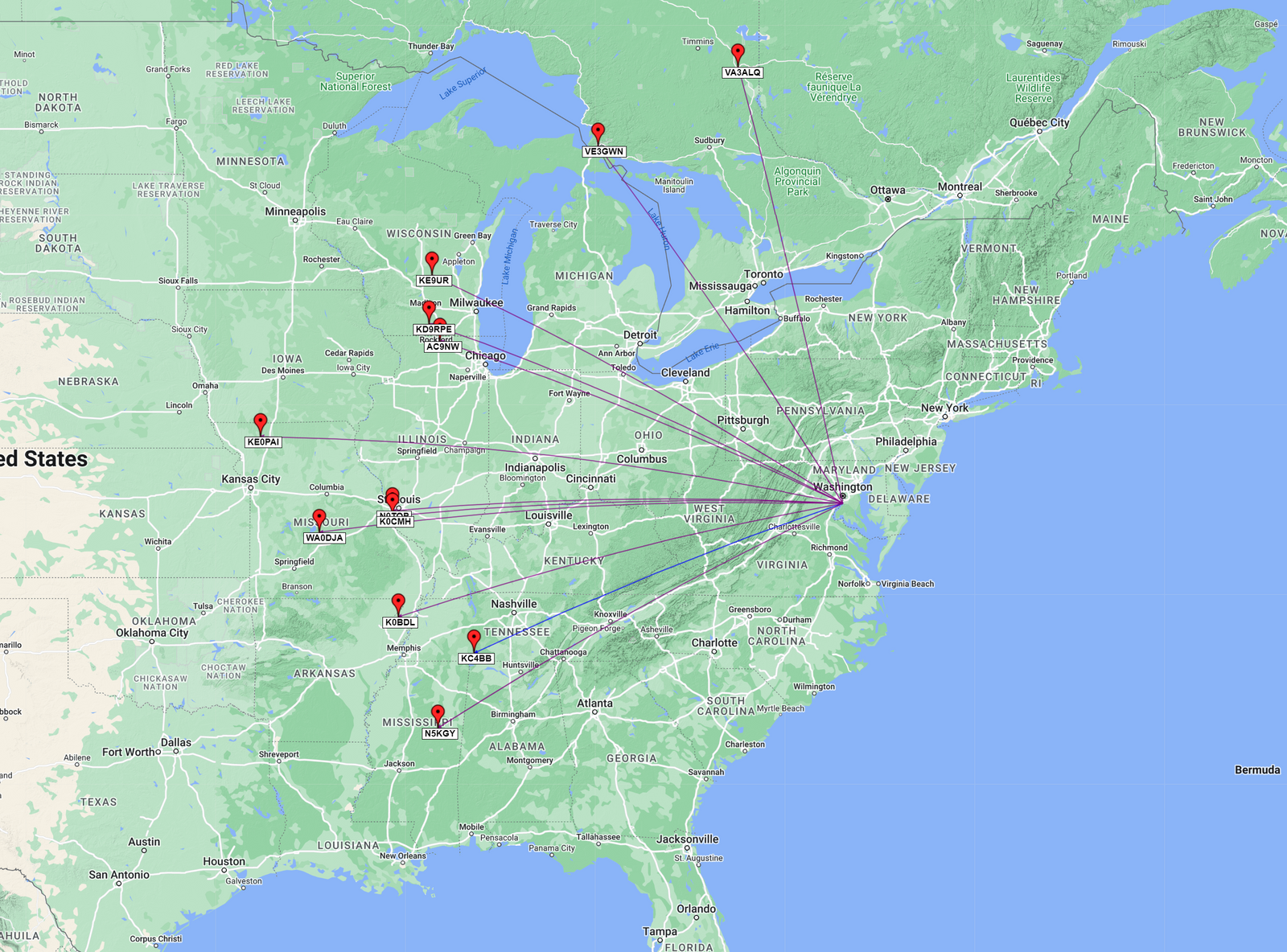
Activation QSO Map: Red Pins = SSB / Blue Lines = 20m, Purple Lines = 17m
Stop 4 (Park 7): Another New (to us) Park at Piscataway Park in Maryland plus Captain John Smith Chesapeake NHT (Maryland) and Star-Spangled Banner NHT (Maryland)
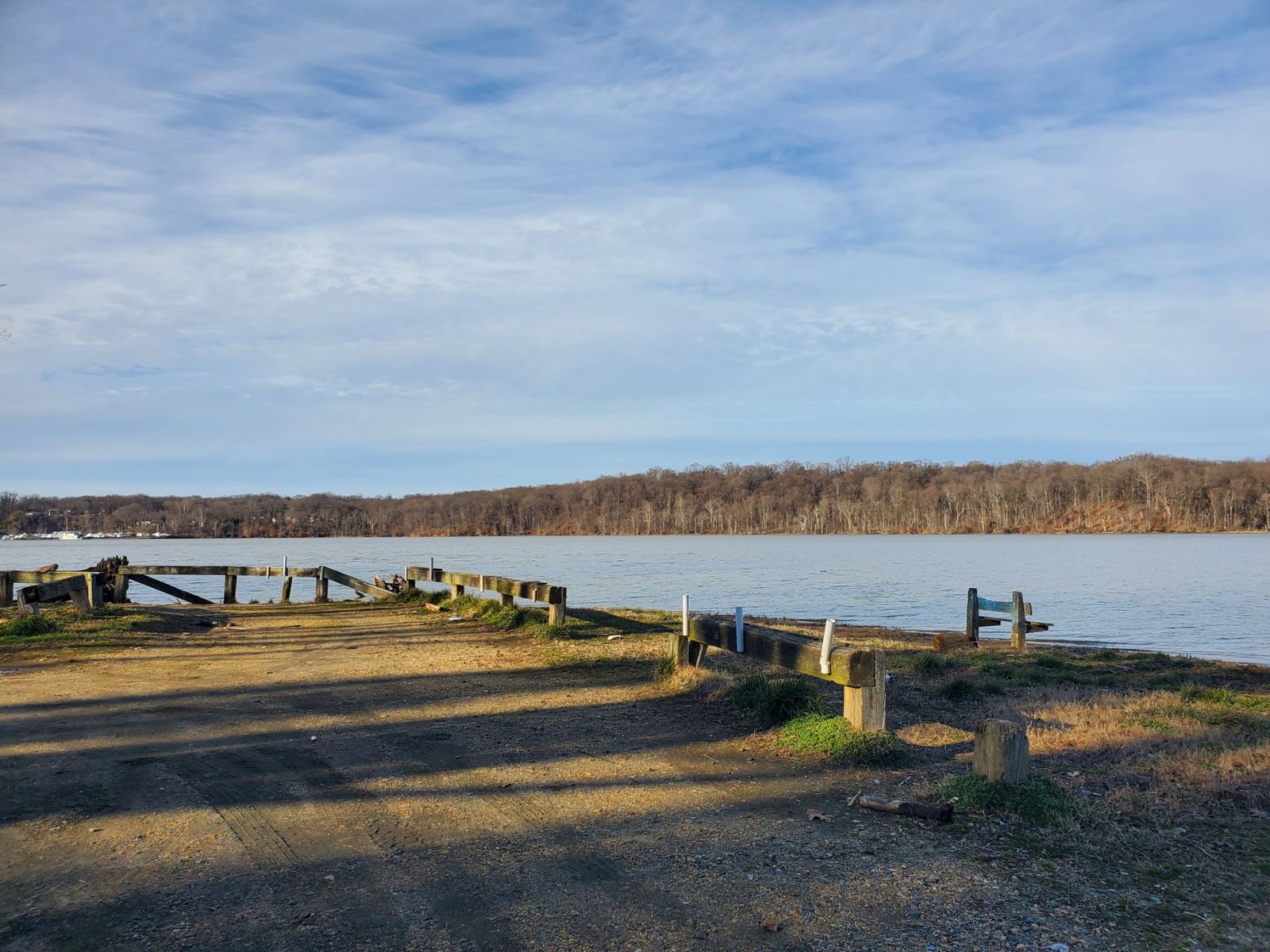
Our next park is one that I have seen numerous times, too many to count, but one that until this day I had never set a foot inside. How was that? Well, a bit of history about Piscataway Park is in order. The park was created in response to the potential for development in the area, which just so happens to be in the viewshed of George Washington's Mount Vernon. Private individuals bought up the parcels and eventually the foundation that managed the land donated it to the National Park service in the 1960s. As a neighbor and member of Mount Vernon, I see it from the Virginia side of the river every time I visit. This would be my first time inside the park. For this visit, we decided to go into the Farmington Landing boat launch which goes right down by the river. So, this activation was a 3-fer, getting the Maryland side of two parks we activated earlier on our first stop, but not adding to our park totals. The view was quite beautiful, and we were very close to the water's edge.
Knowing that the 20m and 40m bands were super crowded, we decided once again to seek refuge in the 17m band. After finding a free space, we started calling CQ and heard back from Florida, followed by a call from the complete opposite direction in Nova Scotia (Canada), then a good way West to Minnesota. Then we got another bit of DX, with a call from South America in Venezuela from YV1GIY. We were definitely getting out and it was exciting to get a third continent in the log for the day. Next up we got another Nova Scotia (Canada) station in the log, followed by another from Minnesota. Next was Idaho, Illinois, Minnesota, and then clear across the continent to British Columbia and VA7HUM who was in an island just off the coast between the mainland and Vancouver Island. We would end up working him again in other parks, too. Next up we heard from Colorado, New Brunswick (Canada), and finally North Dakota before calling QRT and moving on to the next park.
In all, 13 contacts on 17m SSB in 22 minutes. Not bad for a 17m only activation.
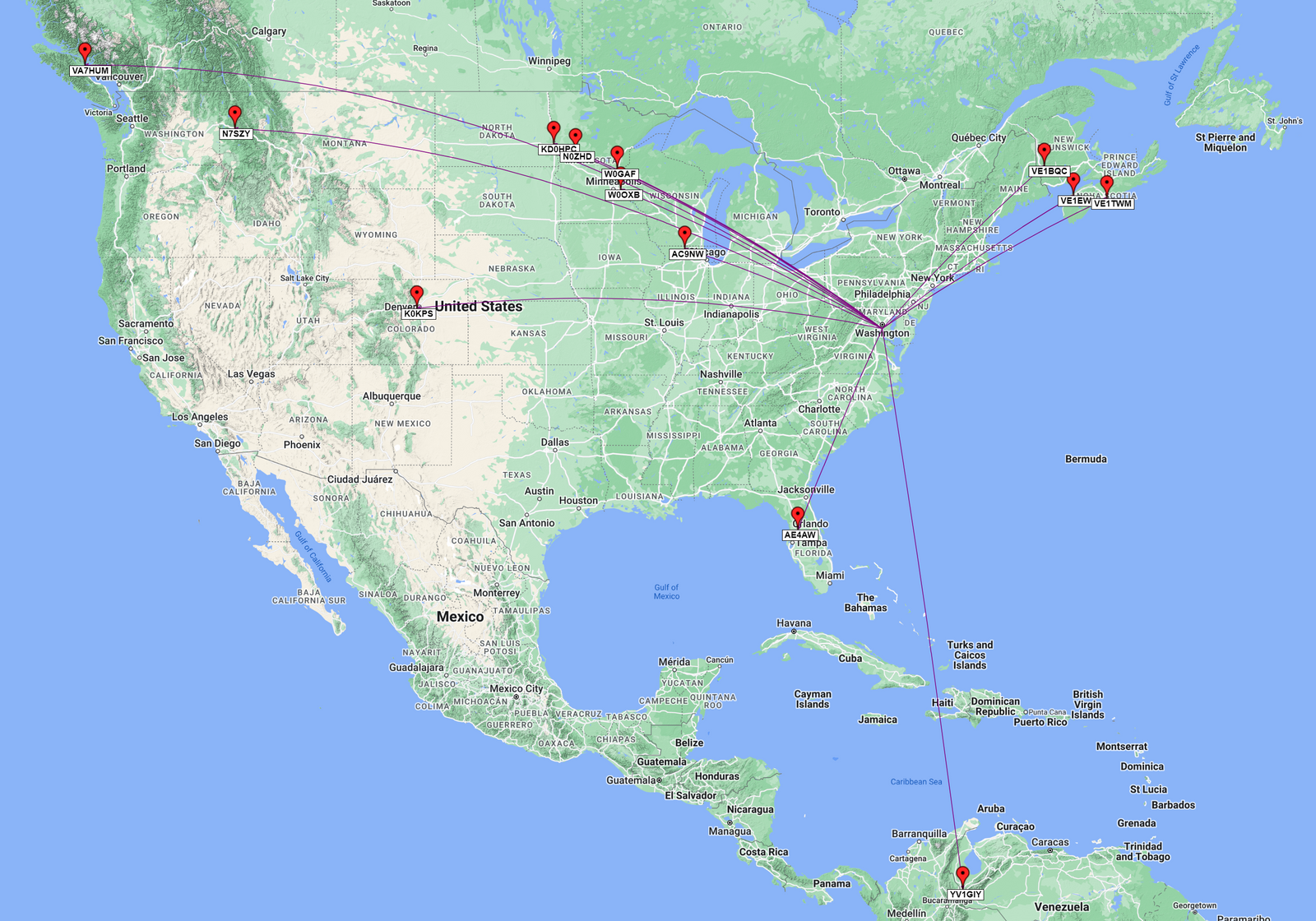
Activation QSO Map: Red Pins = SSB / Purple Lines = 17m
Stop 5 (Park 8): Another New (to us) Park at Smallwood State Park in Maryland plus Captain John Smith Chesapeake NHT (Maryland) and Star-Spangled Banner NHT (Maryland)
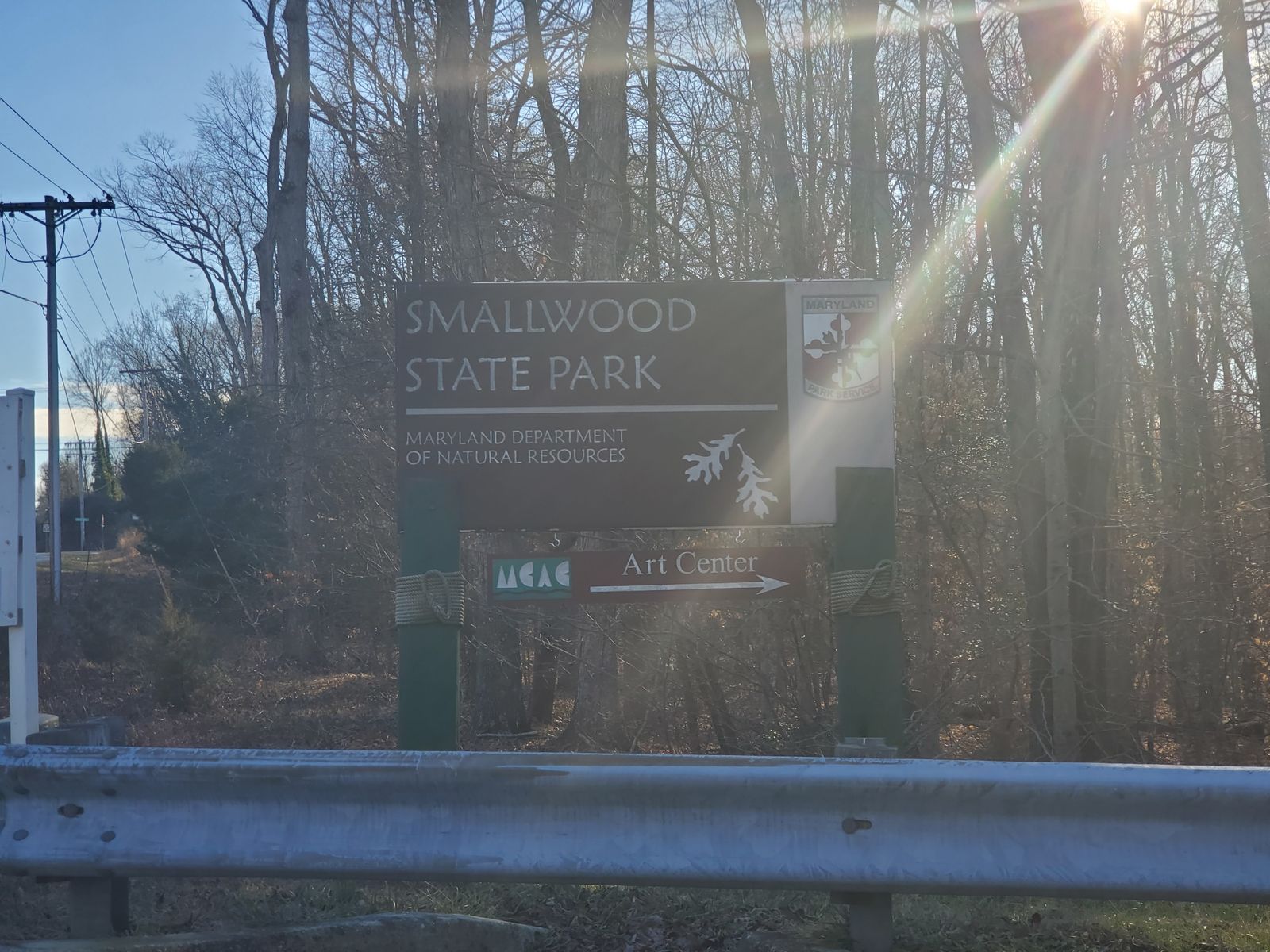
Next up was a Maryland State Park called Smallwood State Park, another one I had never visited before. When we arrived at the entrance station there was nobody at the gate, just a box with envelopes to put a $5 entry fee (less for MD residents) and get a permit hang-tag to put on our rear view. From my research, I saw that there was an art center inside the park that was situated on the banks of the river with a parking lot that would make a nice operating position. Looking at our watches, we had a little over an hour until closing time for the park, but the art center itself was closing within minutes. There were a couple vehicles in the parking lot that would leave while we were operating, so eventually it was just us.
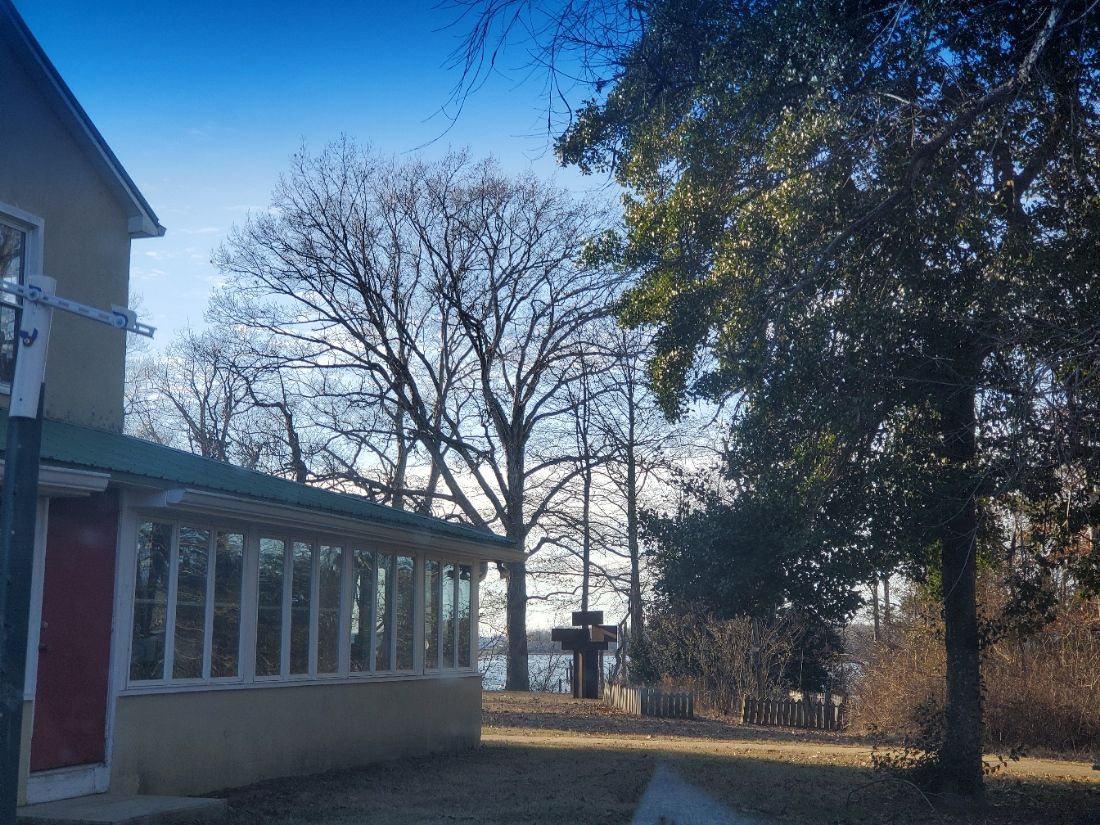
Since we already had the VFO of the radio on the 17m band, we decided to start there and we got replies from Illinois and Mississippi. Unfortunately, the band appeared to die out on us, so after a 6 minute dry spell, we migrated over to 20m to see if we could get the rest of the contacts we'd need to complete the activation. We had a challenge finding a spot, and were surrounded by QRM, but we were able to get through. We heard first from Indiana, then South Carolina, and Wisconsin. Then we got a little Caribbean DX from the Dominican Republic, followed by Michigan, Indiana, Illinois, Alabama, a pair from Indiana, Montana, Michigan, a park to park from Michigan, Georgia, another Georgia this time a park to park, a pair of Florida park to parks, and one last call from Illinois. It was interesting to get all those park to parks and my hypothesis was that with all the Winter Field Day stations, lots of activators were having the same trouble we were finding a space and were resorting to hunting to finish their activations. Glad we were able to get them all in the log.
All-in-all it was a 31 minute activation with 20 contacts on SSB, mostly on 20m with a pair on 17. The sun was starting to get low in the sky, so we moved back on the road with a purpose for our next stop.
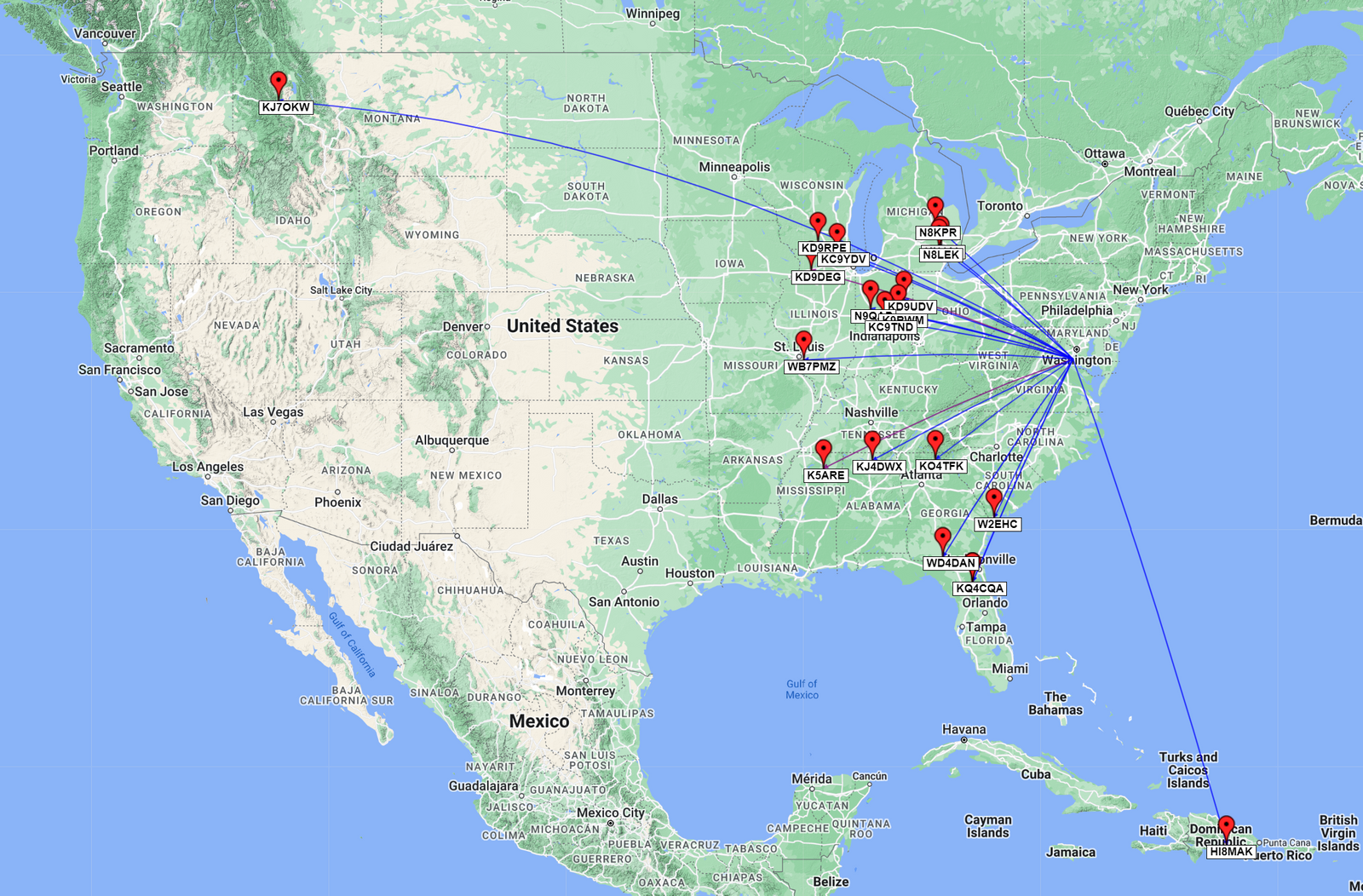
Activation QSO Map: Red Pins = SSB / Blue Lines = 20m, Purple Lines = 17m
Stop 6 (Park 9): Another New (to us) Park at Chicamuxen Wildlife Management Area in Maryland
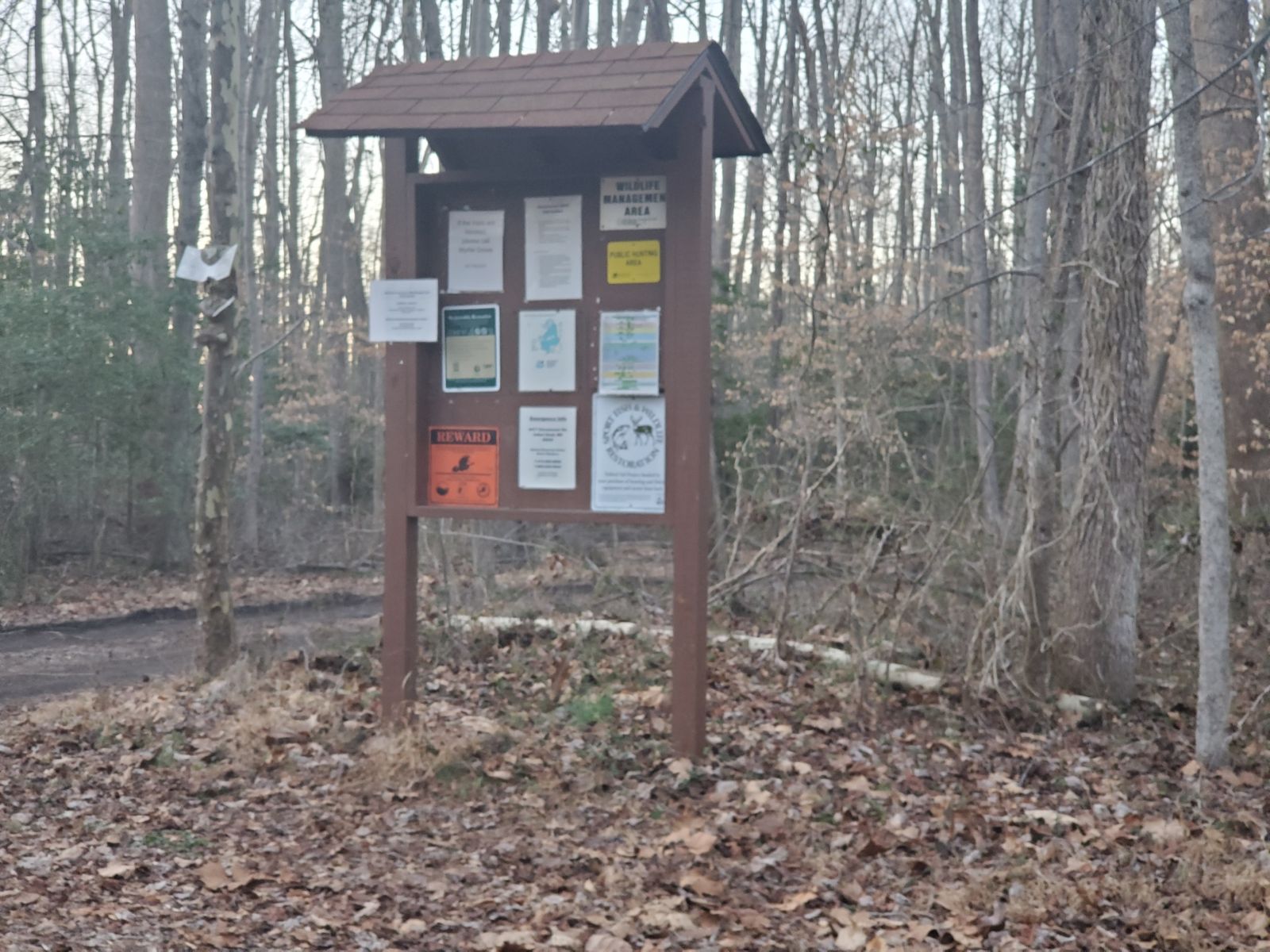
Not too far from our previous park, we saw that the Chicamuxen WMA was pretty close by, so we punched the location into Google Maps and had it navigate us to where it said it could be found. As it turns out, blindly following navigation instructions can be a bit perilous. It took us to a dead end at the Naval Support Facility Indian Head Stump Neck Annex. There was a blocked off bit that seemed to go into the WMA, but we certainly could not drive there, and I'm guessing that the military security would not be interested in us going there either. So it looked like we had a bit of a swing and a miss, so we set up for the next park we had on our list and made all due haste to leave the entrance to the base. As we were on our way, we saw a sign to parking lot/trailhead for the very WMA we had just tried to go to. Would be nice if that was the one listed on Google Maps ... but at least we found it. So we pulled into the parking lot of the trailhead, and got our radio ready to transmit.
Once again the 20 and 40m bands were packed, so we decided to once again use 17m. Things were noticeably quieter on the band, leading me to worry that we might be losing 17m as an activation option. With us using SSB, that meant our only two options would be 20m and 40m ... and those were packed. We might be forced to scrape by on hunting. Considering how our time was drawing short, I hoped we could finish calling CQ. Our first two contacts were from Florida, the first one being a park to park. Our third contact was a park to park in Illinois. Our fourth was a park to park contact in the Dominican Republic. The density of the park to park calls made me think they were in the same boat we were, watching the spots for fresh activations to make their ten. Next up we got calls from Florida, Missouri, Idaho, Arizona, South Dakota, Alabama, Florida, the Dominican Republic, and another from Florida. At the end we ended up having a conversation with the last station about what POTA was. He wasn't familiar with the program, and wondered how it differed from a contest, and why we were on 17m. I explained how you had to be in the park to activate, so it wasn't like a contest in that respect. I also mentioned that the IARU, which came up with the convention of not using the WARC bands for contesting had given their approval to POTA being used on the bands due to it being more akin to a special event station as opposed to a contest one. In the end, I think it was a positive conversation, and he was happy to get into our logs and thanked us for the explanation.
We had made it, 24 minutes on the air and 13 contacts in the log with 3 being park to park. We were now down to our last park to make the 10 rove and had just under 90 minutes to get there and finish the activation. With the bands fading, we weren't sure if we could do it, but there was only one way to find out. Onward we went, back on the road.
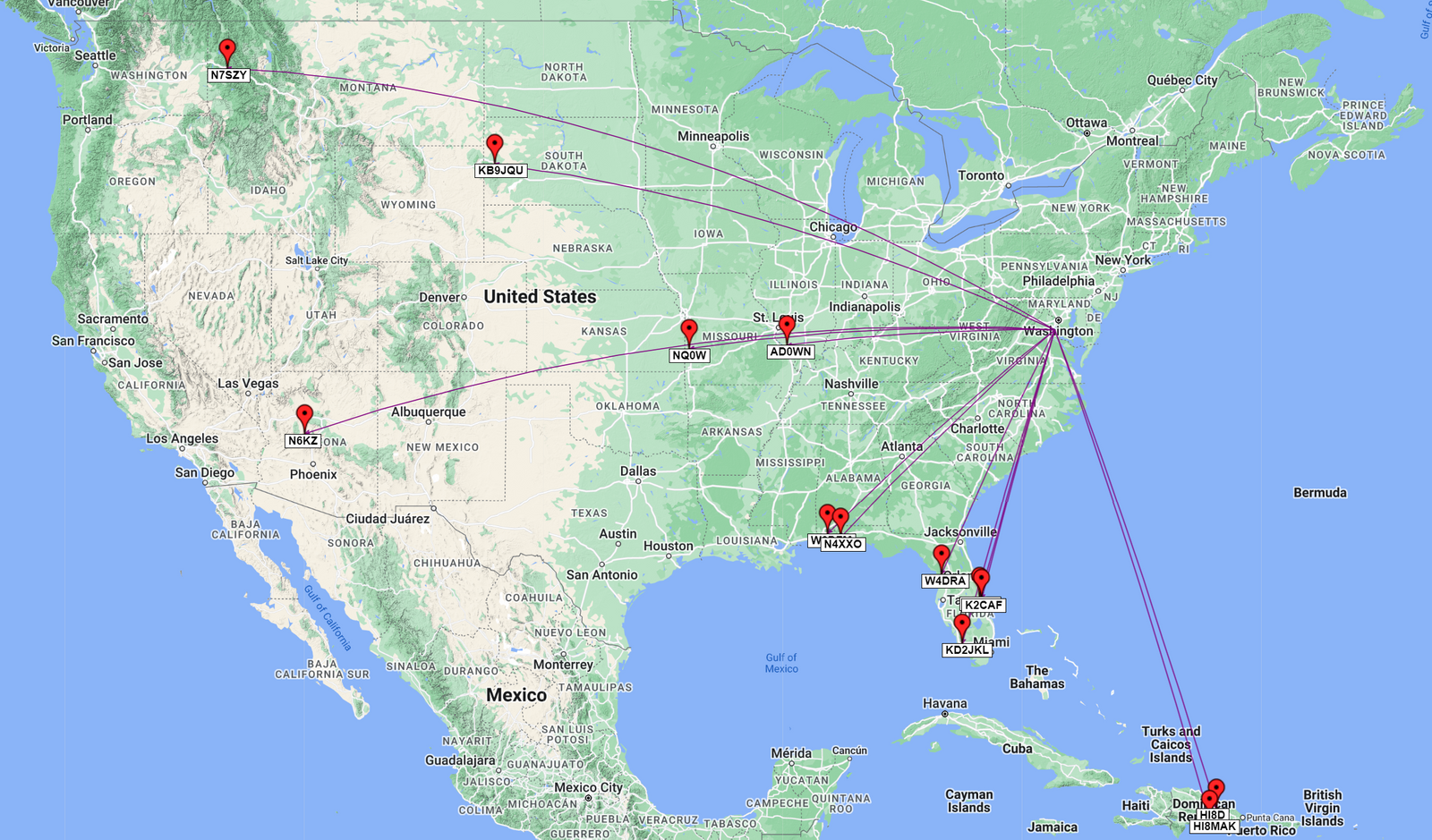
Activation QSO Map: Red Pins = SSB / Purple Lines = 17m
Stop 7 (Park 10): Another New (to us) Park at Ben Doane Parcel of Nanjemoy Wildlife Management Area in Maryland
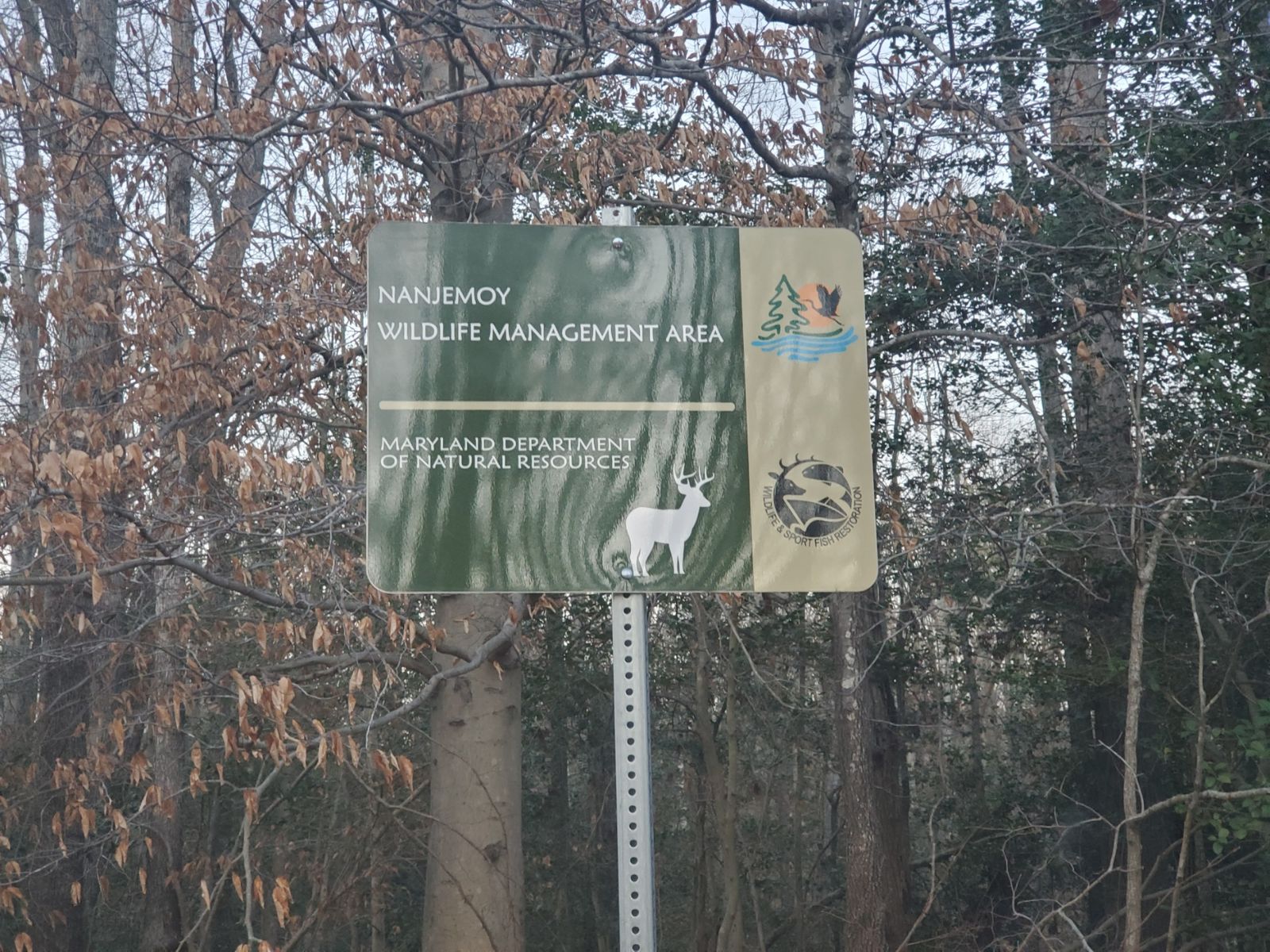
Luckily for us, this last stop was just a couple miles down the road. Similar to Chicamuxen WMA, this was a parking lot trailhead. This time it was under a power line, so we had a bit of QRN to contend with, but it wasn't terrible. The sun was setting below the trees and the darkness of night was starting to envelop the woods. This was an interesting parcel of land -- although the sign said Namejoy WMA, POTA saw it was particularly the Ben Doane parcel of that WMA, which had its own reference number. It had not been activated many times in the past, in fact our activations would be numbers #13 and #14. It made me smile to see that #12 was our friend David, KU8V. MVARC members were responsible for over 21% of all activations, how cool is that?
Once again, we didn't have any luck finding room on 40m and 20m, so with no small amount of trepidation, we gave another try to 17m hoping that we would be able to make our 10. We tuned up the ATAS 120A and hoped that propagation would be in our favor for at least 10 contacts. Here we go. After calling CQ for a while we got our first contact with a station we worked just a half hour before at our last park from Florida. Next after a couple minutes of silence we heard from Minnesota. Then more silence followed by a contact from Illinois. We kept calling for 4 minutes and then got a contact with Florida followed by crickets. We were starting to worry we may need to get some hunting into the mix to close this thing down, but we kept calling. Next we had a weak station from Arkansas who we heard 52 and who heard us 44, but he stuck with it and we got him in the log for a park to park. Following that we were able to work a Nevada station who came in strong for us at 57, but heard us 44. We were grateful for him sticking with us to make the contact. Shortly thereafter we heard VA7HUM off the coast of British Columbia who worked us once again, we were ecstatic to hear him come through and while he was 57 to us, we were 45 to him, but he graciously worked us both for another contact at another park across the continent. 7 down, 3 to go.
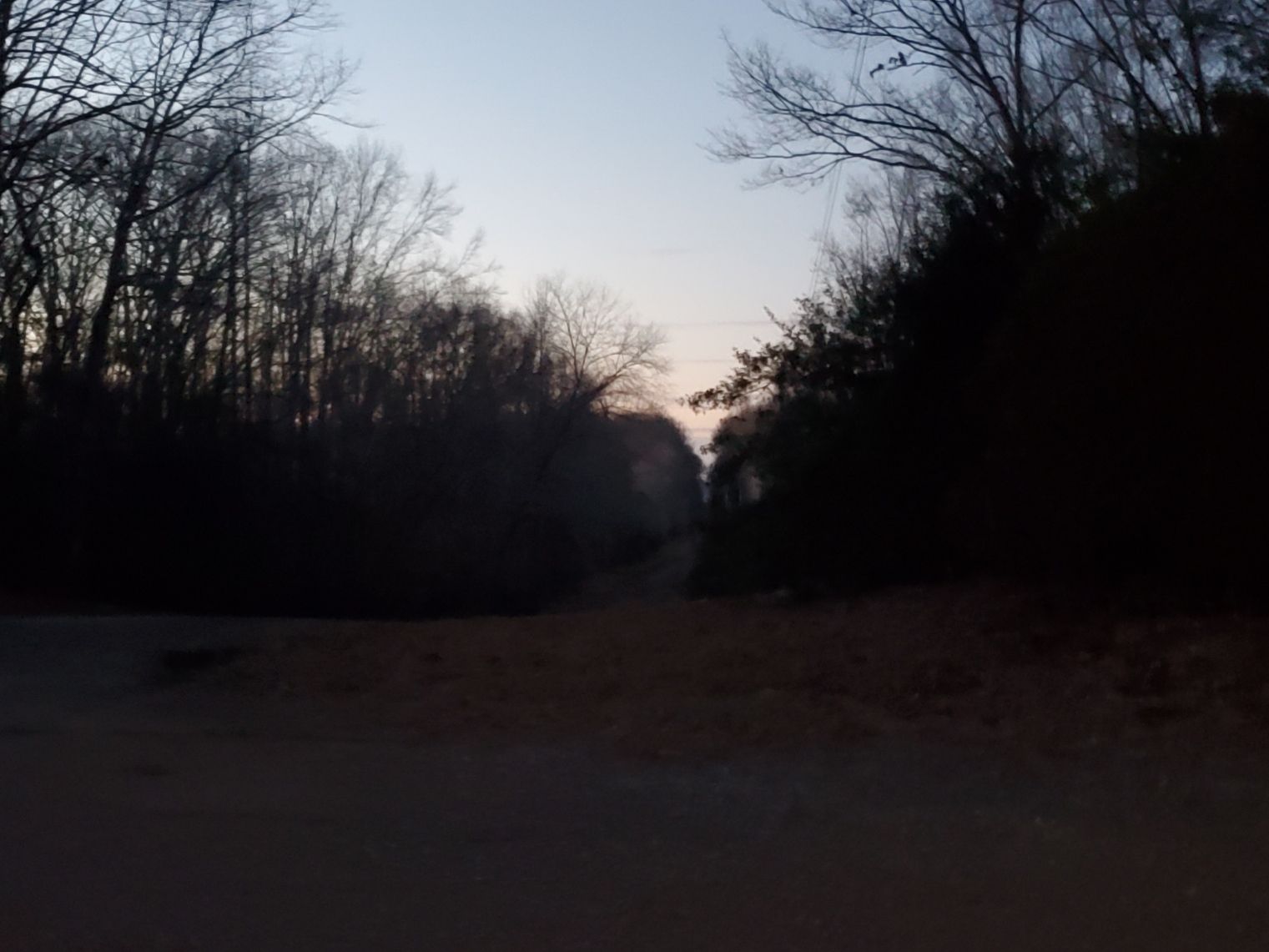
"CQ POTA, CQ POTA, this is November Two Echo Charlie at Park Kilo Seven Seven Eight Two for Parks on the Air". Over and over I repeated that refrain for 6 minutes with no response until finally a station in Texas gave us a contact at 55 both ways. Shortly after that we heard a station in North Dakota come back to us, also 55 both ways. Almost there. We called again and again and then finally at 22:53Z we got a final contact with a station in New Mexico! He was 55 to us but we were 33 to him. When we gave our 73s we had 10 contacts in the log. I usually like to have an insurance contact in there, just in case, so I kept calling for a bit, but nothing was heard. Looking out my car window I saw that sun had set down behind the dirt road just beyond our operating position. Undoubtedly, the charged particles in the ionosphere had taken notice and 17 was done for us for the evening. With 10 contacts in the log here, and 10 parks activated for the day, we had met our goal with 67 minutes to spare. Rhino rove complete.
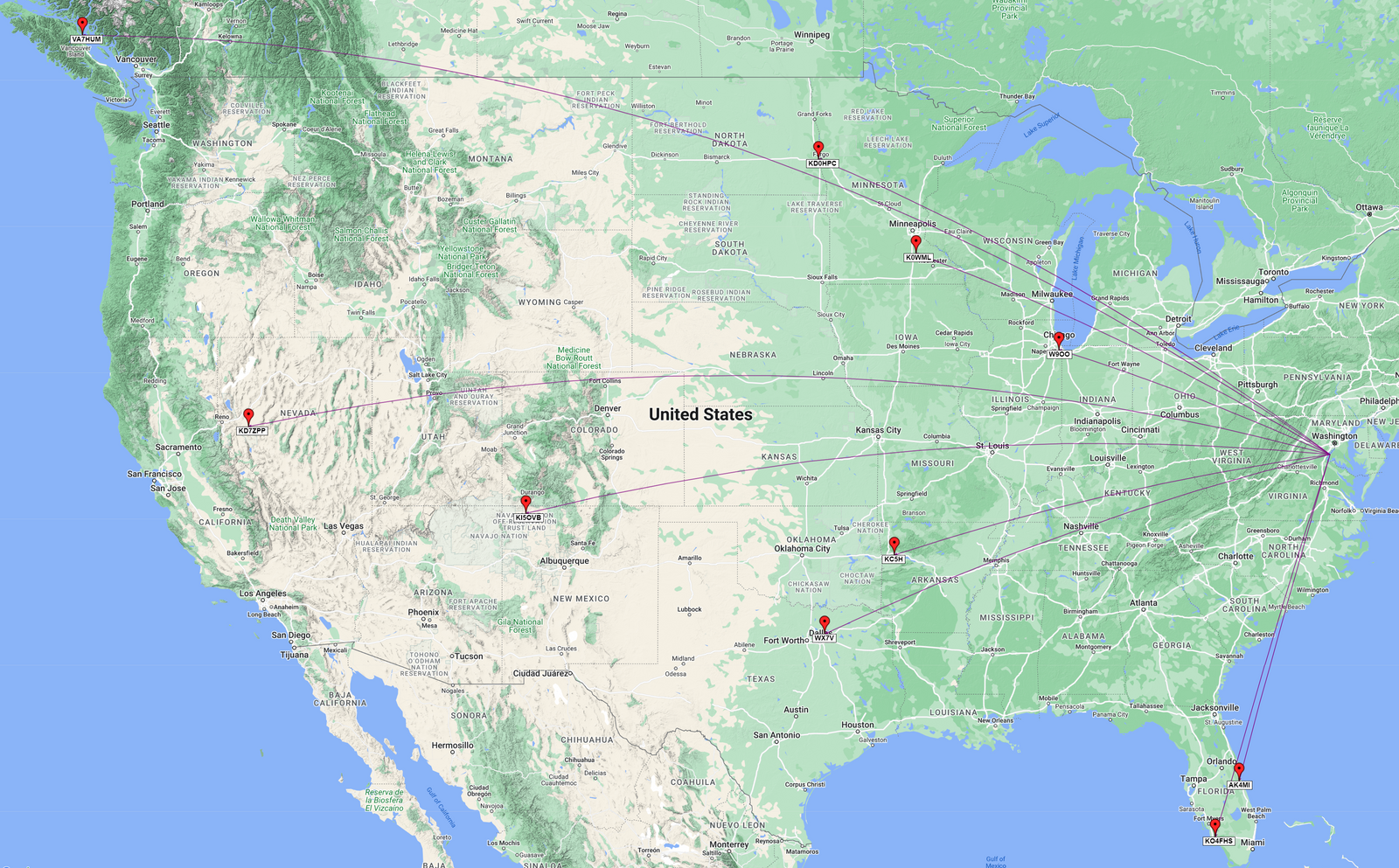
Activation QSO Map: Red Pins = SSB / Purple Lines = 17m
Successful POTA Rhino Rove: 10 Parks in 1 Day for 2 Operators
By the time we called QRT for the last time, we were tired and hungry, having skipped lunch in all the excitement. But we were happy that we were able to complete the rove successfully. We had made a total of 168 contacts in 10 parks for the day with 12 of those on CW and 156 on SSB. Due to the 3-fer and the 4-fer, for POTA the total count when adjusted for multiple parks was 308 total contacts with 260 on SSB and 48 on CW. We contacted stations in the United States, Canada, the Dominican Republic, Venezuela, Spain, and Poland, while activating from the Commonwealth of Virginia and the State of Maryland. A very successful day in the parks.
What would I do differently next time? I probably would not activate during a contest weekend, for one. Not being able to use 20m and 40m definitely slowed our rate considerably. I also would get an earlier start, so we would not be getting so close to the end of the Zulu day. Also, while I enjoy setting up in a park and activating for as long as I can, for a rove, that's not a winning strategy. If I do something like this again, I definitely need to keep the activations quick, and the transitions efficient.
This was a lot of fun. I really enjoyed spending the day with my buddy Gersohn and stretching ourselves to reach a challenging goal. Who knows, maybe another rove may be in the cards someday. The overall activation maps for the entire day are below.
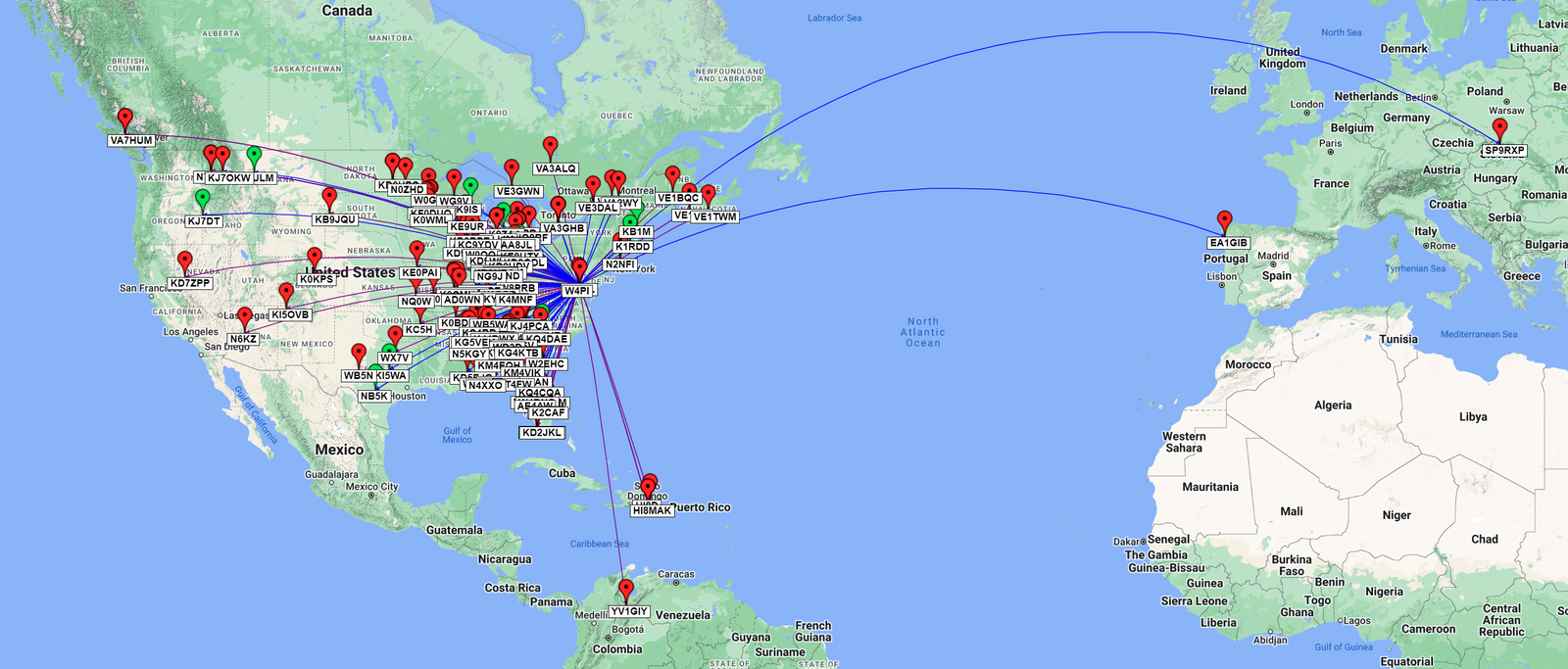
Overall International Activation QSO Map: Red Pins = SSB , Green Pins = CW / Blue Lines = 20m, Purple Lines = 17m, Pink Lines = 12m, Yellow Lines = 10m
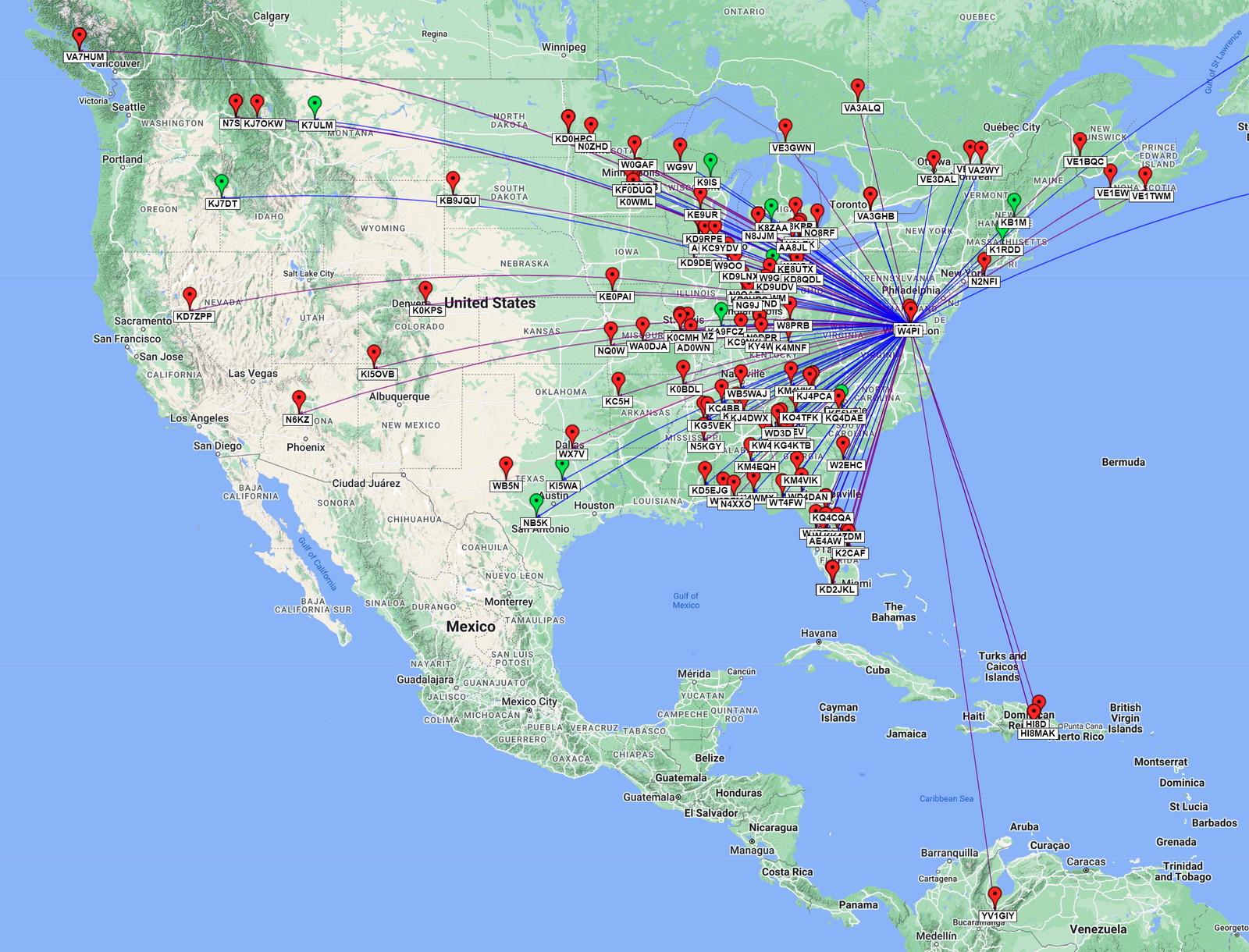
Overall Domestic Activation QSO Map: Red Pins = SSB , Green Pins = CW / Blue Lines = 20m, Purple Lines = 17m, Pink Lines = 12m, Yellow Lines = 10m
Gear used in this activation
- Yaesu FT-891
- Yaesu ATAS 120A Antenna
- CW Morse SP4 POTA/SOTA Mini Morse Code Magnetic Paddle (N0SA Designed)
- 2006 Honda Accord EX V6
- Samsung Galaxy S10+
- HAMRS Logging App
Posted on January 30th, 2023

